Factors Influencing Bank Selection
VerifiedAdded on 2020/01/28
|45
|10074
|37
Survey and Questionnaire
AI Summary
This assignment examines the factors that influence individuals' decisions when selecting a bank. It delves into the importance of convenience, interest rates, workforce quality, and physical environment. Participants are asked to evaluate their preferences for specific banks (HSBC, Lloyds, Barclays, Standard Chartered) and assess the effectiveness of financial ratios in demonstrating a bank's true picture. The assignment further investigates whether financial indicators guide investment decisions and explores potential issues faced when using financial ratios for decision-making.
Contribute Materials
Your contribution can guide someone’s learning journey. Share your
documents today.

How the financial ratios and performance
affects the Customers of the banking
industry in the greater London
affects the Customers of the banking
industry in the greater London
Secure Best Marks with AI Grader
Need help grading? Try our AI Grader for instant feedback on your assignments.

ACKNOWLEDGEMENT
First and foremost, I would like to express my gratitude to my mentor who has assisted
me in providing knowledge and enough support for carrying out the research in an effective
manner. Next in the series, I would like to thank my friends, colleagues and family members
who have assisted me at every stage of thesis. With their support, I was able to complete my
dissertation effectually. Lastly, I would also like to acknowledge my team members who have
helped me in gathering information and analyzing it later.
First and foremost, I would like to express my gratitude to my mentor who has assisted
me in providing knowledge and enough support for carrying out the research in an effective
manner. Next in the series, I would like to thank my friends, colleagues and family members
who have assisted me at every stage of thesis. With their support, I was able to complete my
dissertation effectually. Lastly, I would also like to acknowledge my team members who have
helped me in gathering information and analyzing it later.
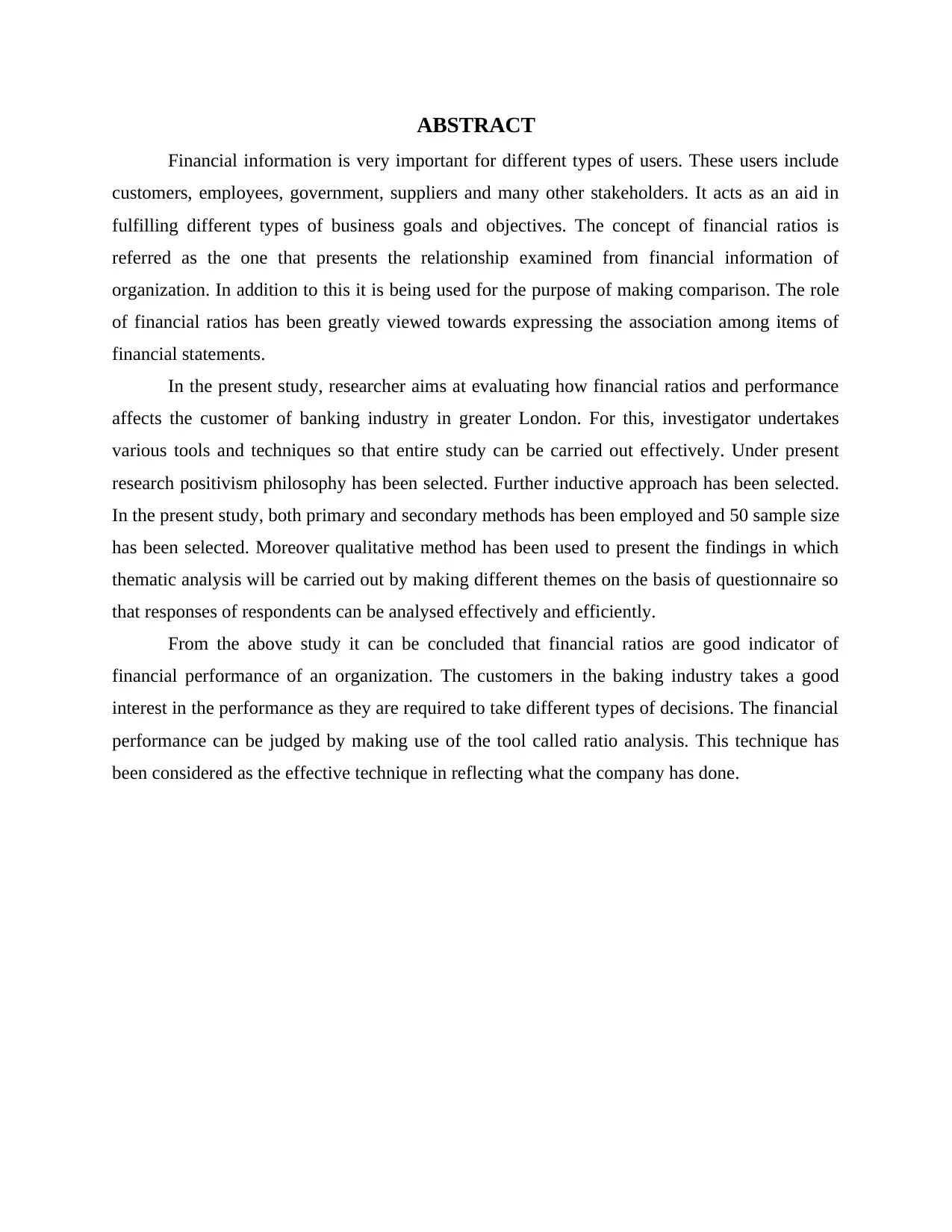
ABSTRACT
Financial information is very important for different types of users. These users include
customers, employees, government, suppliers and many other stakeholders. It acts as an aid in
fulfilling different types of business goals and objectives. The concept of financial ratios is
referred as the one that presents the relationship examined from financial information of
organization. In addition to this it is being used for the purpose of making comparison. The role
of financial ratios has been greatly viewed towards expressing the association among items of
financial statements.
In the present study, researcher aims at evaluating how financial ratios and performance
affects the customer of banking industry in greater London. For this, investigator undertakes
various tools and techniques so that entire study can be carried out effectively. Under present
research positivism philosophy has been selected. Further inductive approach has been selected.
In the present study, both primary and secondary methods has been employed and 50 sample size
has been selected. Moreover qualitative method has been used to present the findings in which
thematic analysis will be carried out by making different themes on the basis of questionnaire so
that responses of respondents can be analysed effectively and efficiently.
From the above study it can be concluded that financial ratios are good indicator of
financial performance of an organization. The customers in the baking industry takes a good
interest in the performance as they are required to take different types of decisions. The financial
performance can be judged by making use of the tool called ratio analysis. This technique has
been considered as the effective technique in reflecting what the company has done.
Financial information is very important for different types of users. These users include
customers, employees, government, suppliers and many other stakeholders. It acts as an aid in
fulfilling different types of business goals and objectives. The concept of financial ratios is
referred as the one that presents the relationship examined from financial information of
organization. In addition to this it is being used for the purpose of making comparison. The role
of financial ratios has been greatly viewed towards expressing the association among items of
financial statements.
In the present study, researcher aims at evaluating how financial ratios and performance
affects the customer of banking industry in greater London. For this, investigator undertakes
various tools and techniques so that entire study can be carried out effectively. Under present
research positivism philosophy has been selected. Further inductive approach has been selected.
In the present study, both primary and secondary methods has been employed and 50 sample size
has been selected. Moreover qualitative method has been used to present the findings in which
thematic analysis will be carried out by making different themes on the basis of questionnaire so
that responses of respondents can be analysed effectively and efficiently.
From the above study it can be concluded that financial ratios are good indicator of
financial performance of an organization. The customers in the baking industry takes a good
interest in the performance as they are required to take different types of decisions. The financial
performance can be judged by making use of the tool called ratio analysis. This technique has
been considered as the effective technique in reflecting what the company has done.
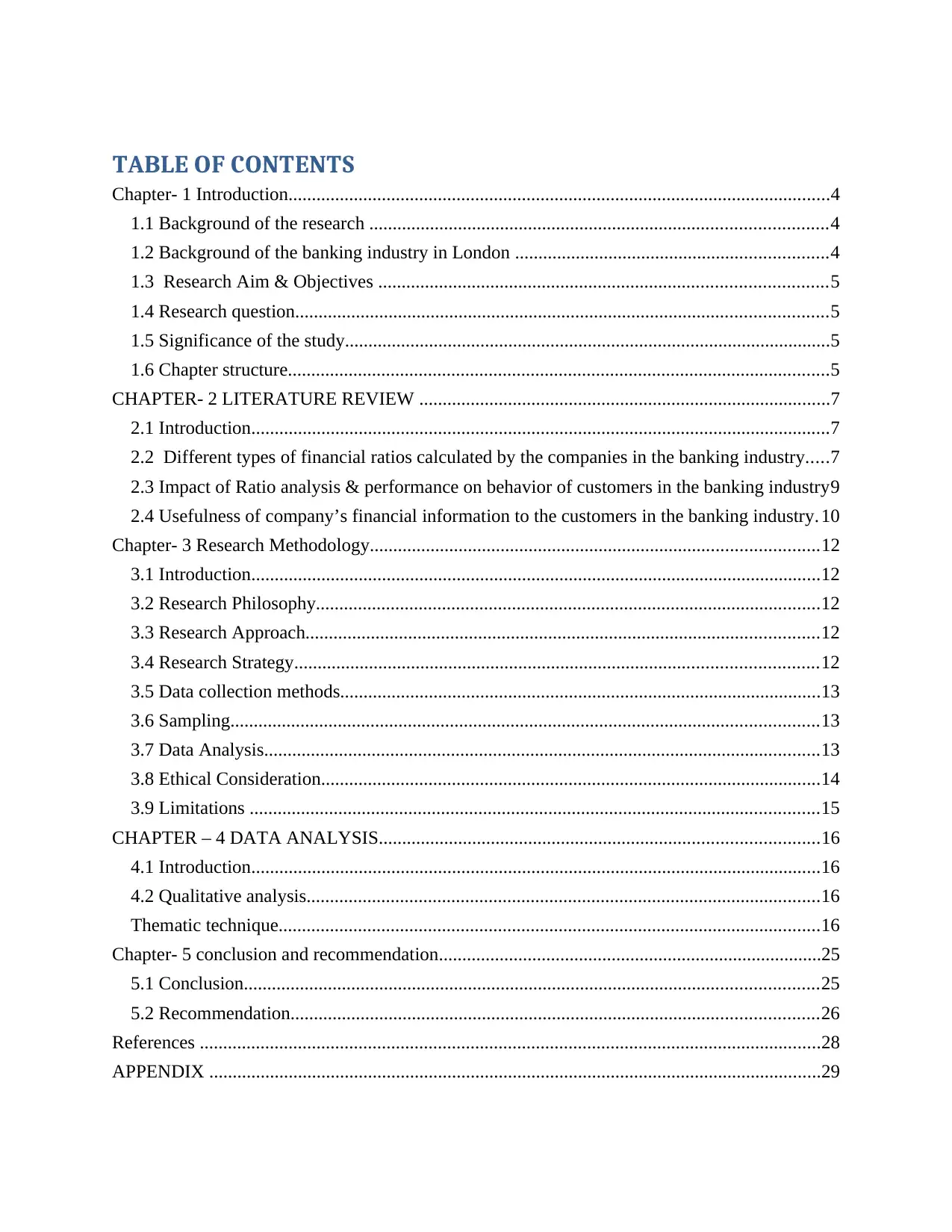
TABLE OF CONTENTS
Chapter- 1 Introduction....................................................................................................................4
1.1 Background of the research ..................................................................................................4
1.2 Background of the banking industry in London ...................................................................4
1.3 Research Aim & Objectives ................................................................................................5
1.4 Research question..................................................................................................................5
1.5 Significance of the study........................................................................................................5
1.6 Chapter structure....................................................................................................................5
CHAPTER- 2 LITERATURE REVIEW ........................................................................................7
2.1 Introduction............................................................................................................................7
2.2 Different types of financial ratios calculated by the companies in the banking industry.....7
2.3 Impact of Ratio analysis & performance on behavior of customers in the banking industry9
2.4 Usefulness of company’s financial information to the customers in the banking industry. 10
Chapter- 3 Research Methodology................................................................................................12
3.1 Introduction..........................................................................................................................12
3.2 Research Philosophy............................................................................................................12
3.3 Research Approach..............................................................................................................12
3.4 Research Strategy................................................................................................................12
3.5 Data collection methods.......................................................................................................13
3.6 Sampling..............................................................................................................................13
3.7 Data Analysis.......................................................................................................................13
3.8 Ethical Consideration...........................................................................................................14
3.9 Limitations ..........................................................................................................................15
CHAPTER – 4 DATA ANALYSIS..............................................................................................16
4.1 Introduction..........................................................................................................................16
4.2 Qualitative analysis..............................................................................................................16
Thematic technique....................................................................................................................16
Chapter- 5 conclusion and recommendation..................................................................................25
5.1 Conclusion...........................................................................................................................25
5.2 Recommendation.................................................................................................................26
References .....................................................................................................................................28
APPENDIX ...................................................................................................................................29
Chapter- 1 Introduction....................................................................................................................4
1.1 Background of the research ..................................................................................................4
1.2 Background of the banking industry in London ...................................................................4
1.3 Research Aim & Objectives ................................................................................................5
1.4 Research question..................................................................................................................5
1.5 Significance of the study........................................................................................................5
1.6 Chapter structure....................................................................................................................5
CHAPTER- 2 LITERATURE REVIEW ........................................................................................7
2.1 Introduction............................................................................................................................7
2.2 Different types of financial ratios calculated by the companies in the banking industry.....7
2.3 Impact of Ratio analysis & performance on behavior of customers in the banking industry9
2.4 Usefulness of company’s financial information to the customers in the banking industry. 10
Chapter- 3 Research Methodology................................................................................................12
3.1 Introduction..........................................................................................................................12
3.2 Research Philosophy............................................................................................................12
3.3 Research Approach..............................................................................................................12
3.4 Research Strategy................................................................................................................12
3.5 Data collection methods.......................................................................................................13
3.6 Sampling..............................................................................................................................13
3.7 Data Analysis.......................................................................................................................13
3.8 Ethical Consideration...........................................................................................................14
3.9 Limitations ..........................................................................................................................15
CHAPTER – 4 DATA ANALYSIS..............................................................................................16
4.1 Introduction..........................................................................................................................16
4.2 Qualitative analysis..............................................................................................................16
Thematic technique....................................................................................................................16
Chapter- 5 conclusion and recommendation..................................................................................25
5.1 Conclusion...........................................................................................................................25
5.2 Recommendation.................................................................................................................26
References .....................................................................................................................................28
APPENDIX ...................................................................................................................................29
Secure Best Marks with AI Grader
Need help grading? Try our AI Grader for instant feedback on your assignments.
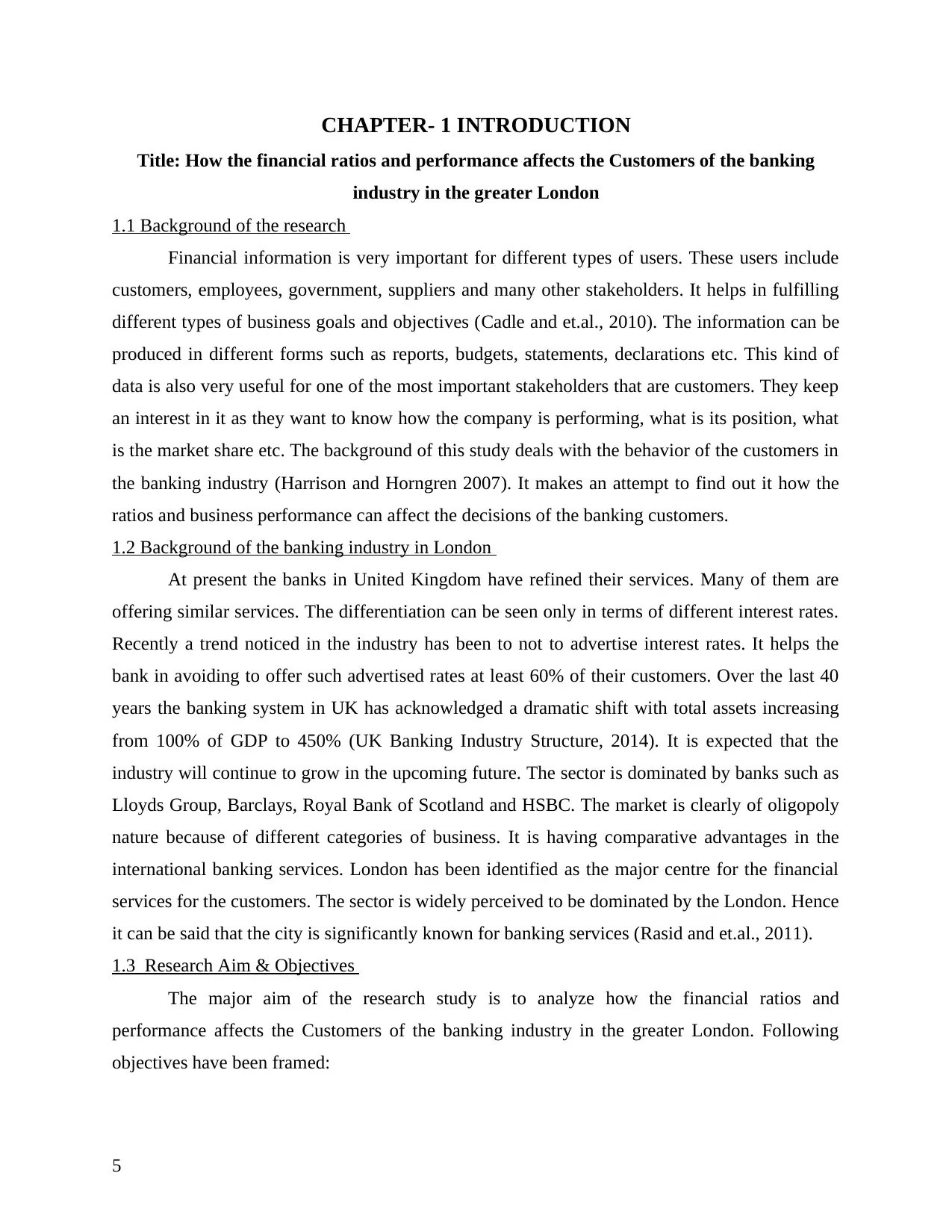
CHAPTER- 1 INTRODUCTION
Title: How the financial ratios and performance affects the Customers of the banking
industry in the greater London
1.1 Background of the research
Financial information is very important for different types of users. These users include
customers, employees, government, suppliers and many other stakeholders. It helps in fulfilling
different types of business goals and objectives (Cadle and et.al., 2010). The information can be
produced in different forms such as reports, budgets, statements, declarations etc. This kind of
data is also very useful for one of the most important stakeholders that are customers. They keep
an interest in it as they want to know how the company is performing, what is its position, what
is the market share etc. The background of this study deals with the behavior of the customers in
the banking industry (Harrison and Horngren 2007). It makes an attempt to find out it how the
ratios and business performance can affect the decisions of the banking customers.
1.2 Background of the banking industry in London
At present the banks in United Kingdom have refined their services. Many of them are
offering similar services. The differentiation can be seen only in terms of different interest rates.
Recently a trend noticed in the industry has been to not to advertise interest rates. It helps the
bank in avoiding to offer such advertised rates at least 60% of their customers. Over the last 40
years the banking system in UK has acknowledged a dramatic shift with total assets increasing
from 100% of GDP to 450% (UK Banking Industry Structure, 2014). It is expected that the
industry will continue to grow in the upcoming future. The sector is dominated by banks such as
Lloyds Group, Barclays, Royal Bank of Scotland and HSBC. The market is clearly of oligopoly
nature because of different categories of business. It is having comparative advantages in the
international banking services. London has been identified as the major centre for the financial
services for the customers. The sector is widely perceived to be dominated by the London. Hence
it can be said that the city is significantly known for banking services (Rasid and et.al., 2011).
1.3 Research Aim & Objectives
The major aim of the research study is to analyze how the financial ratios and
performance affects the Customers of the banking industry in the greater London. Following
objectives have been framed:
5
Title: How the financial ratios and performance affects the Customers of the banking
industry in the greater London
1.1 Background of the research
Financial information is very important for different types of users. These users include
customers, employees, government, suppliers and many other stakeholders. It helps in fulfilling
different types of business goals and objectives (Cadle and et.al., 2010). The information can be
produced in different forms such as reports, budgets, statements, declarations etc. This kind of
data is also very useful for one of the most important stakeholders that are customers. They keep
an interest in it as they want to know how the company is performing, what is its position, what
is the market share etc. The background of this study deals with the behavior of the customers in
the banking industry (Harrison and Horngren 2007). It makes an attempt to find out it how the
ratios and business performance can affect the decisions of the banking customers.
1.2 Background of the banking industry in London
At present the banks in United Kingdom have refined their services. Many of them are
offering similar services. The differentiation can be seen only in terms of different interest rates.
Recently a trend noticed in the industry has been to not to advertise interest rates. It helps the
bank in avoiding to offer such advertised rates at least 60% of their customers. Over the last 40
years the banking system in UK has acknowledged a dramatic shift with total assets increasing
from 100% of GDP to 450% (UK Banking Industry Structure, 2014). It is expected that the
industry will continue to grow in the upcoming future. The sector is dominated by banks such as
Lloyds Group, Barclays, Royal Bank of Scotland and HSBC. The market is clearly of oligopoly
nature because of different categories of business. It is having comparative advantages in the
international banking services. London has been identified as the major centre for the financial
services for the customers. The sector is widely perceived to be dominated by the London. Hence
it can be said that the city is significantly known for banking services (Rasid and et.al., 2011).
1.3 Research Aim & Objectives
The major aim of the research study is to analyze how the financial ratios and
performance affects the Customers of the banking industry in the greater London. Following
objectives have been framed:
5
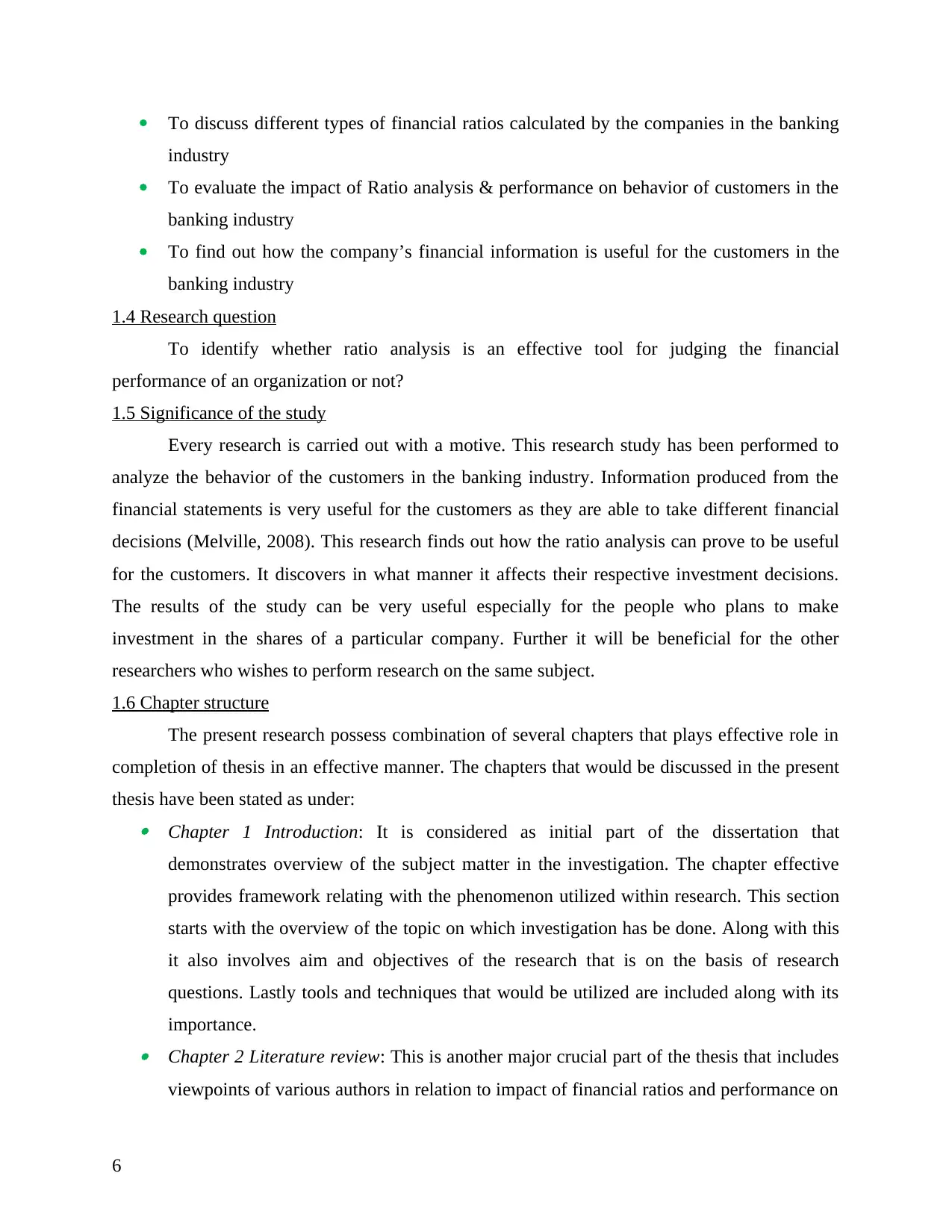
To discuss different types of financial ratios calculated by the companies in the banking
industry
To evaluate the impact of Ratio analysis & performance on behavior of customers in the
banking industry
To find out how the company’s financial information is useful for the customers in the
banking industry
1.4 Research question
To identify whether ratio analysis is an effective tool for judging the financial
performance of an organization or not?
1.5 Significance of the study
Every research is carried out with a motive. This research study has been performed to
analyze the behavior of the customers in the banking industry. Information produced from the
financial statements is very useful for the customers as they are able to take different financial
decisions (Melville, 2008). This research finds out how the ratio analysis can prove to be useful
for the customers. It discovers in what manner it affects their respective investment decisions.
The results of the study can be very useful especially for the people who plans to make
investment in the shares of a particular company. Further it will be beneficial for the other
researchers who wishes to perform research on the same subject.
1.6 Chapter structure
The present research possess combination of several chapters that plays effective role in
completion of thesis in an effective manner. The chapters that would be discussed in the present
thesis have been stated as under: Chapter 1 Introduction: It is considered as initial part of the dissertation that
demonstrates overview of the subject matter in the investigation. The chapter effective
provides framework relating with the phenomenon utilized within research. This section
starts with the overview of the topic on which investigation has be done. Along with this
it also involves aim and objectives of the research that is on the basis of research
questions. Lastly tools and techniques that would be utilized are included along with its
importance. Chapter 2 Literature review: This is another major crucial part of the thesis that includes
viewpoints of various authors in relation to impact of financial ratios and performance on
6
industry
To evaluate the impact of Ratio analysis & performance on behavior of customers in the
banking industry
To find out how the company’s financial information is useful for the customers in the
banking industry
1.4 Research question
To identify whether ratio analysis is an effective tool for judging the financial
performance of an organization or not?
1.5 Significance of the study
Every research is carried out with a motive. This research study has been performed to
analyze the behavior of the customers in the banking industry. Information produced from the
financial statements is very useful for the customers as they are able to take different financial
decisions (Melville, 2008). This research finds out how the ratio analysis can prove to be useful
for the customers. It discovers in what manner it affects their respective investment decisions.
The results of the study can be very useful especially for the people who plans to make
investment in the shares of a particular company. Further it will be beneficial for the other
researchers who wishes to perform research on the same subject.
1.6 Chapter structure
The present research possess combination of several chapters that plays effective role in
completion of thesis in an effective manner. The chapters that would be discussed in the present
thesis have been stated as under: Chapter 1 Introduction: It is considered as initial part of the dissertation that
demonstrates overview of the subject matter in the investigation. The chapter effective
provides framework relating with the phenomenon utilized within research. This section
starts with the overview of the topic on which investigation has be done. Along with this
it also involves aim and objectives of the research that is on the basis of research
questions. Lastly tools and techniques that would be utilized are included along with its
importance. Chapter 2 Literature review: This is another major crucial part of the thesis that includes
viewpoints of various authors in relation to impact of financial ratios and performance on
6
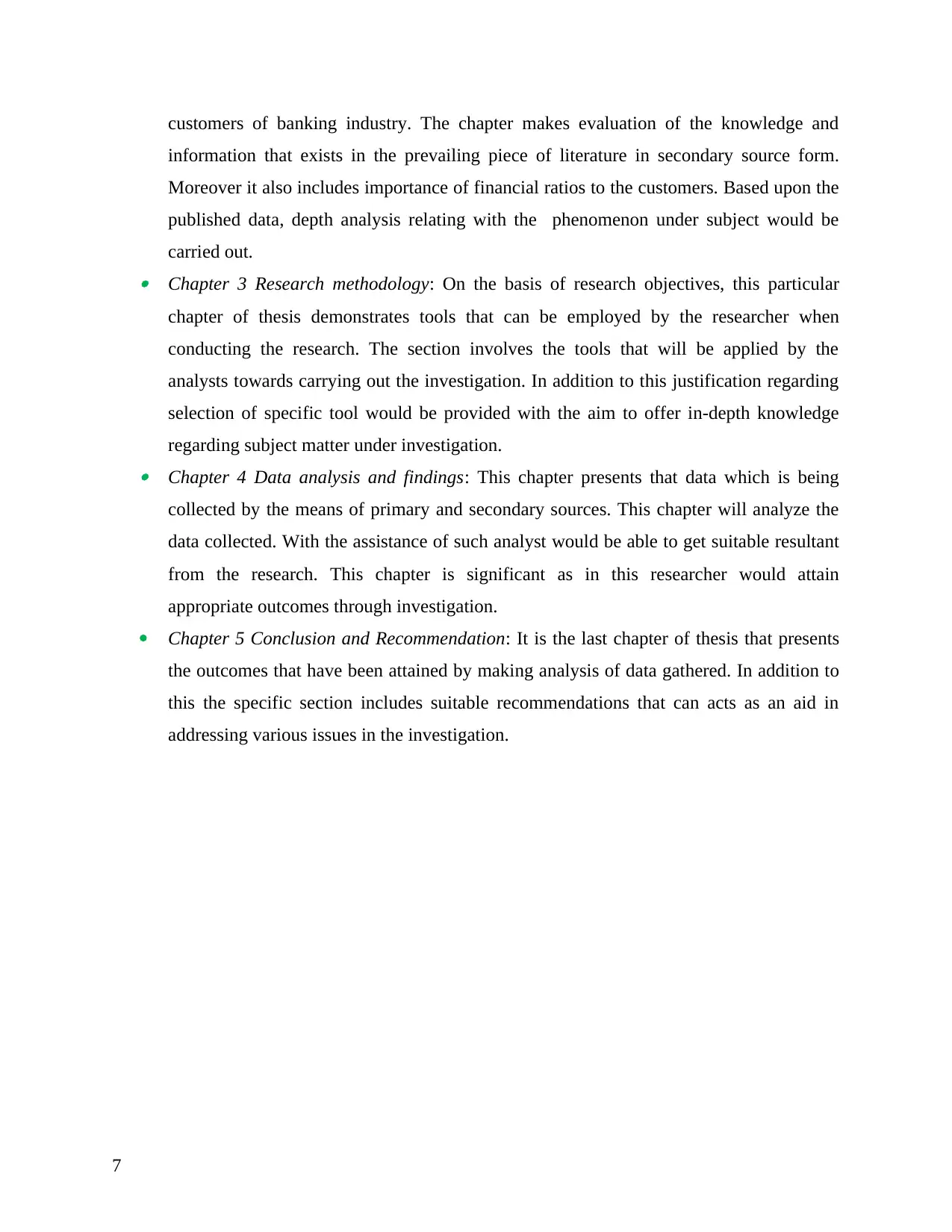
customers of banking industry. The chapter makes evaluation of the knowledge and
information that exists in the prevailing piece of literature in secondary source form.
Moreover it also includes importance of financial ratios to the customers. Based upon the
published data, depth analysis relating with the phenomenon under subject would be
carried out. Chapter 3 Research methodology: On the basis of research objectives, this particular
chapter of thesis demonstrates tools that can be employed by the researcher when
conducting the research. The section involves the tools that will be applied by the
analysts towards carrying out the investigation. In addition to this justification regarding
selection of specific tool would be provided with the aim to offer in-depth knowledge
regarding subject matter under investigation. Chapter 4 Data analysis and findings: This chapter presents that data which is being
collected by the means of primary and secondary sources. This chapter will analyze the
data collected. With the assistance of such analyst would be able to get suitable resultant
from the research. This chapter is significant as in this researcher would attain
appropriate outcomes through investigation.
Chapter 5 Conclusion and Recommendation: It is the last chapter of thesis that presents
the outcomes that have been attained by making analysis of data gathered. In addition to
this the specific section includes suitable recommendations that can acts as an aid in
addressing various issues in the investigation.
7
information that exists in the prevailing piece of literature in secondary source form.
Moreover it also includes importance of financial ratios to the customers. Based upon the
published data, depth analysis relating with the phenomenon under subject would be
carried out. Chapter 3 Research methodology: On the basis of research objectives, this particular
chapter of thesis demonstrates tools that can be employed by the researcher when
conducting the research. The section involves the tools that will be applied by the
analysts towards carrying out the investigation. In addition to this justification regarding
selection of specific tool would be provided with the aim to offer in-depth knowledge
regarding subject matter under investigation. Chapter 4 Data analysis and findings: This chapter presents that data which is being
collected by the means of primary and secondary sources. This chapter will analyze the
data collected. With the assistance of such analyst would be able to get suitable resultant
from the research. This chapter is significant as in this researcher would attain
appropriate outcomes through investigation.
Chapter 5 Conclusion and Recommendation: It is the last chapter of thesis that presents
the outcomes that have been attained by making analysis of data gathered. In addition to
this the specific section includes suitable recommendations that can acts as an aid in
addressing various issues in the investigation.
7
Paraphrase This Document
Need a fresh take? Get an instant paraphrase of this document with our AI Paraphraser
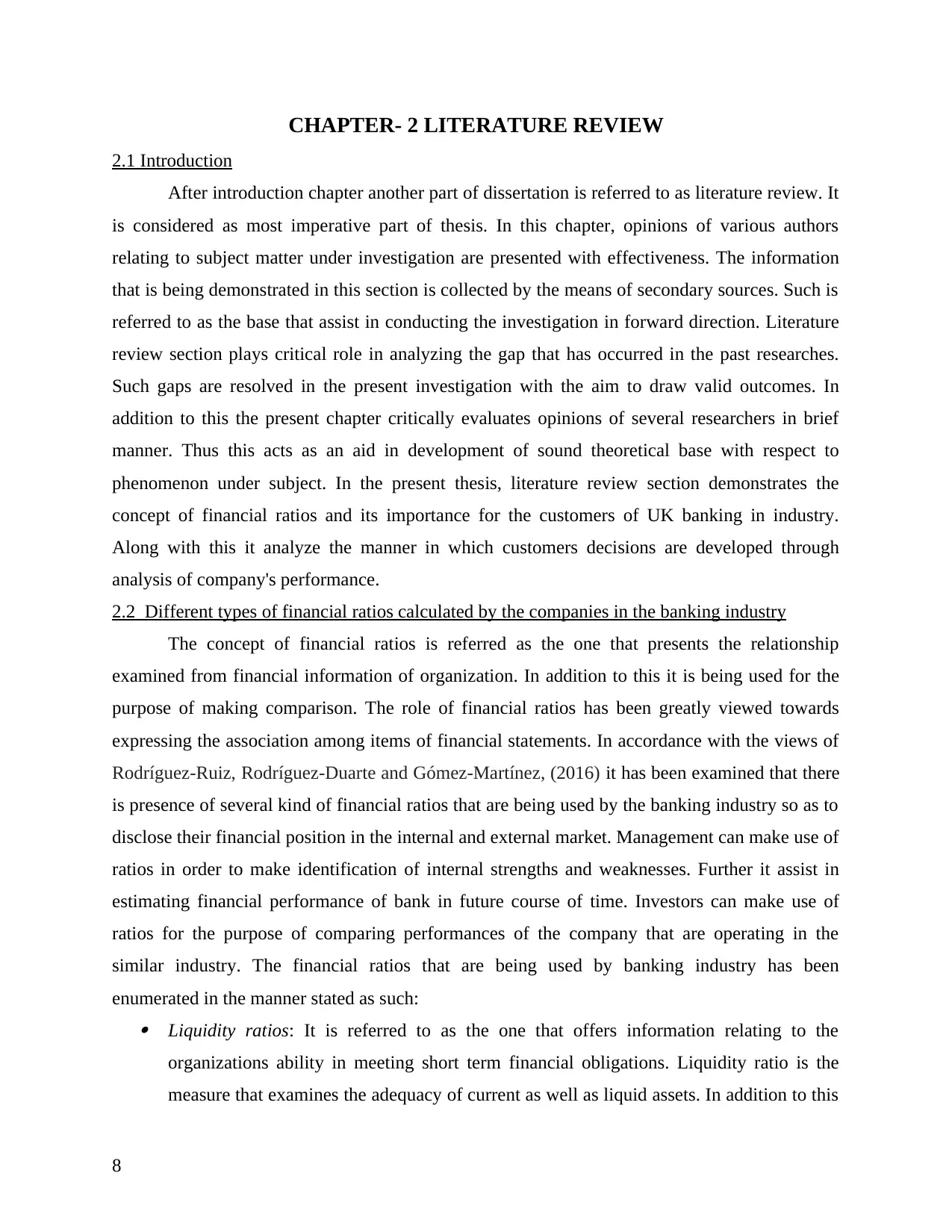
CHAPTER- 2 LITERATURE REVIEW
2.1 Introduction
After introduction chapter another part of dissertation is referred to as literature review. It
is considered as most imperative part of thesis. In this chapter, opinions of various authors
relating to subject matter under investigation are presented with effectiveness. The information
that is being demonstrated in this section is collected by the means of secondary sources. Such is
referred to as the base that assist in conducting the investigation in forward direction. Literature
review section plays critical role in analyzing the gap that has occurred in the past researches.
Such gaps are resolved in the present investigation with the aim to draw valid outcomes. In
addition to this the present chapter critically evaluates opinions of several researchers in brief
manner. Thus this acts as an aid in development of sound theoretical base with respect to
phenomenon under subject. In the present thesis, literature review section demonstrates the
concept of financial ratios and its importance for the customers of UK banking in industry.
Along with this it analyze the manner in which customers decisions are developed through
analysis of company's performance.
2.2 Different types of financial ratios calculated by the companies in the banking industry
The concept of financial ratios is referred as the one that presents the relationship
examined from financial information of organization. In addition to this it is being used for the
purpose of making comparison. The role of financial ratios has been greatly viewed towards
expressing the association among items of financial statements. In accordance with the views of
Rodríguez-Ruiz, Rodríguez-Duarte and Gómez-Martínez, (2016) it has been examined that there
is presence of several kind of financial ratios that are being used by the banking industry so as to
disclose their financial position in the internal and external market. Management can make use of
ratios in order to make identification of internal strengths and weaknesses. Further it assist in
estimating financial performance of bank in future course of time. Investors can make use of
ratios for the purpose of comparing performances of the company that are operating in the
similar industry. The financial ratios that are being used by banking industry has been
enumerated in the manner stated as such: Liquidity ratios: It is referred to as the one that offers information relating to the
organizations ability in meeting short term financial obligations. Liquidity ratio is the
measure that examines the adequacy of current as well as liquid assets. In addition to this
8
2.1 Introduction
After introduction chapter another part of dissertation is referred to as literature review. It
is considered as most imperative part of thesis. In this chapter, opinions of various authors
relating to subject matter under investigation are presented with effectiveness. The information
that is being demonstrated in this section is collected by the means of secondary sources. Such is
referred to as the base that assist in conducting the investigation in forward direction. Literature
review section plays critical role in analyzing the gap that has occurred in the past researches.
Such gaps are resolved in the present investigation with the aim to draw valid outcomes. In
addition to this the present chapter critically evaluates opinions of several researchers in brief
manner. Thus this acts as an aid in development of sound theoretical base with respect to
phenomenon under subject. In the present thesis, literature review section demonstrates the
concept of financial ratios and its importance for the customers of UK banking in industry.
Along with this it analyze the manner in which customers decisions are developed through
analysis of company's performance.
2.2 Different types of financial ratios calculated by the companies in the banking industry
The concept of financial ratios is referred as the one that presents the relationship
examined from financial information of organization. In addition to this it is being used for the
purpose of making comparison. The role of financial ratios has been greatly viewed towards
expressing the association among items of financial statements. In accordance with the views of
Rodríguez-Ruiz, Rodríguez-Duarte and Gómez-Martínez, (2016) it has been examined that there
is presence of several kind of financial ratios that are being used by the banking industry so as to
disclose their financial position in the internal and external market. Management can make use of
ratios in order to make identification of internal strengths and weaknesses. Further it assist in
estimating financial performance of bank in future course of time. Investors can make use of
ratios for the purpose of comparing performances of the company that are operating in the
similar industry. The financial ratios that are being used by banking industry has been
enumerated in the manner stated as such: Liquidity ratios: It is referred to as the one that offers information relating to the
organizations ability in meeting short term financial obligations. Liquidity ratio is the
measure that examines the adequacy of current as well as liquid assets. In addition to this
8
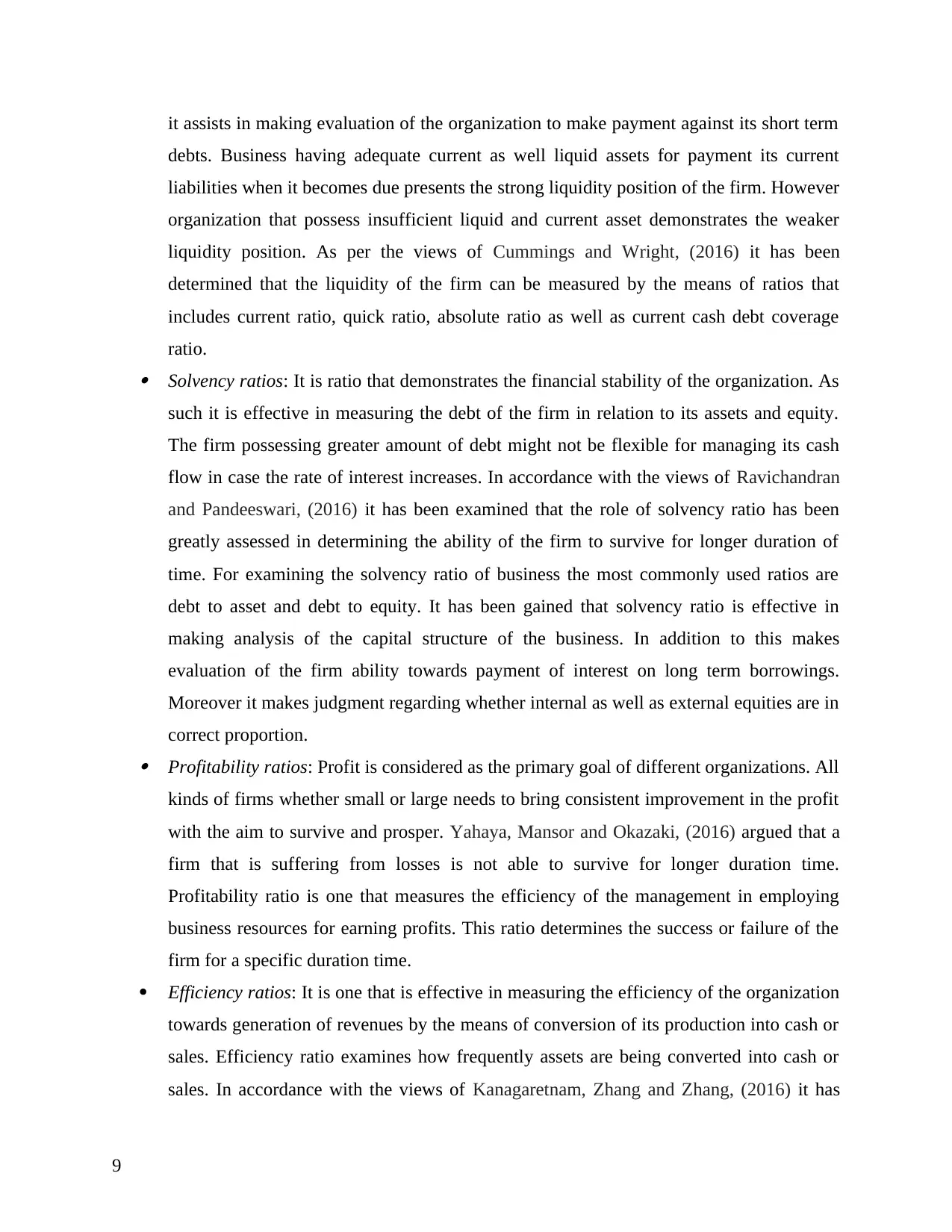
it assists in making evaluation of the organization to make payment against its short term
debts. Business having adequate current as well liquid assets for payment its current
liabilities when it becomes due presents the strong liquidity position of the firm. However
organization that possess insufficient liquid and current asset demonstrates the weaker
liquidity position. As per the views of Cummings and Wright, (2016) it has been
determined that the liquidity of the firm can be measured by the means of ratios that
includes current ratio, quick ratio, absolute ratio as well as current cash debt coverage
ratio. Solvency ratios: It is ratio that demonstrates the financial stability of the organization. As
such it is effective in measuring the debt of the firm in relation to its assets and equity.
The firm possessing greater amount of debt might not be flexible for managing its cash
flow in case the rate of interest increases. In accordance with the views of Ravichandran
and Pandeeswari, (2016) it has been examined that the role of solvency ratio has been
greatly assessed in determining the ability of the firm to survive for longer duration of
time. For examining the solvency ratio of business the most commonly used ratios are
debt to asset and debt to equity. It has been gained that solvency ratio is effective in
making analysis of the capital structure of the business. In addition to this makes
evaluation of the firm ability towards payment of interest on long term borrowings.
Moreover it makes judgment regarding whether internal as well as external equities are in
correct proportion. Profitability ratios: Profit is considered as the primary goal of different organizations. All
kinds of firms whether small or large needs to bring consistent improvement in the profit
with the aim to survive and prosper. Yahaya, Mansor and Okazaki, (2016) argued that a
firm that is suffering from losses is not able to survive for longer duration time.
Profitability ratio is one that measures the efficiency of the management in employing
business resources for earning profits. This ratio determines the success or failure of the
firm for a specific duration time.
Efficiency ratios: It is one that is effective in measuring the efficiency of the organization
towards generation of revenues by the means of conversion of its production into cash or
sales. Efficiency ratio examines how frequently assets are being converted into cash or
sales. In accordance with the views of Kanagaretnam, Zhang and Zhang, (2016) it has
9
debts. Business having adequate current as well liquid assets for payment its current
liabilities when it becomes due presents the strong liquidity position of the firm. However
organization that possess insufficient liquid and current asset demonstrates the weaker
liquidity position. As per the views of Cummings and Wright, (2016) it has been
determined that the liquidity of the firm can be measured by the means of ratios that
includes current ratio, quick ratio, absolute ratio as well as current cash debt coverage
ratio. Solvency ratios: It is ratio that demonstrates the financial stability of the organization. As
such it is effective in measuring the debt of the firm in relation to its assets and equity.
The firm possessing greater amount of debt might not be flexible for managing its cash
flow in case the rate of interest increases. In accordance with the views of Ravichandran
and Pandeeswari, (2016) it has been examined that the role of solvency ratio has been
greatly assessed in determining the ability of the firm to survive for longer duration of
time. For examining the solvency ratio of business the most commonly used ratios are
debt to asset and debt to equity. It has been gained that solvency ratio is effective in
making analysis of the capital structure of the business. In addition to this makes
evaluation of the firm ability towards payment of interest on long term borrowings.
Moreover it makes judgment regarding whether internal as well as external equities are in
correct proportion. Profitability ratios: Profit is considered as the primary goal of different organizations. All
kinds of firms whether small or large needs to bring consistent improvement in the profit
with the aim to survive and prosper. Yahaya, Mansor and Okazaki, (2016) argued that a
firm that is suffering from losses is not able to survive for longer duration time.
Profitability ratio is one that measures the efficiency of the management in employing
business resources for earning profits. This ratio determines the success or failure of the
firm for a specific duration time.
Efficiency ratios: It is one that is effective in measuring the efficiency of the organization
towards generation of revenues by the means of conversion of its production into cash or
sales. Efficiency ratio examines how frequently assets are being converted into cash or
sales. In accordance with the views of Kanagaretnam, Zhang and Zhang, (2016) it has
9
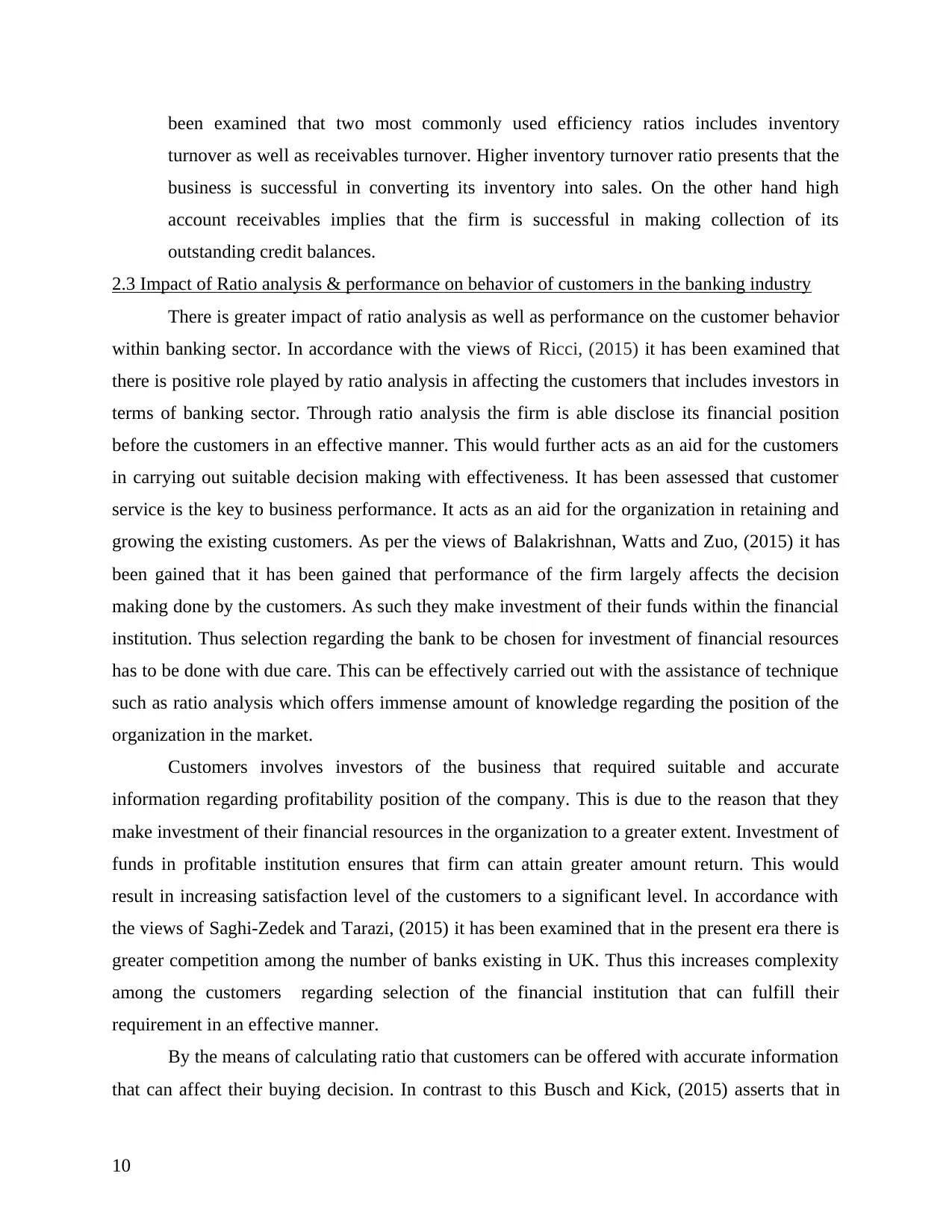
been examined that two most commonly used efficiency ratios includes inventory
turnover as well as receivables turnover. Higher inventory turnover ratio presents that the
business is successful in converting its inventory into sales. On the other hand high
account receivables implies that the firm is successful in making collection of its
outstanding credit balances.
2.3 Impact of Ratio analysis & performance on behavior of customers in the banking industry
There is greater impact of ratio analysis as well as performance on the customer behavior
within banking sector. In accordance with the views of Ricci, (2015) it has been examined that
there is positive role played by ratio analysis in affecting the customers that includes investors in
terms of banking sector. Through ratio analysis the firm is able disclose its financial position
before the customers in an effective manner. This would further acts as an aid for the customers
in carrying out suitable decision making with effectiveness. It has been assessed that customer
service is the key to business performance. It acts as an aid for the organization in retaining and
growing the existing customers. As per the views of Balakrishnan, Watts and Zuo, (2015) it has
been gained that it has been gained that performance of the firm largely affects the decision
making done by the customers. As such they make investment of their funds within the financial
institution. Thus selection regarding the bank to be chosen for investment of financial resources
has to be done with due care. This can be effectively carried out with the assistance of technique
such as ratio analysis which offers immense amount of knowledge regarding the position of the
organization in the market.
Customers involves investors of the business that required suitable and accurate
information regarding profitability position of the company. This is due to the reason that they
make investment of their financial resources in the organization to a greater extent. Investment of
funds in profitable institution ensures that firm can attain greater amount return. This would
result in increasing satisfaction level of the customers to a significant level. In accordance with
the views of Saghi-Zedek and Tarazi, (2015) it has been examined that in the present era there is
greater competition among the number of banks existing in UK. Thus this increases complexity
among the customers regarding selection of the financial institution that can fulfill their
requirement in an effective manner.
By the means of calculating ratio that customers can be offered with accurate information
that can affect their buying decision. In contrast to this Busch and Kick, (2015) asserts that in
10
turnover as well as receivables turnover. Higher inventory turnover ratio presents that the
business is successful in converting its inventory into sales. On the other hand high
account receivables implies that the firm is successful in making collection of its
outstanding credit balances.
2.3 Impact of Ratio analysis & performance on behavior of customers in the banking industry
There is greater impact of ratio analysis as well as performance on the customer behavior
within banking sector. In accordance with the views of Ricci, (2015) it has been examined that
there is positive role played by ratio analysis in affecting the customers that includes investors in
terms of banking sector. Through ratio analysis the firm is able disclose its financial position
before the customers in an effective manner. This would further acts as an aid for the customers
in carrying out suitable decision making with effectiveness. It has been assessed that customer
service is the key to business performance. It acts as an aid for the organization in retaining and
growing the existing customers. As per the views of Balakrishnan, Watts and Zuo, (2015) it has
been gained that it has been gained that performance of the firm largely affects the decision
making done by the customers. As such they make investment of their funds within the financial
institution. Thus selection regarding the bank to be chosen for investment of financial resources
has to be done with due care. This can be effectively carried out with the assistance of technique
such as ratio analysis which offers immense amount of knowledge regarding the position of the
organization in the market.
Customers involves investors of the business that required suitable and accurate
information regarding profitability position of the company. This is due to the reason that they
make investment of their financial resources in the organization to a greater extent. Investment of
funds in profitable institution ensures that firm can attain greater amount return. This would
result in increasing satisfaction level of the customers to a significant level. In accordance with
the views of Saghi-Zedek and Tarazi, (2015) it has been examined that in the present era there is
greater competition among the number of banks existing in UK. Thus this increases complexity
among the customers regarding selection of the financial institution that can fulfill their
requirement in an effective manner.
By the means of calculating ratio that customers can be offered with accurate information
that can affect their buying decision. In contrast to this Busch and Kick, (2015) asserts that in
10
Secure Best Marks with AI Grader
Need help grading? Try our AI Grader for instant feedback on your assignments.
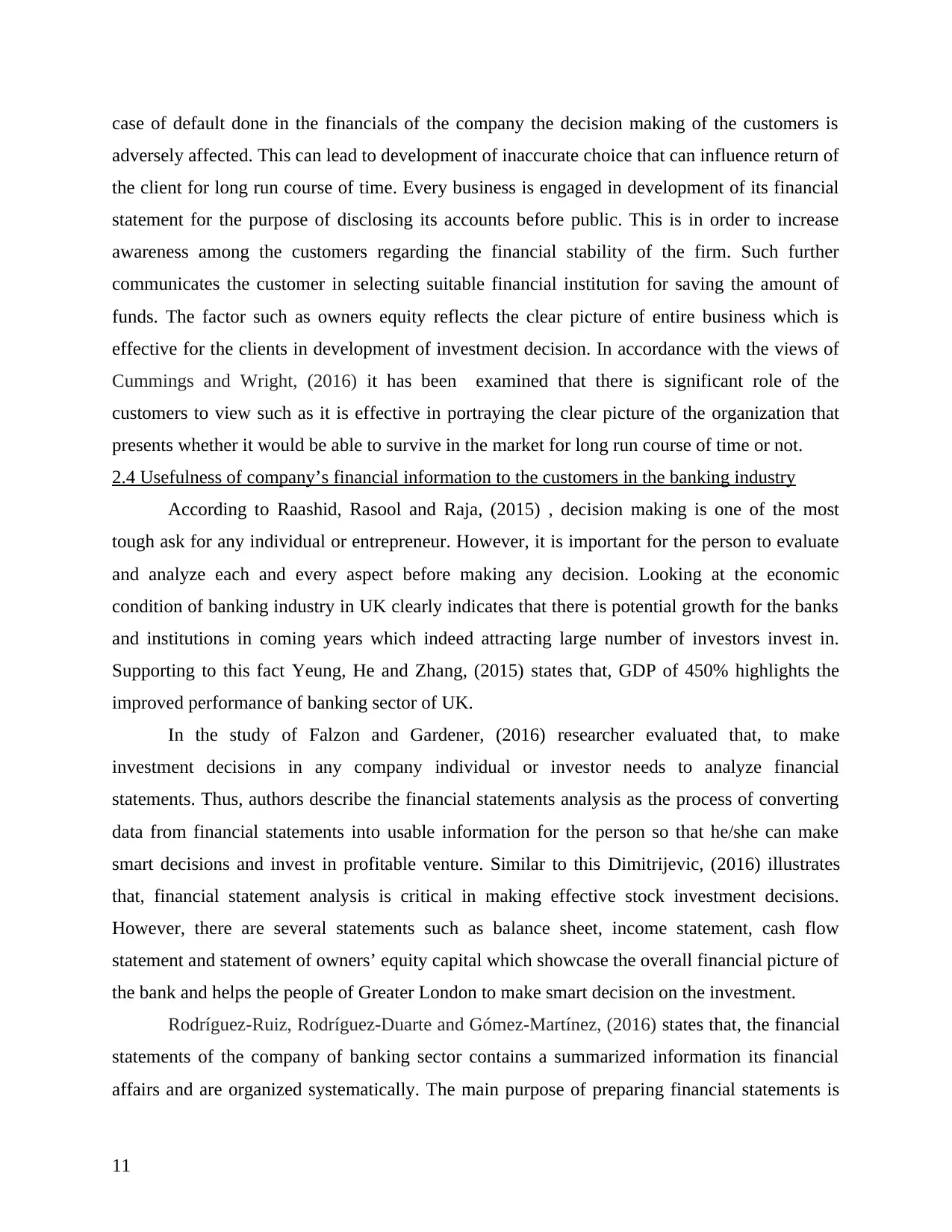
case of default done in the financials of the company the decision making of the customers is
adversely affected. This can lead to development of inaccurate choice that can influence return of
the client for long run course of time. Every business is engaged in development of its financial
statement for the purpose of disclosing its accounts before public. This is in order to increase
awareness among the customers regarding the financial stability of the firm. Such further
communicates the customer in selecting suitable financial institution for saving the amount of
funds. The factor such as owners equity reflects the clear picture of entire business which is
effective for the clients in development of investment decision. In accordance with the views of
Cummings and Wright, (2016) it has been examined that there is significant role of the
customers to view such as it is effective in portraying the clear picture of the organization that
presents whether it would be able to survive in the market for long run course of time or not.
2.4 Usefulness of company’s financial information to the customers in the banking industry
According to Raashid, Rasool and Raja, (2015) , decision making is one of the most
tough ask for any individual or entrepreneur. However, it is important for the person to evaluate
and analyze each and every aspect before making any decision. Looking at the economic
condition of banking industry in UK clearly indicates that there is potential growth for the banks
and institutions in coming years which indeed attracting large number of investors invest in.
Supporting to this fact Yeung, He and Zhang, (2015) states that, GDP of 450% highlights the
improved performance of banking sector of UK.
In the study of Falzon and Gardener, (2016) researcher evaluated that, to make
investment decisions in any company individual or investor needs to analyze financial
statements. Thus, authors describe the financial statements analysis as the process of converting
data from financial statements into usable information for the person so that he/she can make
smart decisions and invest in profitable venture. Similar to this Dimitrijevic, (2016) illustrates
that, financial statement analysis is critical in making effective stock investment decisions.
However, there are several statements such as balance sheet, income statement, cash flow
statement and statement of owners’ equity capital which showcase the overall financial picture of
the bank and helps the people of Greater London to make smart decision on the investment.
Rodríguez-Ruiz, Rodríguez-Duarte and Gómez-Martínez, (2016) states that, the financial
statements of the company of banking sector contains a summarized information its financial
affairs and are organized systematically. The main purpose of preparing financial statements is
11
adversely affected. This can lead to development of inaccurate choice that can influence return of
the client for long run course of time. Every business is engaged in development of its financial
statement for the purpose of disclosing its accounts before public. This is in order to increase
awareness among the customers regarding the financial stability of the firm. Such further
communicates the customer in selecting suitable financial institution for saving the amount of
funds. The factor such as owners equity reflects the clear picture of entire business which is
effective for the clients in development of investment decision. In accordance with the views of
Cummings and Wright, (2016) it has been examined that there is significant role of the
customers to view such as it is effective in portraying the clear picture of the organization that
presents whether it would be able to survive in the market for long run course of time or not.
2.4 Usefulness of company’s financial information to the customers in the banking industry
According to Raashid, Rasool and Raja, (2015) , decision making is one of the most
tough ask for any individual or entrepreneur. However, it is important for the person to evaluate
and analyze each and every aspect before making any decision. Looking at the economic
condition of banking industry in UK clearly indicates that there is potential growth for the banks
and institutions in coming years which indeed attracting large number of investors invest in.
Supporting to this fact Yeung, He and Zhang, (2015) states that, GDP of 450% highlights the
improved performance of banking sector of UK.
In the study of Falzon and Gardener, (2016) researcher evaluated that, to make
investment decisions in any company individual or investor needs to analyze financial
statements. Thus, authors describe the financial statements analysis as the process of converting
data from financial statements into usable information for the person so that he/she can make
smart decisions and invest in profitable venture. Similar to this Dimitrijevic, (2016) illustrates
that, financial statement analysis is critical in making effective stock investment decisions.
However, there are several statements such as balance sheet, income statement, cash flow
statement and statement of owners’ equity capital which showcase the overall financial picture of
the bank and helps the people of Greater London to make smart decision on the investment.
Rodríguez-Ruiz, Rodríguez-Duarte and Gómez-Martínez, (2016) states that, the financial
statements of the company of banking sector contains a summarized information its financial
affairs and are organized systematically. The main purpose of preparing financial statements is
11
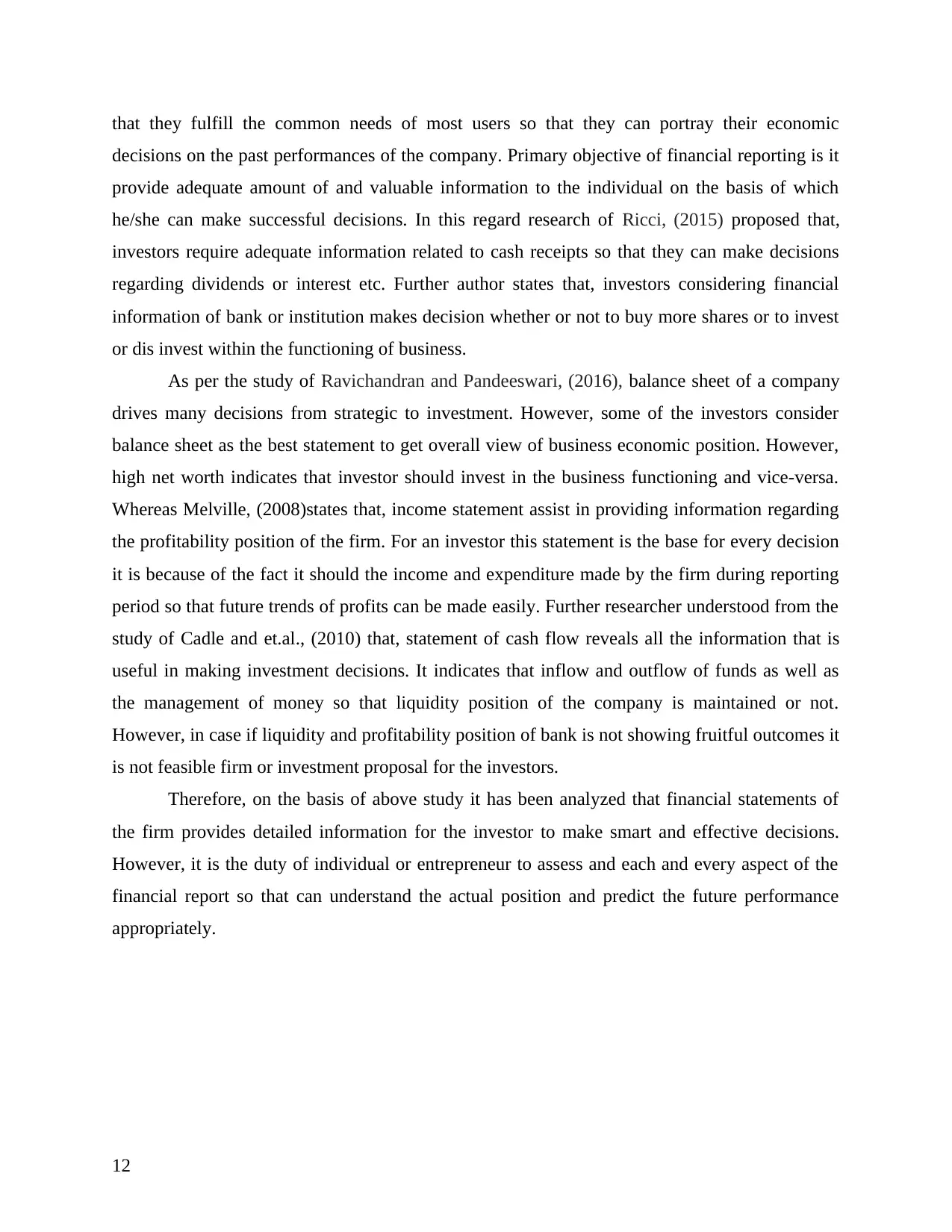
that they fulfill the common needs of most users so that they can portray their economic
decisions on the past performances of the company. Primary objective of financial reporting is it
provide adequate amount of and valuable information to the individual on the basis of which
he/she can make successful decisions. In this regard research of Ricci, (2015) proposed that,
investors require adequate information related to cash receipts so that they can make decisions
regarding dividends or interest etc. Further author states that, investors considering financial
information of bank or institution makes decision whether or not to buy more shares or to invest
or dis invest within the functioning of business.
As per the study of Ravichandran and Pandeeswari, (2016), balance sheet of a company
drives many decisions from strategic to investment. However, some of the investors consider
balance sheet as the best statement to get overall view of business economic position. However,
high net worth indicates that investor should invest in the business functioning and vice-versa.
Whereas Melville, (2008)states that, income statement assist in providing information regarding
the profitability position of the firm. For an investor this statement is the base for every decision
it is because of the fact it should the income and expenditure made by the firm during reporting
period so that future trends of profits can be made easily. Further researcher understood from the
study of Cadle and et.al., (2010) that, statement of cash flow reveals all the information that is
useful in making investment decisions. It indicates that inflow and outflow of funds as well as
the management of money so that liquidity position of the company is maintained or not.
However, in case if liquidity and profitability position of bank is not showing fruitful outcomes it
is not feasible firm or investment proposal for the investors.
Therefore, on the basis of above study it has been analyzed that financial statements of
the firm provides detailed information for the investor to make smart and effective decisions.
However, it is the duty of individual or entrepreneur to assess and each and every aspect of the
financial report so that can understand the actual position and predict the future performance
appropriately.
12
decisions on the past performances of the company. Primary objective of financial reporting is it
provide adequate amount of and valuable information to the individual on the basis of which
he/she can make successful decisions. In this regard research of Ricci, (2015) proposed that,
investors require adequate information related to cash receipts so that they can make decisions
regarding dividends or interest etc. Further author states that, investors considering financial
information of bank or institution makes decision whether or not to buy more shares or to invest
or dis invest within the functioning of business.
As per the study of Ravichandran and Pandeeswari, (2016), balance sheet of a company
drives many decisions from strategic to investment. However, some of the investors consider
balance sheet as the best statement to get overall view of business economic position. However,
high net worth indicates that investor should invest in the business functioning and vice-versa.
Whereas Melville, (2008)states that, income statement assist in providing information regarding
the profitability position of the firm. For an investor this statement is the base for every decision
it is because of the fact it should the income and expenditure made by the firm during reporting
period so that future trends of profits can be made easily. Further researcher understood from the
study of Cadle and et.al., (2010) that, statement of cash flow reveals all the information that is
useful in making investment decisions. It indicates that inflow and outflow of funds as well as
the management of money so that liquidity position of the company is maintained or not.
However, in case if liquidity and profitability position of bank is not showing fruitful outcomes it
is not feasible firm or investment proposal for the investors.
Therefore, on the basis of above study it has been analyzed that financial statements of
the firm provides detailed information for the investor to make smart and effective decisions.
However, it is the duty of individual or entrepreneur to assess and each and every aspect of the
financial report so that can understand the actual position and predict the future performance
appropriately.
12
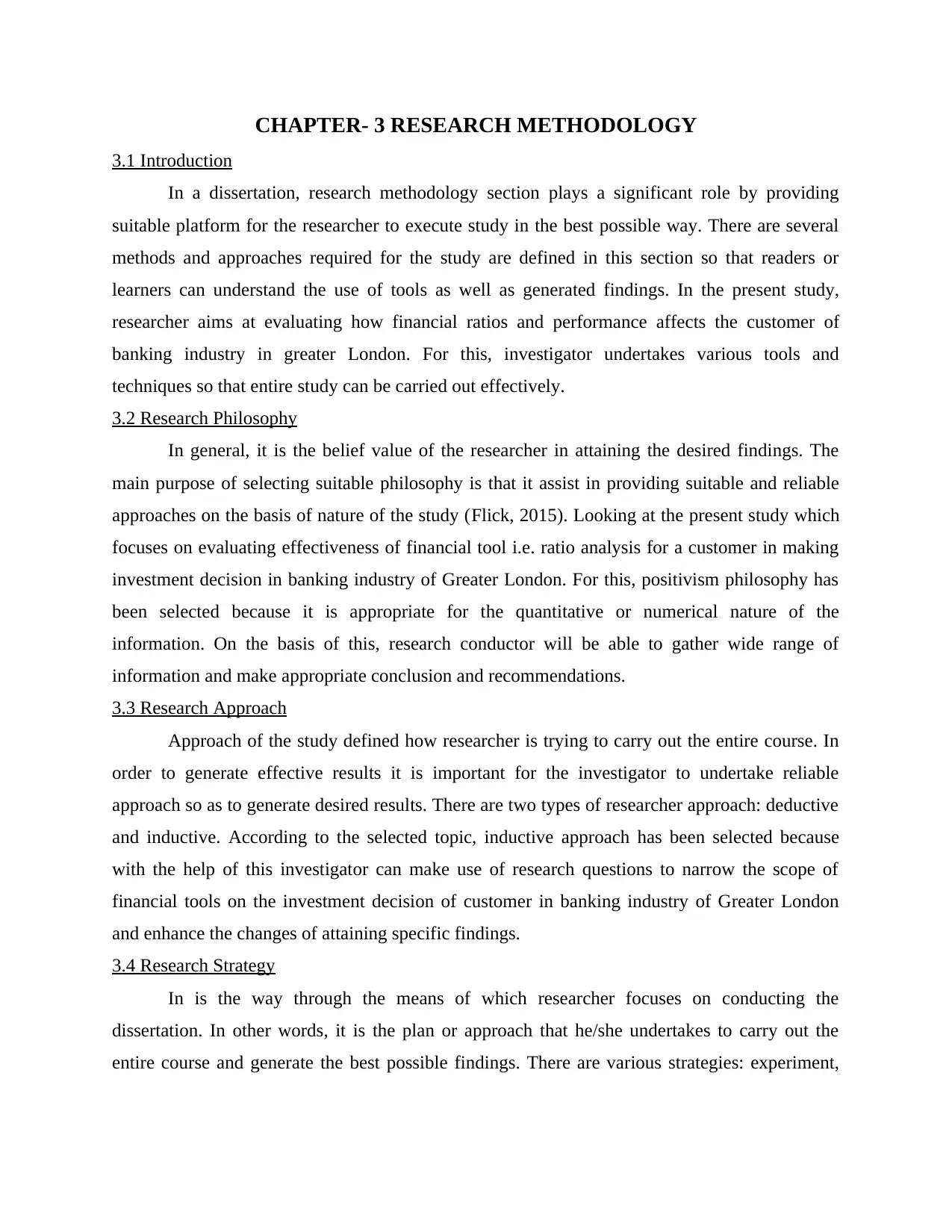
CHAPTER- 3 RESEARCH METHODOLOGY
3.1 Introduction
In a dissertation, research methodology section plays a significant role by providing
suitable platform for the researcher to execute study in the best possible way. There are several
methods and approaches required for the study are defined in this section so that readers or
learners can understand the use of tools as well as generated findings. In the present study,
researcher aims at evaluating how financial ratios and performance affects the customer of
banking industry in greater London. For this, investigator undertakes various tools and
techniques so that entire study can be carried out effectively.
3.2 Research Philosophy
In general, it is the belief value of the researcher in attaining the desired findings. The
main purpose of selecting suitable philosophy is that it assist in providing suitable and reliable
approaches on the basis of nature of the study (Flick, 2015). Looking at the present study which
focuses on evaluating effectiveness of financial tool i.e. ratio analysis for a customer in making
investment decision in banking industry of Greater London. For this, positivism philosophy has
been selected because it is appropriate for the quantitative or numerical nature of the
information. On the basis of this, research conductor will be able to gather wide range of
information and make appropriate conclusion and recommendations.
3.3 Research Approach
Approach of the study defined how researcher is trying to carry out the entire course. In
order to generate effective results it is important for the investigator to undertake reliable
approach so as to generate desired results. There are two types of researcher approach: deductive
and inductive. According to the selected topic, inductive approach has been selected because
with the help of this investigator can make use of research questions to narrow the scope of
financial tools on the investment decision of customer in banking industry of Greater London
and enhance the changes of attaining specific findings.
3.4 Research Strategy
In is the way through the means of which researcher focuses on conducting the
dissertation. In other words, it is the plan or approach that he/she undertakes to carry out the
entire course and generate the best possible findings. There are various strategies: experiment,
3.1 Introduction
In a dissertation, research methodology section plays a significant role by providing
suitable platform for the researcher to execute study in the best possible way. There are several
methods and approaches required for the study are defined in this section so that readers or
learners can understand the use of tools as well as generated findings. In the present study,
researcher aims at evaluating how financial ratios and performance affects the customer of
banking industry in greater London. For this, investigator undertakes various tools and
techniques so that entire study can be carried out effectively.
3.2 Research Philosophy
In general, it is the belief value of the researcher in attaining the desired findings. The
main purpose of selecting suitable philosophy is that it assist in providing suitable and reliable
approaches on the basis of nature of the study (Flick, 2015). Looking at the present study which
focuses on evaluating effectiveness of financial tool i.e. ratio analysis for a customer in making
investment decision in banking industry of Greater London. For this, positivism philosophy has
been selected because it is appropriate for the quantitative or numerical nature of the
information. On the basis of this, research conductor will be able to gather wide range of
information and make appropriate conclusion and recommendations.
3.3 Research Approach
Approach of the study defined how researcher is trying to carry out the entire course. In
order to generate effective results it is important for the investigator to undertake reliable
approach so as to generate desired results. There are two types of researcher approach: deductive
and inductive. According to the selected topic, inductive approach has been selected because
with the help of this investigator can make use of research questions to narrow the scope of
financial tools on the investment decision of customer in banking industry of Greater London
and enhance the changes of attaining specific findings.
3.4 Research Strategy
In is the way through the means of which researcher focuses on conducting the
dissertation. In other words, it is the plan or approach that he/she undertakes to carry out the
entire course and generate the best possible findings. There are various strategies: experiment,
Paraphrase This Document
Need a fresh take? Get an instant paraphrase of this document with our AI Paraphraser
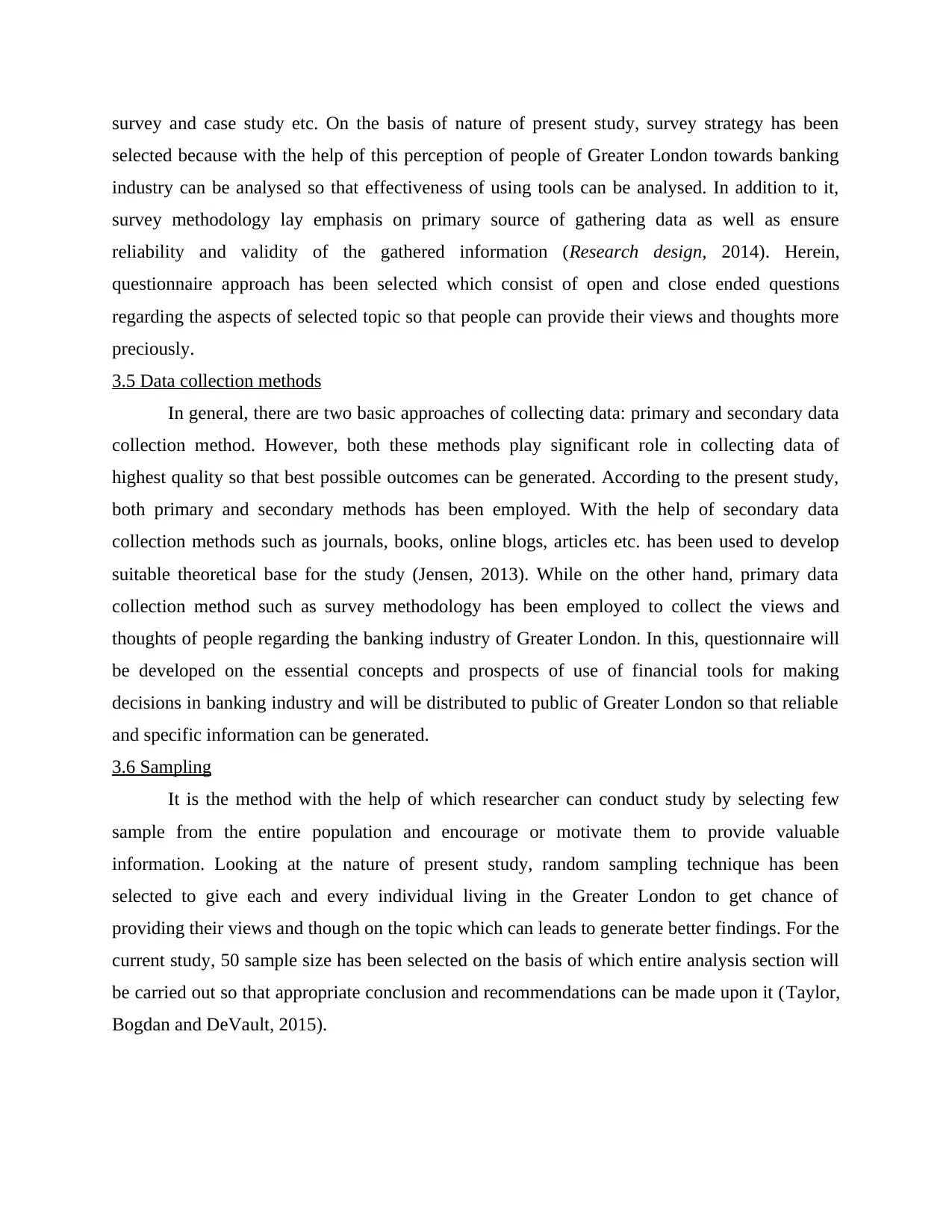
survey and case study etc. On the basis of nature of present study, survey strategy has been
selected because with the help of this perception of people of Greater London towards banking
industry can be analysed so that effectiveness of using tools can be analysed. In addition to it,
survey methodology lay emphasis on primary source of gathering data as well as ensure
reliability and validity of the gathered information (Research design, 2014). Herein,
questionnaire approach has been selected which consist of open and close ended questions
regarding the aspects of selected topic so that people can provide their views and thoughts more
preciously.
3.5 Data collection methods
In general, there are two basic approaches of collecting data: primary and secondary data
collection method. However, both these methods play significant role in collecting data of
highest quality so that best possible outcomes can be generated. According to the present study,
both primary and secondary methods has been employed. With the help of secondary data
collection methods such as journals, books, online blogs, articles etc. has been used to develop
suitable theoretical base for the study (Jensen, 2013). While on the other hand, primary data
collection method such as survey methodology has been employed to collect the views and
thoughts of people regarding the banking industry of Greater London. In this, questionnaire will
be developed on the essential concepts and prospects of use of financial tools for making
decisions in banking industry and will be distributed to public of Greater London so that reliable
and specific information can be generated.
3.6 Sampling
It is the method with the help of which researcher can conduct study by selecting few
sample from the entire population and encourage or motivate them to provide valuable
information. Looking at the nature of present study, random sampling technique has been
selected to give each and every individual living in the Greater London to get chance of
providing their views and though on the topic which can leads to generate better findings. For the
current study, 50 sample size has been selected on the basis of which entire analysis section will
be carried out so that appropriate conclusion and recommendations can be made upon it (Taylor,
Bogdan and DeVault, 2015).
selected because with the help of this perception of people of Greater London towards banking
industry can be analysed so that effectiveness of using tools can be analysed. In addition to it,
survey methodology lay emphasis on primary source of gathering data as well as ensure
reliability and validity of the gathered information (Research design, 2014). Herein,
questionnaire approach has been selected which consist of open and close ended questions
regarding the aspects of selected topic so that people can provide their views and thoughts more
preciously.
3.5 Data collection methods
In general, there are two basic approaches of collecting data: primary and secondary data
collection method. However, both these methods play significant role in collecting data of
highest quality so that best possible outcomes can be generated. According to the present study,
both primary and secondary methods has been employed. With the help of secondary data
collection methods such as journals, books, online blogs, articles etc. has been used to develop
suitable theoretical base for the study (Jensen, 2013). While on the other hand, primary data
collection method such as survey methodology has been employed to collect the views and
thoughts of people regarding the banking industry of Greater London. In this, questionnaire will
be developed on the essential concepts and prospects of use of financial tools for making
decisions in banking industry and will be distributed to public of Greater London so that reliable
and specific information can be generated.
3.6 Sampling
It is the method with the help of which researcher can conduct study by selecting few
sample from the entire population and encourage or motivate them to provide valuable
information. Looking at the nature of present study, random sampling technique has been
selected to give each and every individual living in the Greater London to get chance of
providing their views and though on the topic which can leads to generate better findings. For the
current study, 50 sample size has been selected on the basis of which entire analysis section will
be carried out so that appropriate conclusion and recommendations can be made upon it (Taylor,
Bogdan and DeVault, 2015).
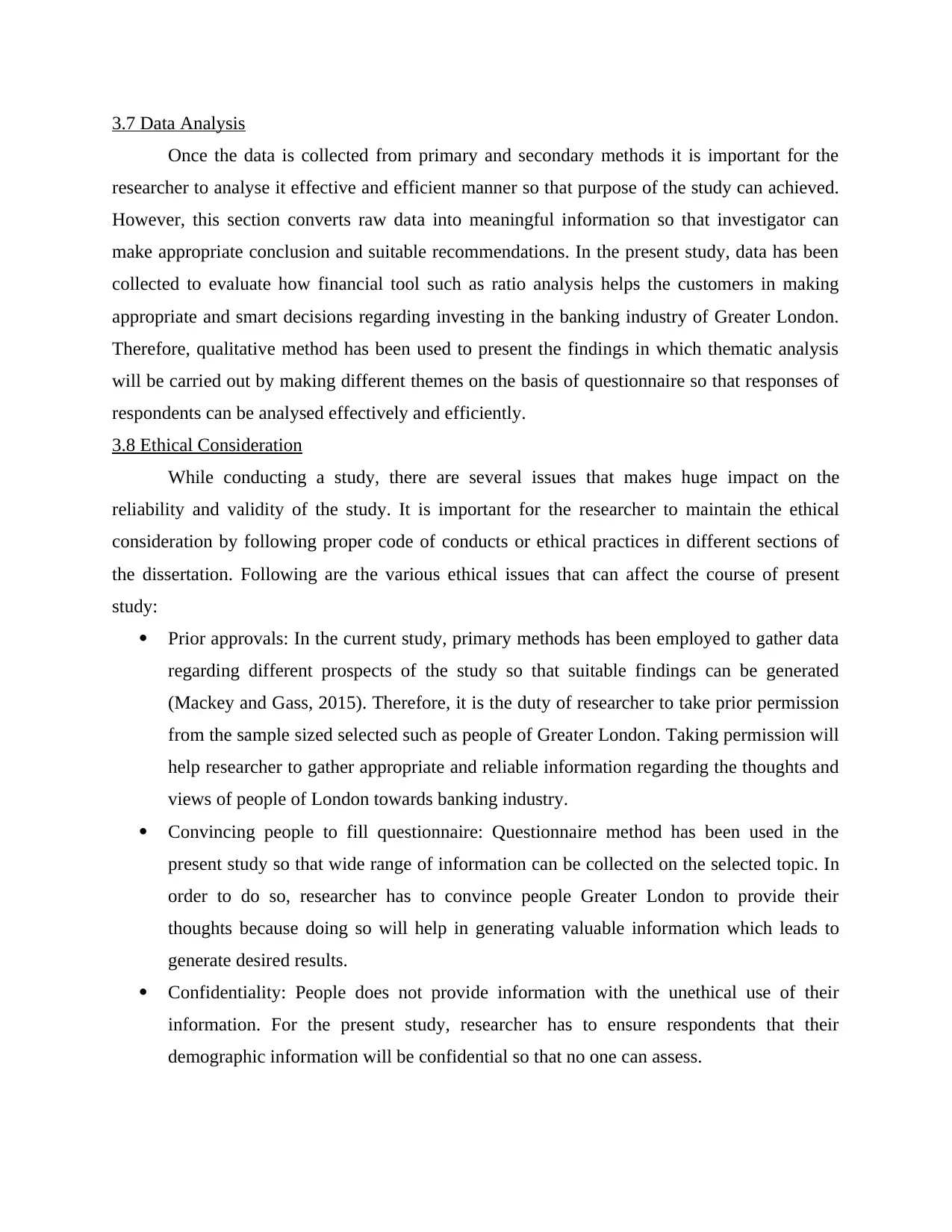
3.7 Data Analysis
Once the data is collected from primary and secondary methods it is important for the
researcher to analyse it effective and efficient manner so that purpose of the study can achieved.
However, this section converts raw data into meaningful information so that investigator can
make appropriate conclusion and suitable recommendations. In the present study, data has been
collected to evaluate how financial tool such as ratio analysis helps the customers in making
appropriate and smart decisions regarding investing in the banking industry of Greater London.
Therefore, qualitative method has been used to present the findings in which thematic analysis
will be carried out by making different themes on the basis of questionnaire so that responses of
respondents can be analysed effectively and efficiently.
3.8 Ethical Consideration
While conducting a study, there are several issues that makes huge impact on the
reliability and validity of the study. It is important for the researcher to maintain the ethical
consideration by following proper code of conducts or ethical practices in different sections of
the dissertation. Following are the various ethical issues that can affect the course of present
study:
Prior approvals: In the current study, primary methods has been employed to gather data
regarding different prospects of the study so that suitable findings can be generated
(Mackey and Gass, 2015). Therefore, it is the duty of researcher to take prior permission
from the sample sized selected such as people of Greater London. Taking permission will
help researcher to gather appropriate and reliable information regarding the thoughts and
views of people of London towards banking industry.
Convincing people to fill questionnaire: Questionnaire method has been used in the
present study so that wide range of information can be collected on the selected topic. In
order to do so, researcher has to convince people Greater London to provide their
thoughts because doing so will help in generating valuable information which leads to
generate desired results.
Confidentiality: People does not provide information with the unethical use of their
information. For the present study, researcher has to ensure respondents that their
demographic information will be confidential so that no one can assess.
Once the data is collected from primary and secondary methods it is important for the
researcher to analyse it effective and efficient manner so that purpose of the study can achieved.
However, this section converts raw data into meaningful information so that investigator can
make appropriate conclusion and suitable recommendations. In the present study, data has been
collected to evaluate how financial tool such as ratio analysis helps the customers in making
appropriate and smart decisions regarding investing in the banking industry of Greater London.
Therefore, qualitative method has been used to present the findings in which thematic analysis
will be carried out by making different themes on the basis of questionnaire so that responses of
respondents can be analysed effectively and efficiently.
3.8 Ethical Consideration
While conducting a study, there are several issues that makes huge impact on the
reliability and validity of the study. It is important for the researcher to maintain the ethical
consideration by following proper code of conducts or ethical practices in different sections of
the dissertation. Following are the various ethical issues that can affect the course of present
study:
Prior approvals: In the current study, primary methods has been employed to gather data
regarding different prospects of the study so that suitable findings can be generated
(Mackey and Gass, 2015). Therefore, it is the duty of researcher to take prior permission
from the sample sized selected such as people of Greater London. Taking permission will
help researcher to gather appropriate and reliable information regarding the thoughts and
views of people of London towards banking industry.
Convincing people to fill questionnaire: Questionnaire method has been used in the
present study so that wide range of information can be collected on the selected topic. In
order to do so, researcher has to convince people Greater London to provide their
thoughts because doing so will help in generating valuable information which leads to
generate desired results.
Confidentiality: People does not provide information with the unethical use of their
information. For the present study, researcher has to ensure respondents that their
demographic information will be confidential so that no one can assess.
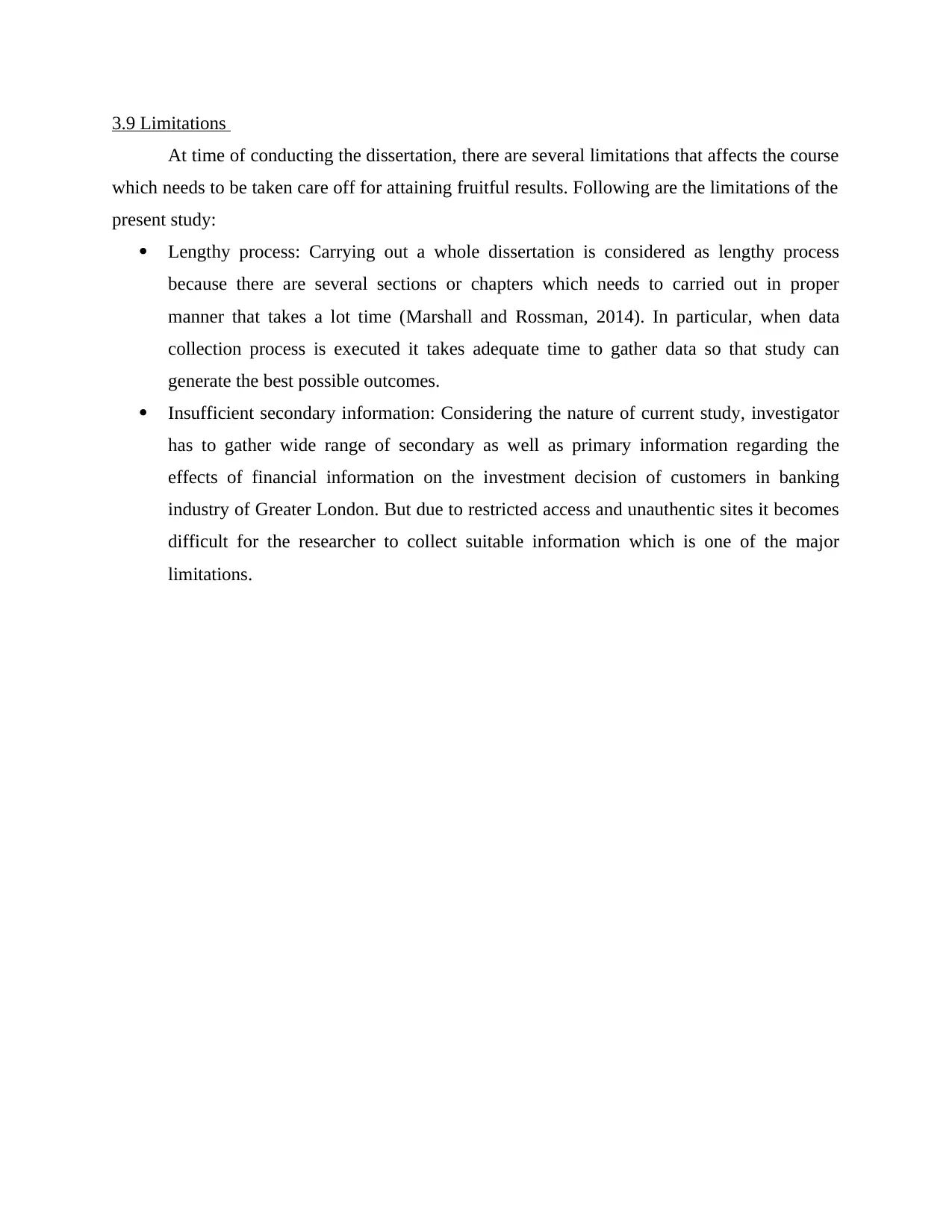
3.9 Limitations
At time of conducting the dissertation, there are several limitations that affects the course
which needs to be taken care off for attaining fruitful results. Following are the limitations of the
present study:
Lengthy process: Carrying out a whole dissertation is considered as lengthy process
because there are several sections or chapters which needs to carried out in proper
manner that takes a lot time (Marshall and Rossman, 2014). In particular, when data
collection process is executed it takes adequate time to gather data so that study can
generate the best possible outcomes.
Insufficient secondary information: Considering the nature of current study, investigator
has to gather wide range of secondary as well as primary information regarding the
effects of financial information on the investment decision of customers in banking
industry of Greater London. But due to restricted access and unauthentic sites it becomes
difficult for the researcher to collect suitable information which is one of the major
limitations.
At time of conducting the dissertation, there are several limitations that affects the course
which needs to be taken care off for attaining fruitful results. Following are the limitations of the
present study:
Lengthy process: Carrying out a whole dissertation is considered as lengthy process
because there are several sections or chapters which needs to carried out in proper
manner that takes a lot time (Marshall and Rossman, 2014). In particular, when data
collection process is executed it takes adequate time to gather data so that study can
generate the best possible outcomes.
Insufficient secondary information: Considering the nature of current study, investigator
has to gather wide range of secondary as well as primary information regarding the
effects of financial information on the investment decision of customers in banking
industry of Greater London. But due to restricted access and unauthentic sites it becomes
difficult for the researcher to collect suitable information which is one of the major
limitations.
Secure Best Marks with AI Grader
Need help grading? Try our AI Grader for instant feedback on your assignments.
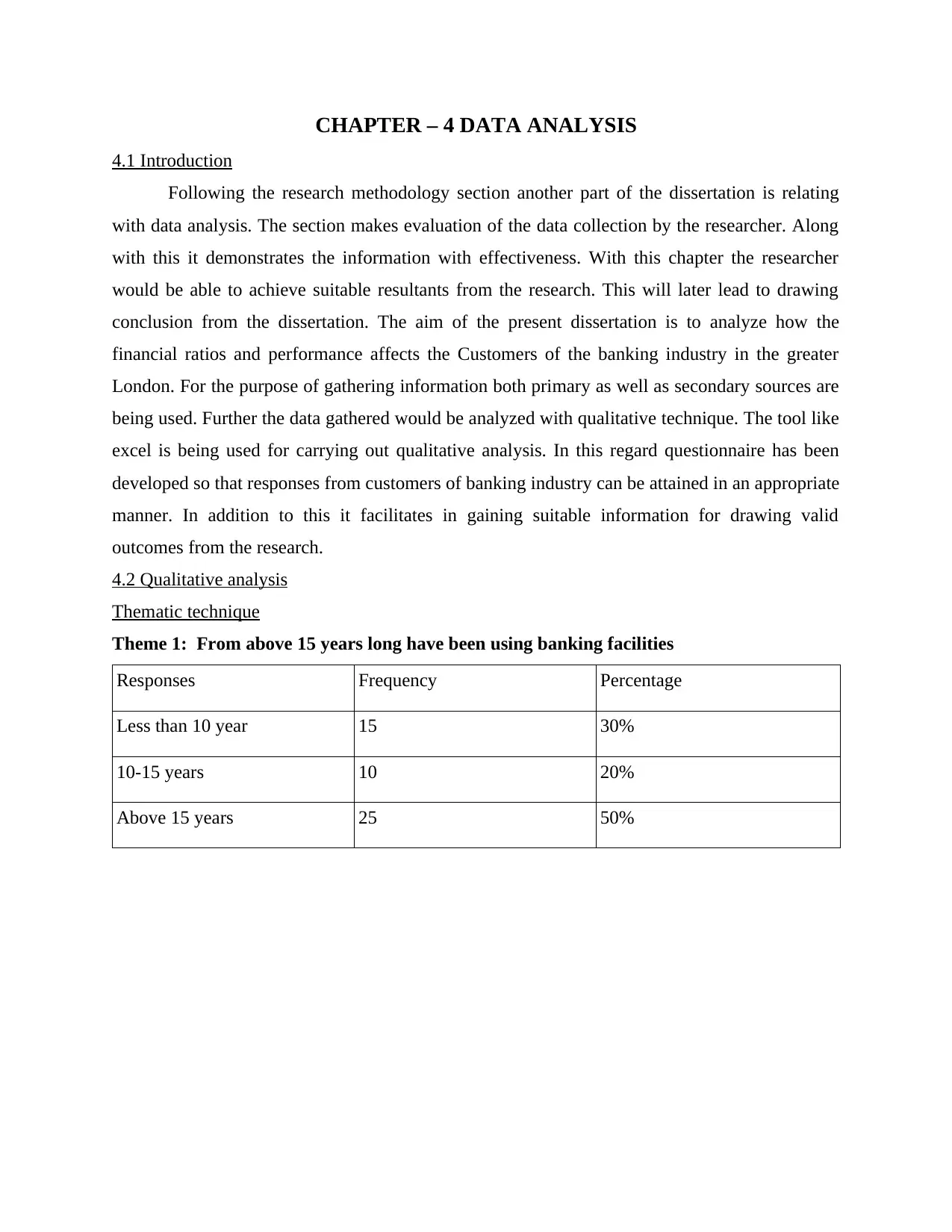
CHAPTER – 4 DATA ANALYSIS
4.1 Introduction
Following the research methodology section another part of the dissertation is relating
with data analysis. The section makes evaluation of the data collection by the researcher. Along
with this it demonstrates the information with effectiveness. With this chapter the researcher
would be able to achieve suitable resultants from the research. This will later lead to drawing
conclusion from the dissertation. The aim of the present dissertation is to analyze how the
financial ratios and performance affects the Customers of the banking industry in the greater
London. For the purpose of gathering information both primary as well as secondary sources are
being used. Further the data gathered would be analyzed with qualitative technique. The tool like
excel is being used for carrying out qualitative analysis. In this regard questionnaire has been
developed so that responses from customers of banking industry can be attained in an appropriate
manner. In addition to this it facilitates in gaining suitable information for drawing valid
outcomes from the research.
4.2 Qualitative analysis
Thematic technique
Theme 1: From above 15 years long have been using banking facilities
Responses Frequency Percentage
Less than 10 year 15 30%
10-15 years 10 20%
Above 15 years 25 50%
4.1 Introduction
Following the research methodology section another part of the dissertation is relating
with data analysis. The section makes evaluation of the data collection by the researcher. Along
with this it demonstrates the information with effectiveness. With this chapter the researcher
would be able to achieve suitable resultants from the research. This will later lead to drawing
conclusion from the dissertation. The aim of the present dissertation is to analyze how the
financial ratios and performance affects the Customers of the banking industry in the greater
London. For the purpose of gathering information both primary as well as secondary sources are
being used. Further the data gathered would be analyzed with qualitative technique. The tool like
excel is being used for carrying out qualitative analysis. In this regard questionnaire has been
developed so that responses from customers of banking industry can be attained in an appropriate
manner. In addition to this it facilitates in gaining suitable information for drawing valid
outcomes from the research.
4.2 Qualitative analysis
Thematic technique
Theme 1: From above 15 years long have been using banking facilities
Responses Frequency Percentage
Less than 10 year 15 30%
10-15 years 10 20%
Above 15 years 25 50%
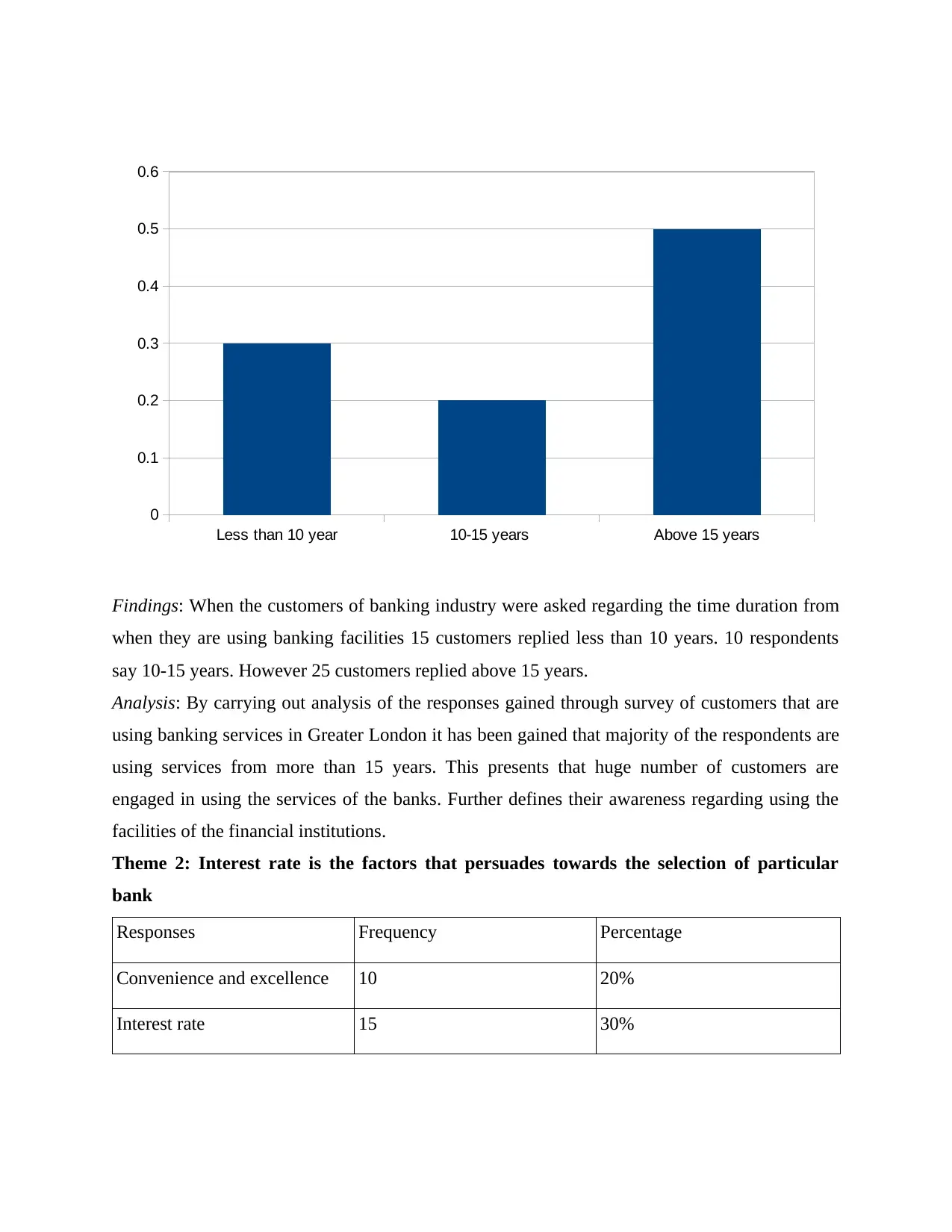
Findings: When the customers of banking industry were asked regarding the time duration from
when they are using banking facilities 15 customers replied less than 10 years. 10 respondents
say 10-15 years. However 25 customers replied above 15 years.
Analysis: By carrying out analysis of the responses gained through survey of customers that are
using banking services in Greater London it has been gained that majority of the respondents are
using services from more than 15 years. This presents that huge number of customers are
engaged in using the services of the banks. Further defines their awareness regarding using the
facilities of the financial institutions.
Theme 2: Interest rate is the factors that persuades towards the selection of particular
bank
Responses Frequency Percentage
Convenience and excellence 10 20%
Interest rate 15 30%
Less than 10 year 10-15 years Above 15 years
0
0.1
0.2
0.3
0.4
0.5
0.6
when they are using banking facilities 15 customers replied less than 10 years. 10 respondents
say 10-15 years. However 25 customers replied above 15 years.
Analysis: By carrying out analysis of the responses gained through survey of customers that are
using banking services in Greater London it has been gained that majority of the respondents are
using services from more than 15 years. This presents that huge number of customers are
engaged in using the services of the banks. Further defines their awareness regarding using the
facilities of the financial institutions.
Theme 2: Interest rate is the factors that persuades towards the selection of particular
bank
Responses Frequency Percentage
Convenience and excellence 10 20%
Interest rate 15 30%
Less than 10 year 10-15 years Above 15 years
0
0.1
0.2
0.3
0.4
0.5
0.6
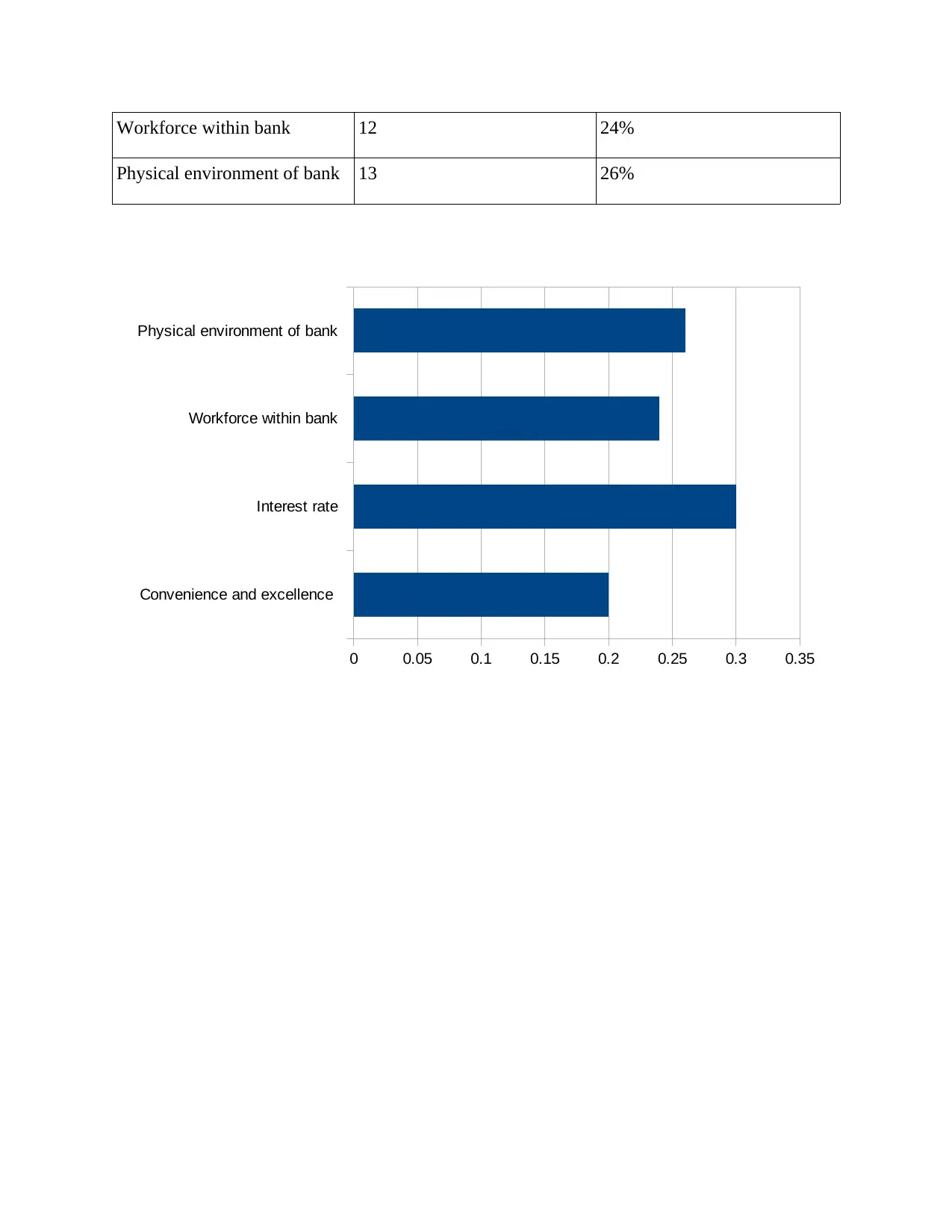
Workforce within bank 12 24%
Physical environment of bank 13 26%
Convenience and excellence
Interest rate
Workforce within bank
Physical environment of bank
0 0.05 0.1 0.15 0.2 0.25 0.3 0.35
Physical environment of bank 13 26%
Convenience and excellence
Interest rate
Workforce within bank
Physical environment of bank
0 0.05 0.1 0.15 0.2 0.25 0.3 0.35
Paraphrase This Document
Need a fresh take? Get an instant paraphrase of this document with our AI Paraphraser
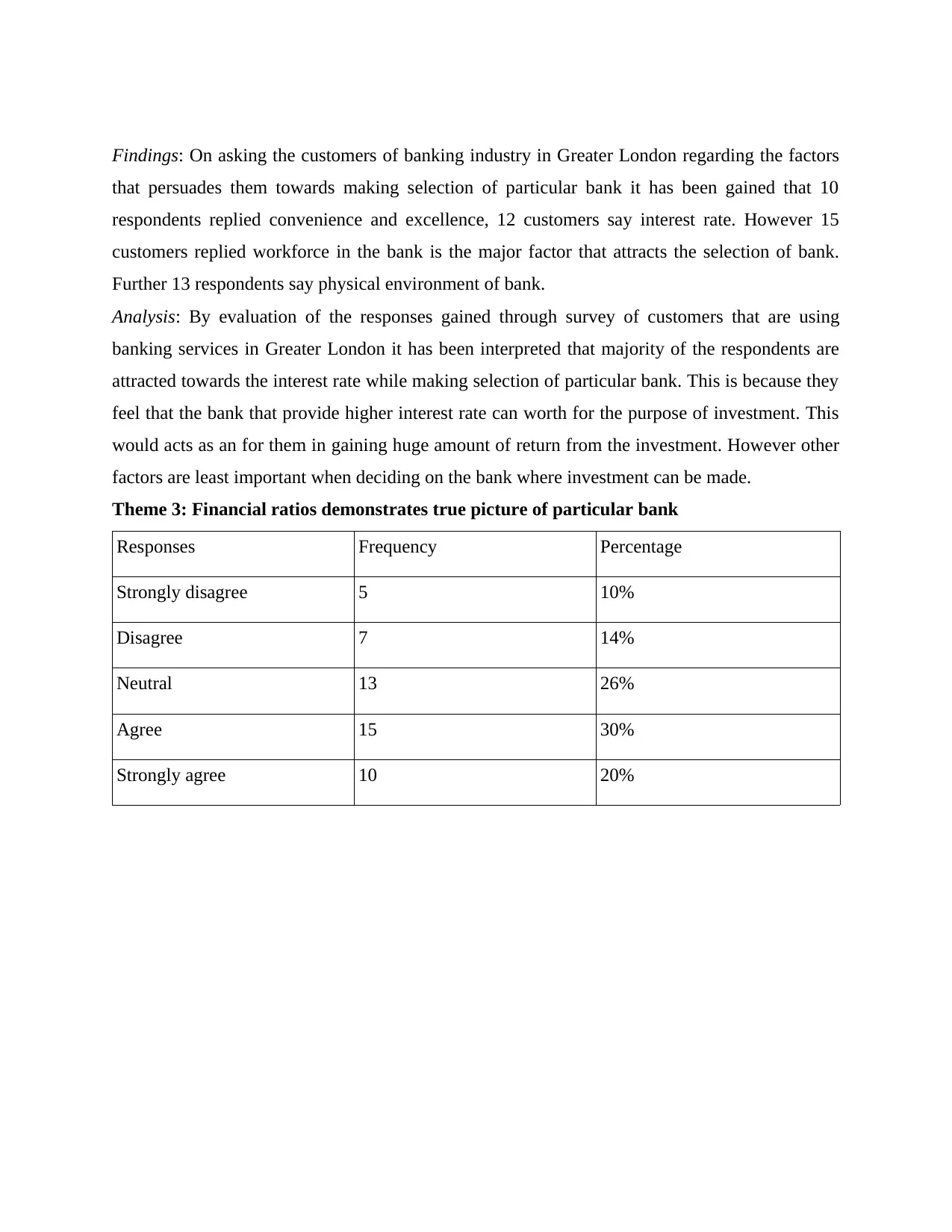
Findings: On asking the customers of banking industry in Greater London regarding the factors
that persuades them towards making selection of particular bank it has been gained that 10
respondents replied convenience and excellence, 12 customers say interest rate. However 15
customers replied workforce in the bank is the major factor that attracts the selection of bank.
Further 13 respondents say physical environment of bank.
Analysis: By evaluation of the responses gained through survey of customers that are using
banking services in Greater London it has been interpreted that majority of the respondents are
attracted towards the interest rate while making selection of particular bank. This is because they
feel that the bank that provide higher interest rate can worth for the purpose of investment. This
would acts as an for them in gaining huge amount of return from the investment. However other
factors are least important when deciding on the bank where investment can be made.
Theme 3: Financial ratios demonstrates true picture of particular bank
Responses Frequency Percentage
Strongly disagree 5 10%
Disagree 7 14%
Neutral 13 26%
Agree 15 30%
Strongly agree 10 20%
that persuades them towards making selection of particular bank it has been gained that 10
respondents replied convenience and excellence, 12 customers say interest rate. However 15
customers replied workforce in the bank is the major factor that attracts the selection of bank.
Further 13 respondents say physical environment of bank.
Analysis: By evaluation of the responses gained through survey of customers that are using
banking services in Greater London it has been interpreted that majority of the respondents are
attracted towards the interest rate while making selection of particular bank. This is because they
feel that the bank that provide higher interest rate can worth for the purpose of investment. This
would acts as an for them in gaining huge amount of return from the investment. However other
factors are least important when deciding on the bank where investment can be made.
Theme 3: Financial ratios demonstrates true picture of particular bank
Responses Frequency Percentage
Strongly disagree 5 10%
Disagree 7 14%
Neutral 13 26%
Agree 15 30%
Strongly agree 10 20%
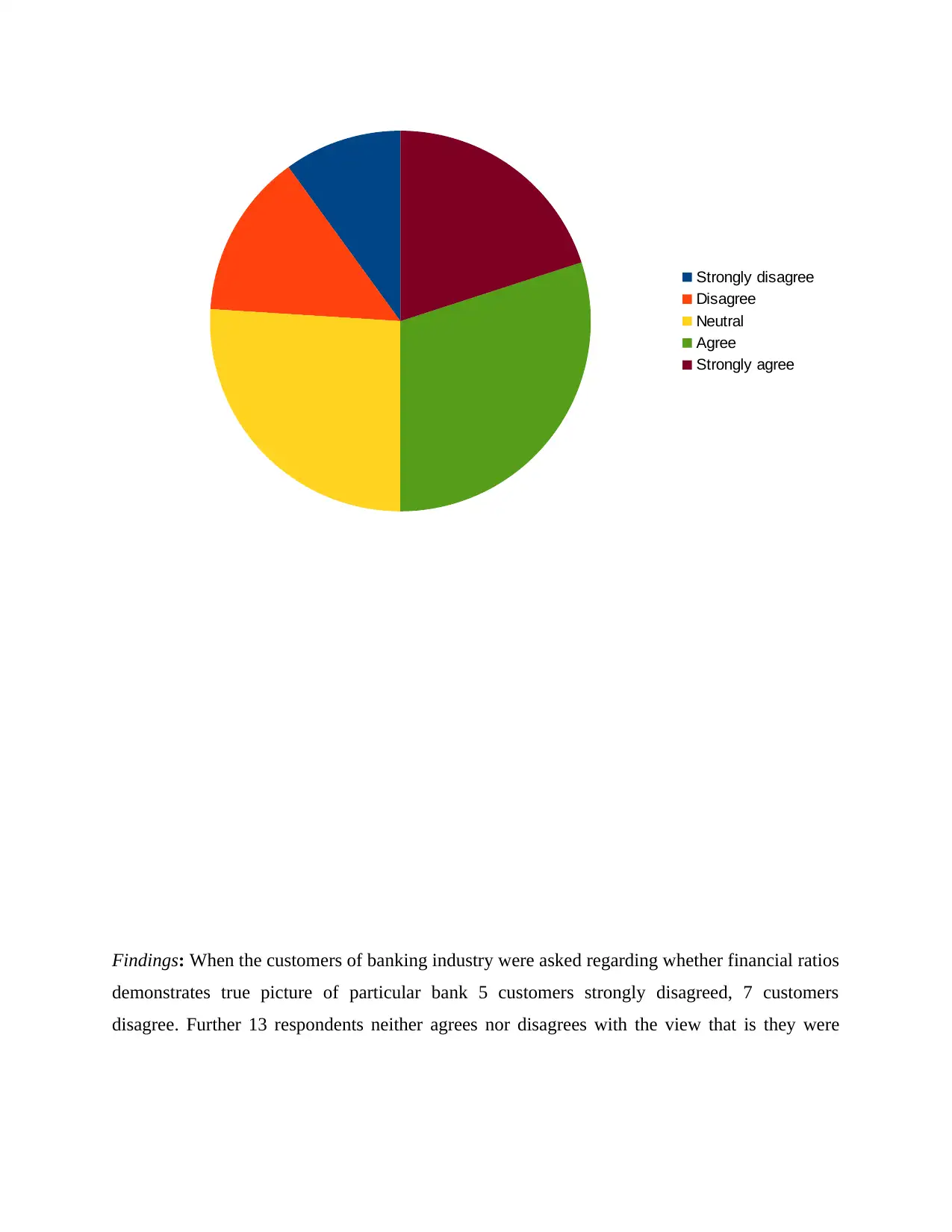
Findings: When the customers of banking industry were asked regarding whether financial ratios
demonstrates true picture of particular bank 5 customers strongly disagreed, 7 customers
disagree. Further 13 respondents neither agrees nor disagrees with the view that is they were
Strongly disagree
Disagree
Neutral
Agree
Strongly agree
demonstrates true picture of particular bank 5 customers strongly disagreed, 7 customers
disagree. Further 13 respondents neither agrees nor disagrees with the view that is they were
Strongly disagree
Disagree
Neutral
Agree
Strongly agree
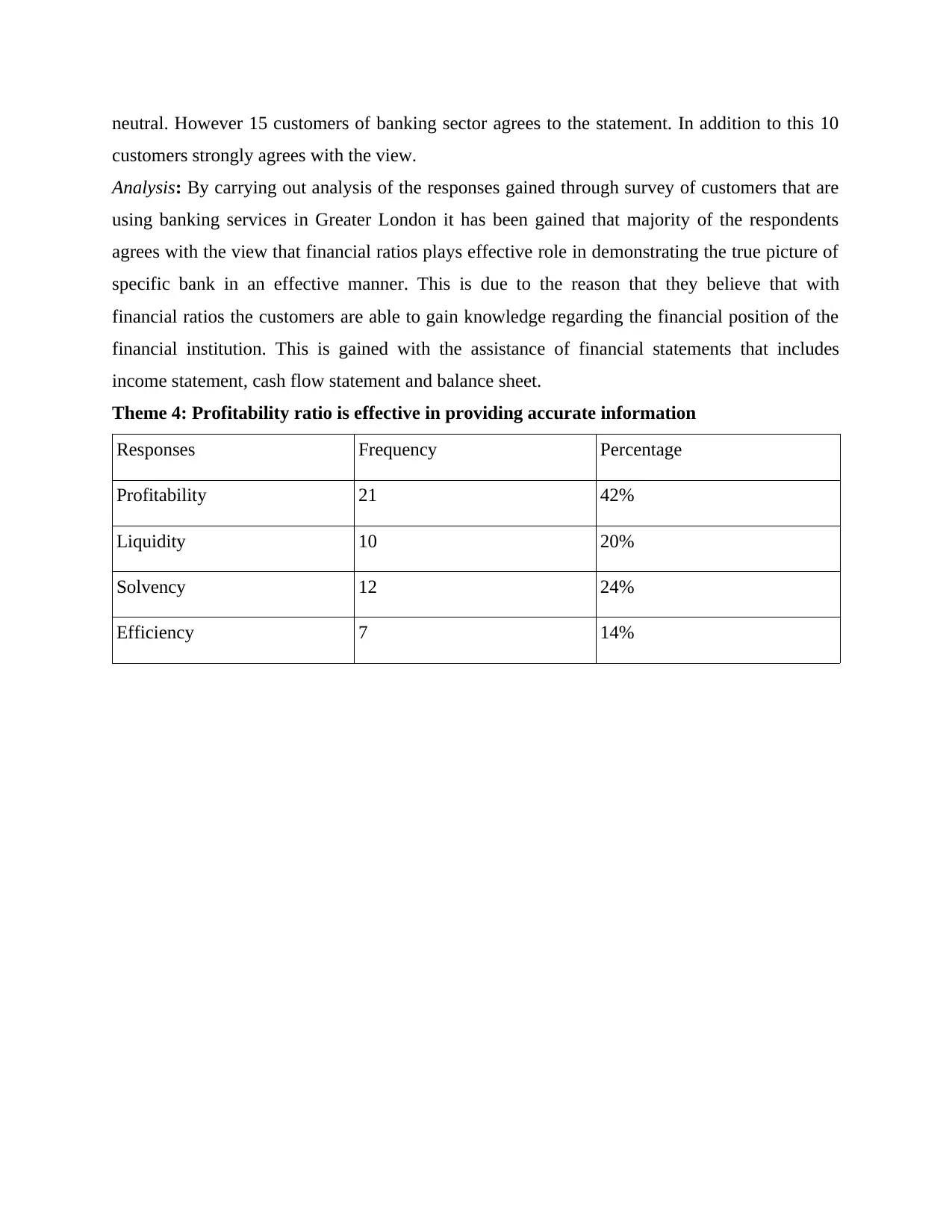
neutral. However 15 customers of banking sector agrees to the statement. In addition to this 10
customers strongly agrees with the view.
Analysis: By carrying out analysis of the responses gained through survey of customers that are
using banking services in Greater London it has been gained that majority of the respondents
agrees with the view that financial ratios plays effective role in demonstrating the true picture of
specific bank in an effective manner. This is due to the reason that they believe that with
financial ratios the customers are able to gain knowledge regarding the financial position of the
financial institution. This is gained with the assistance of financial statements that includes
income statement, cash flow statement and balance sheet.
Theme 4: Profitability ratio is effective in providing accurate information
Responses Frequency Percentage
Profitability 21 42%
Liquidity 10 20%
Solvency 12 24%
Efficiency 7 14%
customers strongly agrees with the view.
Analysis: By carrying out analysis of the responses gained through survey of customers that are
using banking services in Greater London it has been gained that majority of the respondents
agrees with the view that financial ratios plays effective role in demonstrating the true picture of
specific bank in an effective manner. This is due to the reason that they believe that with
financial ratios the customers are able to gain knowledge regarding the financial position of the
financial institution. This is gained with the assistance of financial statements that includes
income statement, cash flow statement and balance sheet.
Theme 4: Profitability ratio is effective in providing accurate information
Responses Frequency Percentage
Profitability 21 42%
Liquidity 10 20%
Solvency 12 24%
Efficiency 7 14%
Secure Best Marks with AI Grader
Need help grading? Try our AI Grader for instant feedback on your assignments.
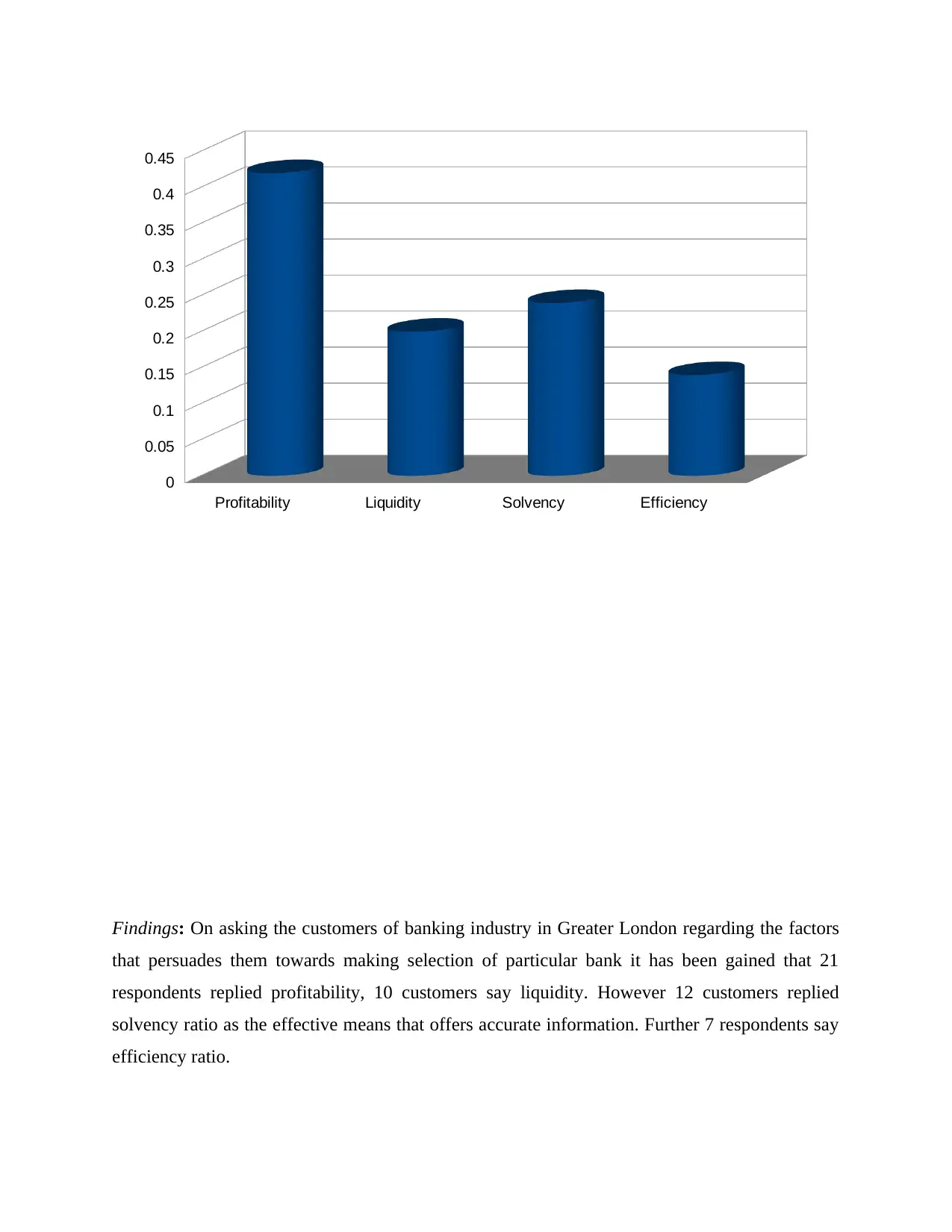
Findings: On asking the customers of banking industry in Greater London regarding the factors
that persuades them towards making selection of particular bank it has been gained that 21
respondents replied profitability, 10 customers say liquidity. However 12 customers replied
solvency ratio as the effective means that offers accurate information. Further 7 respondents say
efficiency ratio.
Profitability Liquidity Solvency Efficiency
0
0.05
0.1
0.15
0.2
0.25
0.3
0.35
0.4
0.45
that persuades them towards making selection of particular bank it has been gained that 21
respondents replied profitability, 10 customers say liquidity. However 12 customers replied
solvency ratio as the effective means that offers accurate information. Further 7 respondents say
efficiency ratio.
Profitability Liquidity Solvency Efficiency
0
0.05
0.1
0.15
0.2
0.25
0.3
0.35
0.4
0.45
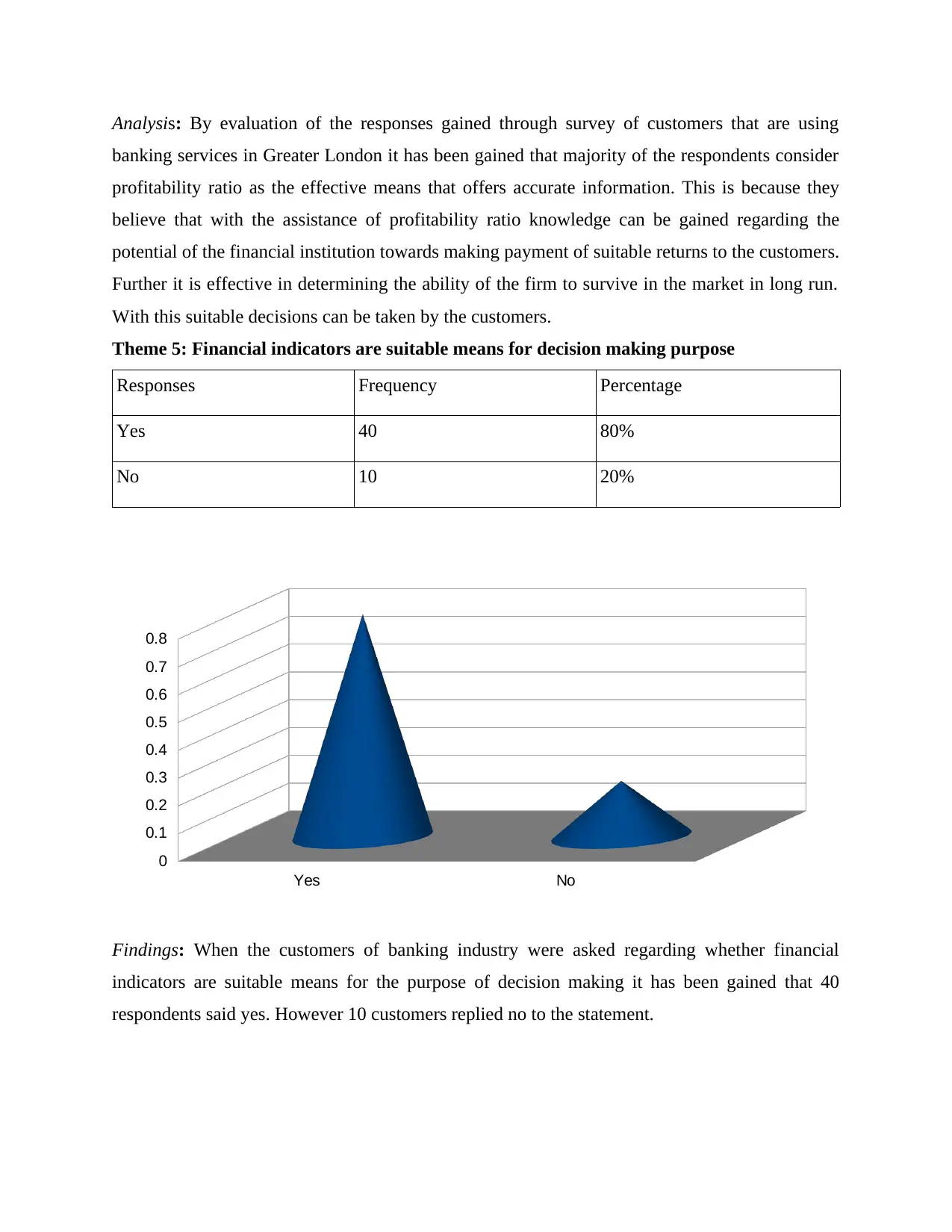
Analysis: By evaluation of the responses gained through survey of customers that are using
banking services in Greater London it has been gained that majority of the respondents consider
profitability ratio as the effective means that offers accurate information. This is because they
believe that with the assistance of profitability ratio knowledge can be gained regarding the
potential of the financial institution towards making payment of suitable returns to the customers.
Further it is effective in determining the ability of the firm to survive in the market in long run.
With this suitable decisions can be taken by the customers.
Theme 5: Financial indicators are suitable means for decision making purpose
Responses Frequency Percentage
Yes 40 80%
No 10 20%
Findings: When the customers of banking industry were asked regarding whether financial
indicators are suitable means for the purpose of decision making it has been gained that 40
respondents said yes. However 10 customers replied no to the statement.
Yes No
0
0.1
0.2
0.3
0.4
0.5
0.6
0.7
0.8
banking services in Greater London it has been gained that majority of the respondents consider
profitability ratio as the effective means that offers accurate information. This is because they
believe that with the assistance of profitability ratio knowledge can be gained regarding the
potential of the financial institution towards making payment of suitable returns to the customers.
Further it is effective in determining the ability of the firm to survive in the market in long run.
With this suitable decisions can be taken by the customers.
Theme 5: Financial indicators are suitable means for decision making purpose
Responses Frequency Percentage
Yes 40 80%
No 10 20%
Findings: When the customers of banking industry were asked regarding whether financial
indicators are suitable means for the purpose of decision making it has been gained that 40
respondents said yes. However 10 customers replied no to the statement.
Yes No
0
0.1
0.2
0.3
0.4
0.5
0.6
0.7
0.8
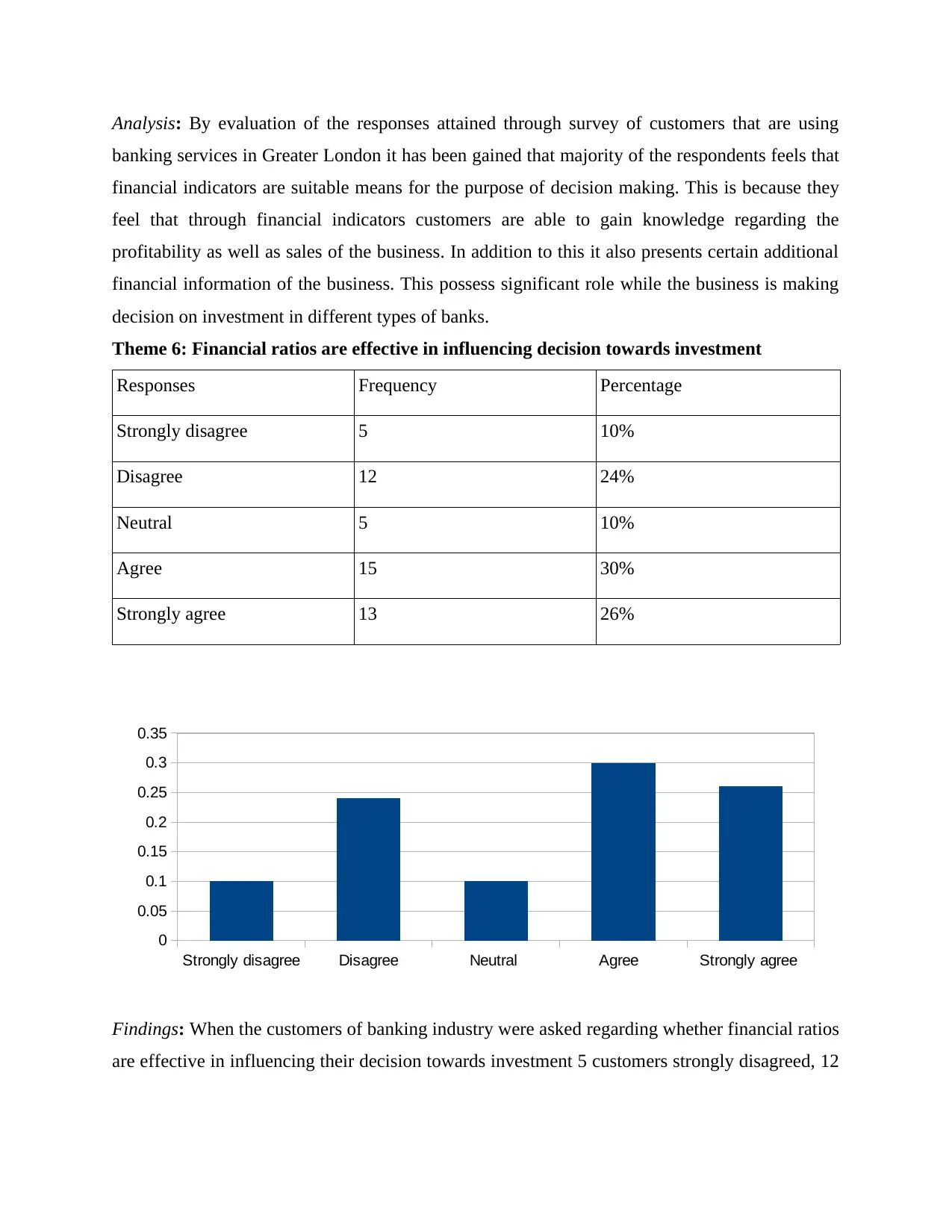
Analysis: By evaluation of the responses attained through survey of customers that are using
banking services in Greater London it has been gained that majority of the respondents feels that
financial indicators are suitable means for the purpose of decision making. This is because they
feel that through financial indicators customers are able to gain knowledge regarding the
profitability as well as sales of the business. In addition to this it also presents certain additional
financial information of the business. This possess significant role while the business is making
decision on investment in different types of banks.
Theme 6: Financial ratios are effective in influencing decision towards investment
Responses Frequency Percentage
Strongly disagree 5 10%
Disagree 12 24%
Neutral 5 10%
Agree 15 30%
Strongly agree 13 26%
Findings: When the customers of banking industry were asked regarding whether financial ratios
are effective in influencing their decision towards investment 5 customers strongly disagreed, 12
Strongly disagree Disagree Neutral Agree Strongly agree
0
0.05
0.1
0.15
0.2
0.25
0.3
0.35
banking services in Greater London it has been gained that majority of the respondents feels that
financial indicators are suitable means for the purpose of decision making. This is because they
feel that through financial indicators customers are able to gain knowledge regarding the
profitability as well as sales of the business. In addition to this it also presents certain additional
financial information of the business. This possess significant role while the business is making
decision on investment in different types of banks.
Theme 6: Financial ratios are effective in influencing decision towards investment
Responses Frequency Percentage
Strongly disagree 5 10%
Disagree 12 24%
Neutral 5 10%
Agree 15 30%
Strongly agree 13 26%
Findings: When the customers of banking industry were asked regarding whether financial ratios
are effective in influencing their decision towards investment 5 customers strongly disagreed, 12
Strongly disagree Disagree Neutral Agree Strongly agree
0
0.05
0.1
0.15
0.2
0.25
0.3
0.35
Paraphrase This Document
Need a fresh take? Get an instant paraphrase of this document with our AI Paraphraser
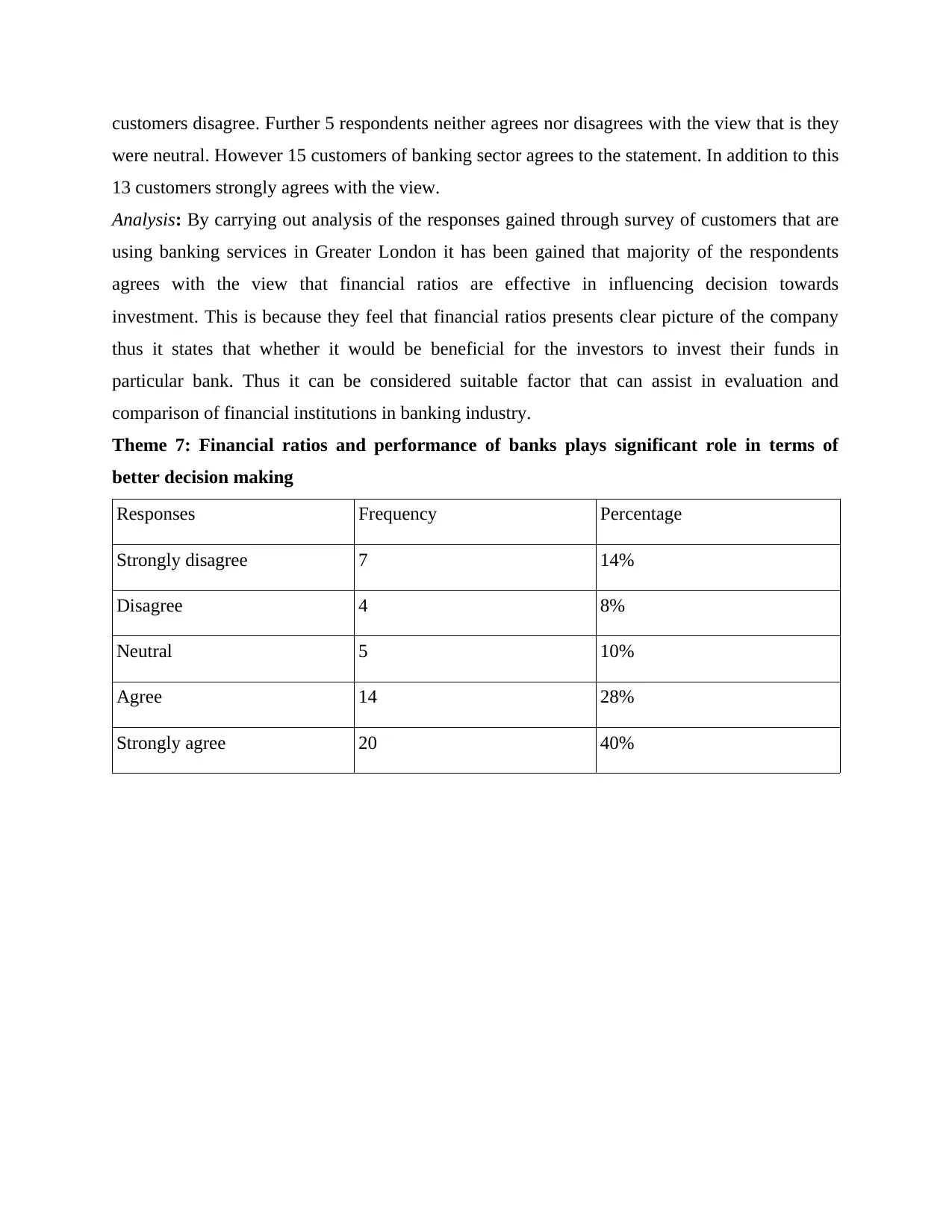
customers disagree. Further 5 respondents neither agrees nor disagrees with the view that is they
were neutral. However 15 customers of banking sector agrees to the statement. In addition to this
13 customers strongly agrees with the view.
Analysis: By carrying out analysis of the responses gained through survey of customers that are
using banking services in Greater London it has been gained that majority of the respondents
agrees with the view that financial ratios are effective in influencing decision towards
investment. This is because they feel that financial ratios presents clear picture of the company
thus it states that whether it would be beneficial for the investors to invest their funds in
particular bank. Thus it can be considered suitable factor that can assist in evaluation and
comparison of financial institutions in banking industry.
Theme 7: Financial ratios and performance of banks plays significant role in terms of
better decision making
Responses Frequency Percentage
Strongly disagree 7 14%
Disagree 4 8%
Neutral 5 10%
Agree 14 28%
Strongly agree 20 40%
were neutral. However 15 customers of banking sector agrees to the statement. In addition to this
13 customers strongly agrees with the view.
Analysis: By carrying out analysis of the responses gained through survey of customers that are
using banking services in Greater London it has been gained that majority of the respondents
agrees with the view that financial ratios are effective in influencing decision towards
investment. This is because they feel that financial ratios presents clear picture of the company
thus it states that whether it would be beneficial for the investors to invest their funds in
particular bank. Thus it can be considered suitable factor that can assist in evaluation and
comparison of financial institutions in banking industry.
Theme 7: Financial ratios and performance of banks plays significant role in terms of
better decision making
Responses Frequency Percentage
Strongly disagree 7 14%
Disagree 4 8%
Neutral 5 10%
Agree 14 28%
Strongly agree 20 40%
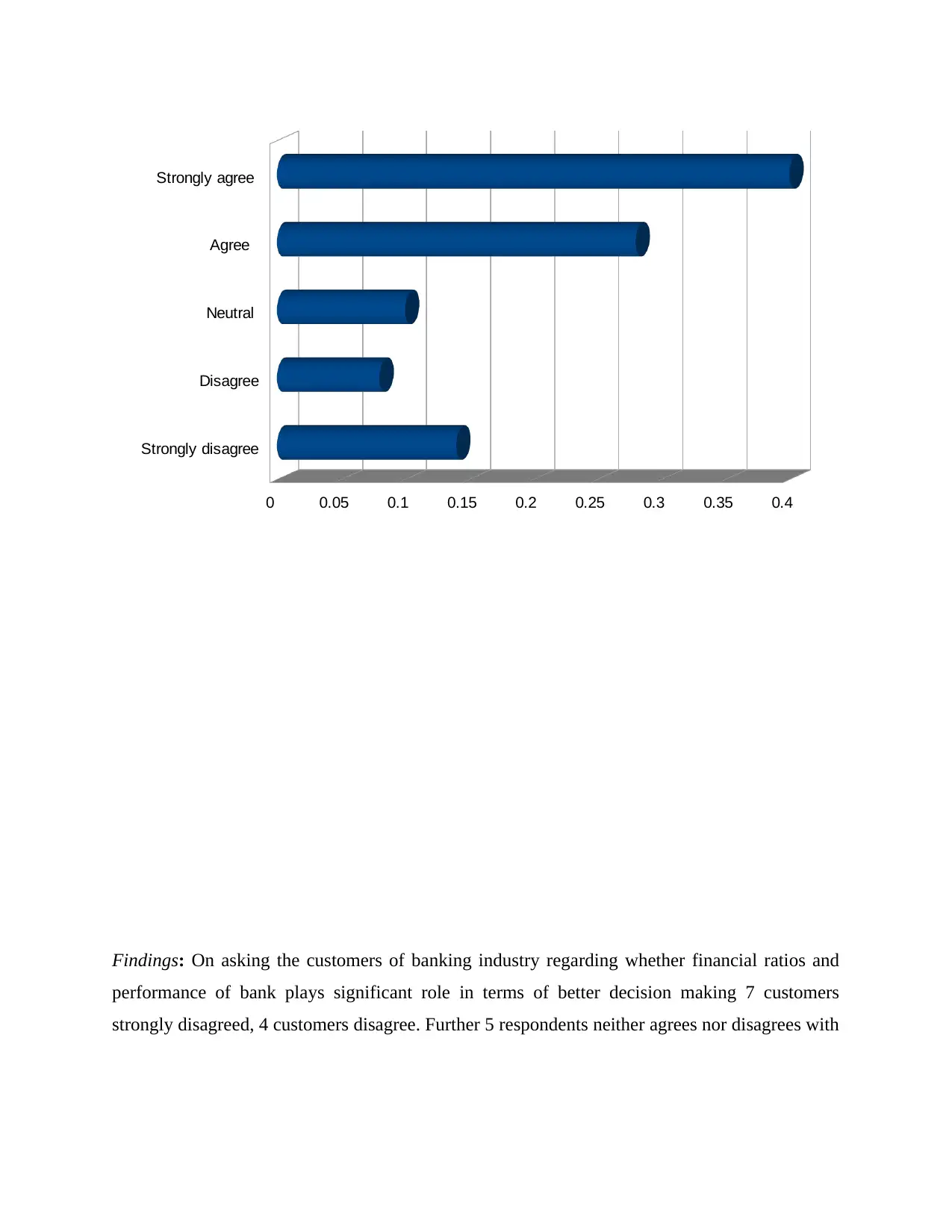
Findings: On asking the customers of banking industry regarding whether financial ratios and
performance of bank plays significant role in terms of better decision making 7 customers
strongly disagreed, 4 customers disagree. Further 5 respondents neither agrees nor disagrees with
Strongly disagree
Disagree
Neutral
Agree
Strongly agree
0 0.05 0.1 0.15 0.2 0.25 0.3 0.35 0.4
performance of bank plays significant role in terms of better decision making 7 customers
strongly disagreed, 4 customers disagree. Further 5 respondents neither agrees nor disagrees with
Strongly disagree
Disagree
Neutral
Agree
Strongly agree
0 0.05 0.1 0.15 0.2 0.25 0.3 0.35 0.4
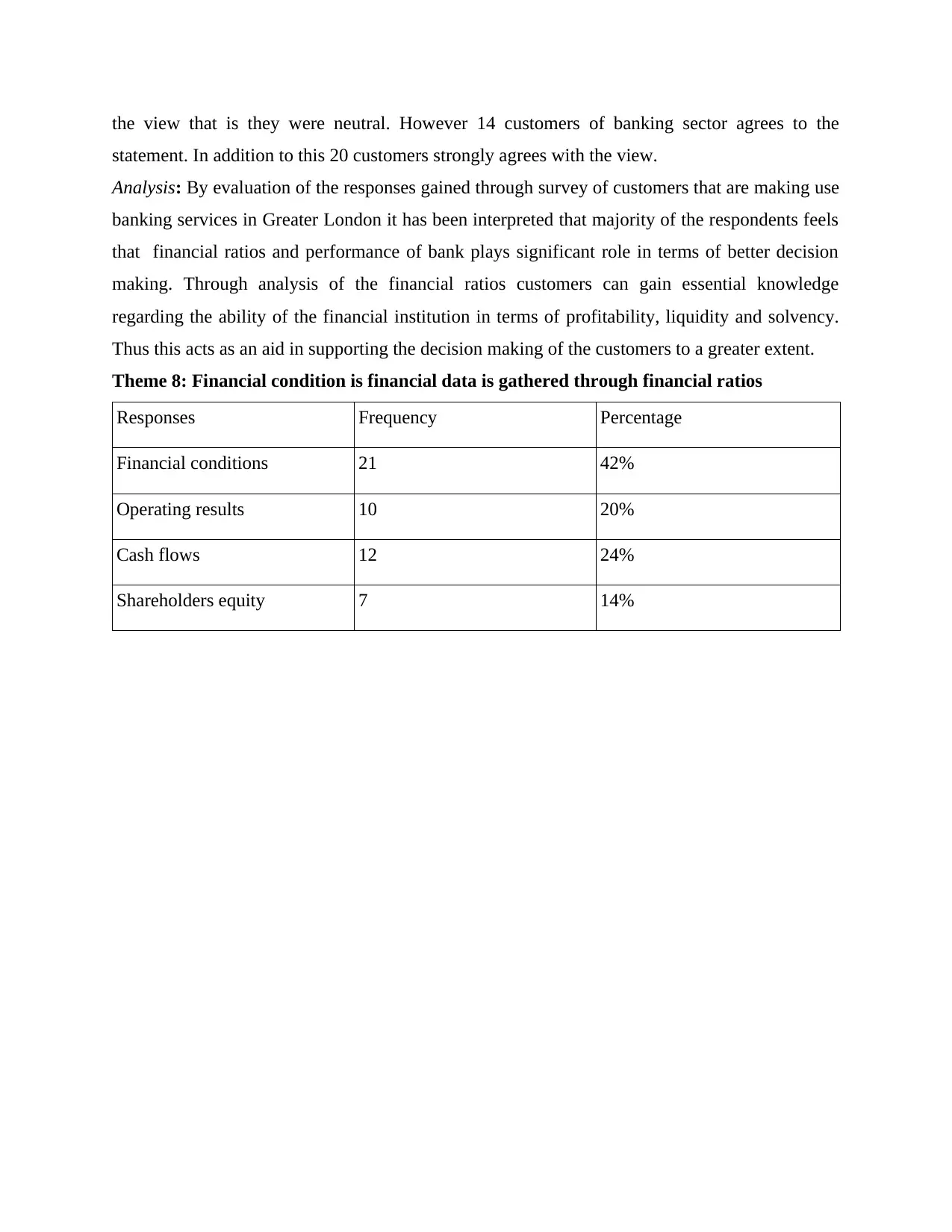
the view that is they were neutral. However 14 customers of banking sector agrees to the
statement. In addition to this 20 customers strongly agrees with the view.
Analysis: By evaluation of the responses gained through survey of customers that are making use
banking services in Greater London it has been interpreted that majority of the respondents feels
that financial ratios and performance of bank plays significant role in terms of better decision
making. Through analysis of the financial ratios customers can gain essential knowledge
regarding the ability of the financial institution in terms of profitability, liquidity and solvency.
Thus this acts as an aid in supporting the decision making of the customers to a greater extent.
Theme 8: Financial condition is financial data is gathered through financial ratios
Responses Frequency Percentage
Financial conditions 21 42%
Operating results 10 20%
Cash flows 12 24%
Shareholders equity 7 14%
statement. In addition to this 20 customers strongly agrees with the view.
Analysis: By evaluation of the responses gained through survey of customers that are making use
banking services in Greater London it has been interpreted that majority of the respondents feels
that financial ratios and performance of bank plays significant role in terms of better decision
making. Through analysis of the financial ratios customers can gain essential knowledge
regarding the ability of the financial institution in terms of profitability, liquidity and solvency.
Thus this acts as an aid in supporting the decision making of the customers to a greater extent.
Theme 8: Financial condition is financial data is gathered through financial ratios
Responses Frequency Percentage
Financial conditions 21 42%
Operating results 10 20%
Cash flows 12 24%
Shareholders equity 7 14%
Secure Best Marks with AI Grader
Need help grading? Try our AI Grader for instant feedback on your assignments.
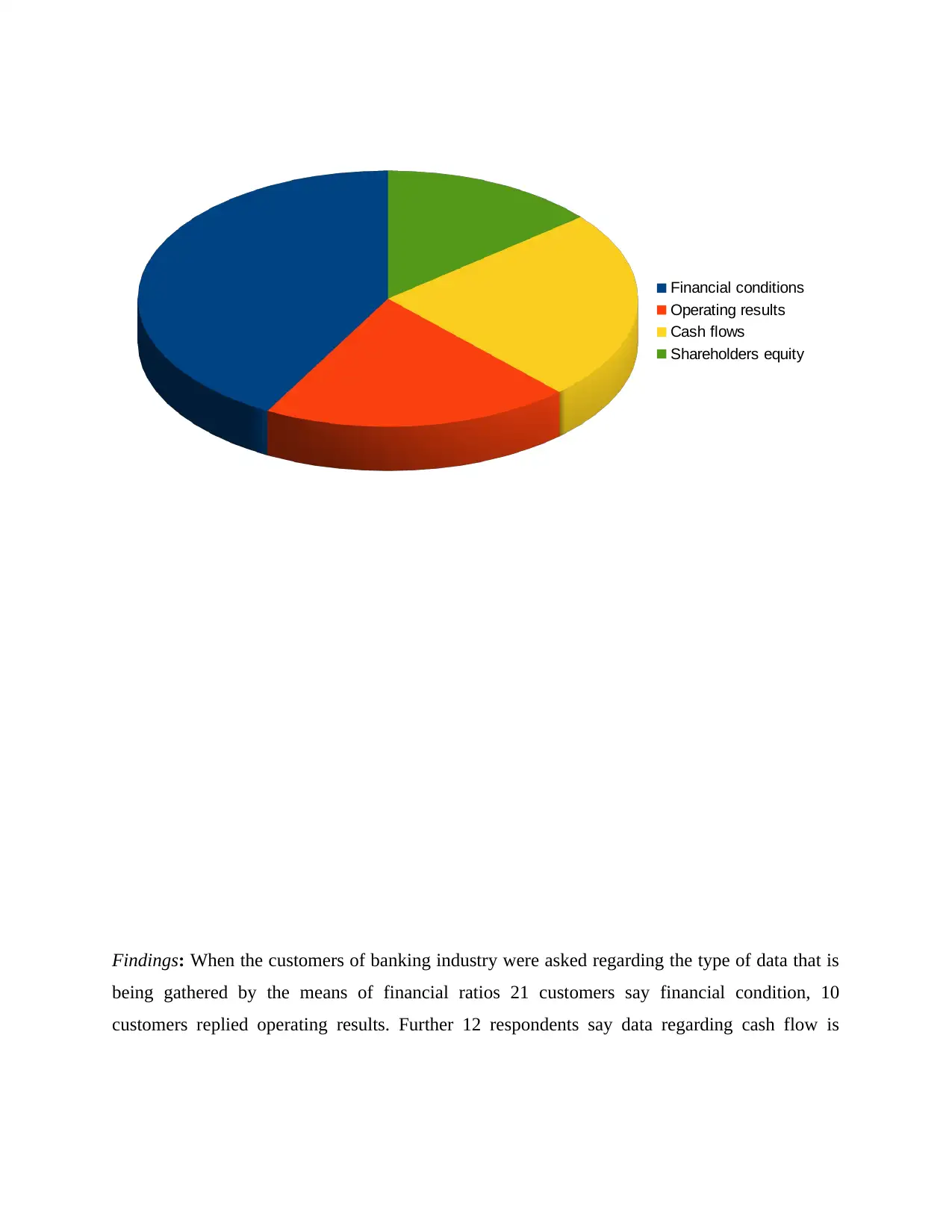
Findings: When the customers of banking industry were asked regarding the type of data that is
being gathered by the means of financial ratios 21 customers say financial condition, 10
customers replied operating results. Further 12 respondents say data regarding cash flow is
Financial conditions
Operating results
Cash flows
Shareholders equity
being gathered by the means of financial ratios 21 customers say financial condition, 10
customers replied operating results. Further 12 respondents say data regarding cash flow is
Financial conditions
Operating results
Cash flows
Shareholders equity
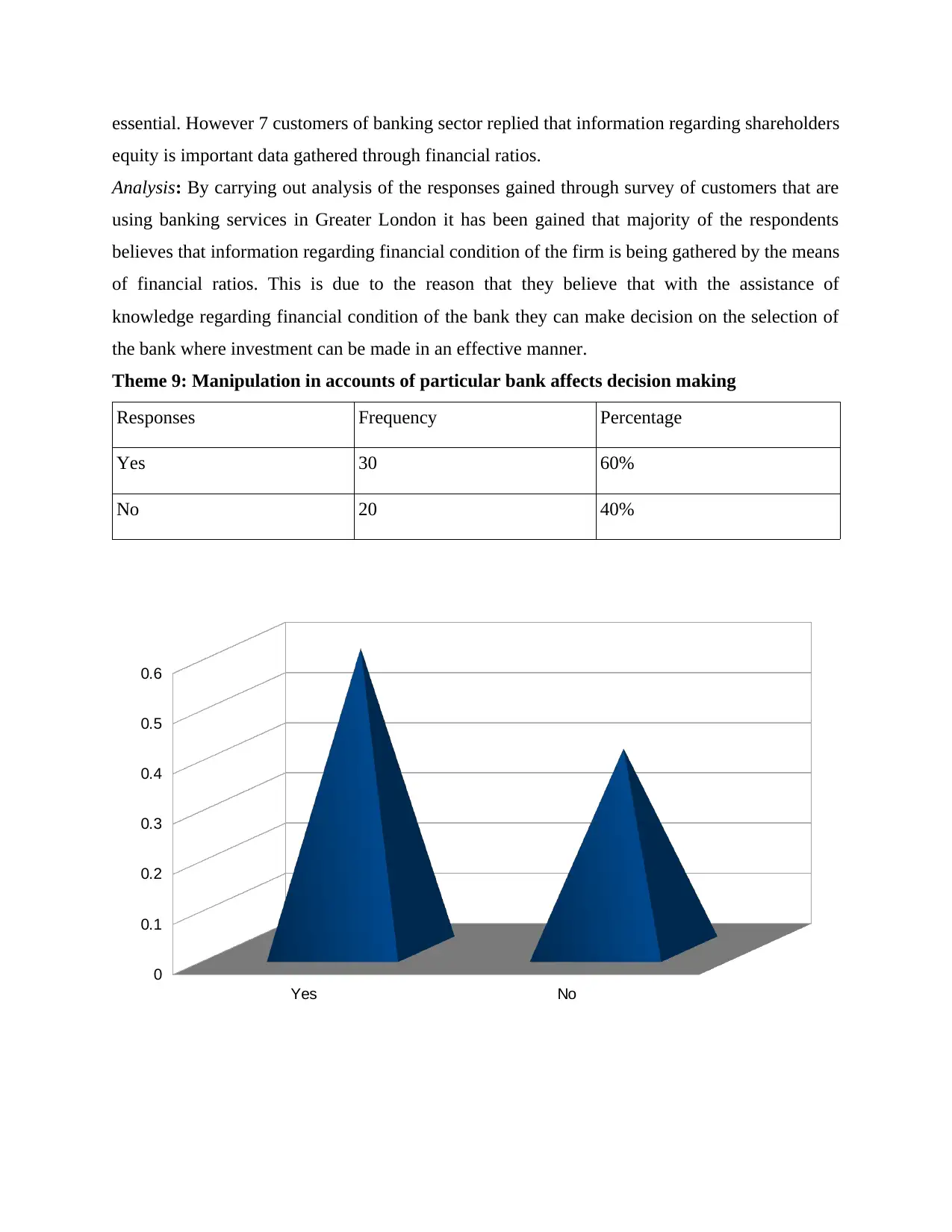
essential. However 7 customers of banking sector replied that information regarding shareholders
equity is important data gathered through financial ratios.
Analysis: By carrying out analysis of the responses gained through survey of customers that are
using banking services in Greater London it has been gained that majority of the respondents
believes that information regarding financial condition of the firm is being gathered by the means
of financial ratios. This is due to the reason that they believe that with the assistance of
knowledge regarding financial condition of the bank they can make decision on the selection of
the bank where investment can be made in an effective manner.
Theme 9: Manipulation in accounts of particular bank affects decision making
Responses Frequency Percentage
Yes 30 60%
No 20 40%
Yes No
0
0.1
0.2
0.3
0.4
0.5
0.6
equity is important data gathered through financial ratios.
Analysis: By carrying out analysis of the responses gained through survey of customers that are
using banking services in Greater London it has been gained that majority of the respondents
believes that information regarding financial condition of the firm is being gathered by the means
of financial ratios. This is due to the reason that they believe that with the assistance of
knowledge regarding financial condition of the bank they can make decision on the selection of
the bank where investment can be made in an effective manner.
Theme 9: Manipulation in accounts of particular bank affects decision making
Responses Frequency Percentage
Yes 30 60%
No 20 40%
Yes No
0
0.1
0.2
0.3
0.4
0.5
0.6
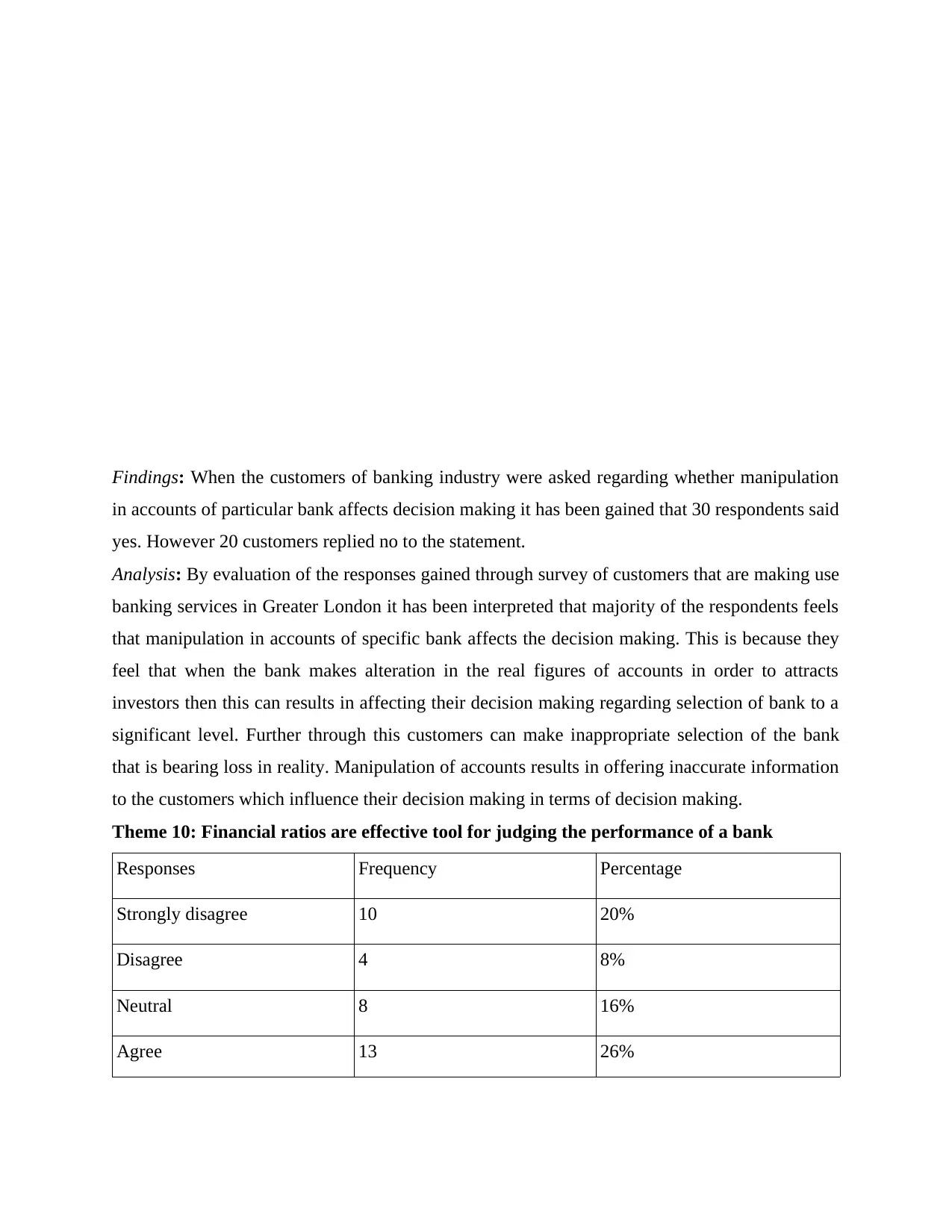
Findings: When the customers of banking industry were asked regarding whether manipulation
in accounts of particular bank affects decision making it has been gained that 30 respondents said
yes. However 20 customers replied no to the statement.
Analysis: By evaluation of the responses gained through survey of customers that are making use
banking services in Greater London it has been interpreted that majority of the respondents feels
that manipulation in accounts of specific bank affects the decision making. This is because they
feel that when the bank makes alteration in the real figures of accounts in order to attracts
investors then this can results in affecting their decision making regarding selection of bank to a
significant level. Further through this customers can make inappropriate selection of the bank
that is bearing loss in reality. Manipulation of accounts results in offering inaccurate information
to the customers which influence their decision making in terms of decision making.
Theme 10: Financial ratios are effective tool for judging the performance of a bank
Responses Frequency Percentage
Strongly disagree 10 20%
Disagree 4 8%
Neutral 8 16%
Agree 13 26%
in accounts of particular bank affects decision making it has been gained that 30 respondents said
yes. However 20 customers replied no to the statement.
Analysis: By evaluation of the responses gained through survey of customers that are making use
banking services in Greater London it has been interpreted that majority of the respondents feels
that manipulation in accounts of specific bank affects the decision making. This is because they
feel that when the bank makes alteration in the real figures of accounts in order to attracts
investors then this can results in affecting their decision making regarding selection of bank to a
significant level. Further through this customers can make inappropriate selection of the bank
that is bearing loss in reality. Manipulation of accounts results in offering inaccurate information
to the customers which influence their decision making in terms of decision making.
Theme 10: Financial ratios are effective tool for judging the performance of a bank
Responses Frequency Percentage
Strongly disagree 10 20%
Disagree 4 8%
Neutral 8 16%
Agree 13 26%
Paraphrase This Document
Need a fresh take? Get an instant paraphrase of this document with our AI Paraphraser
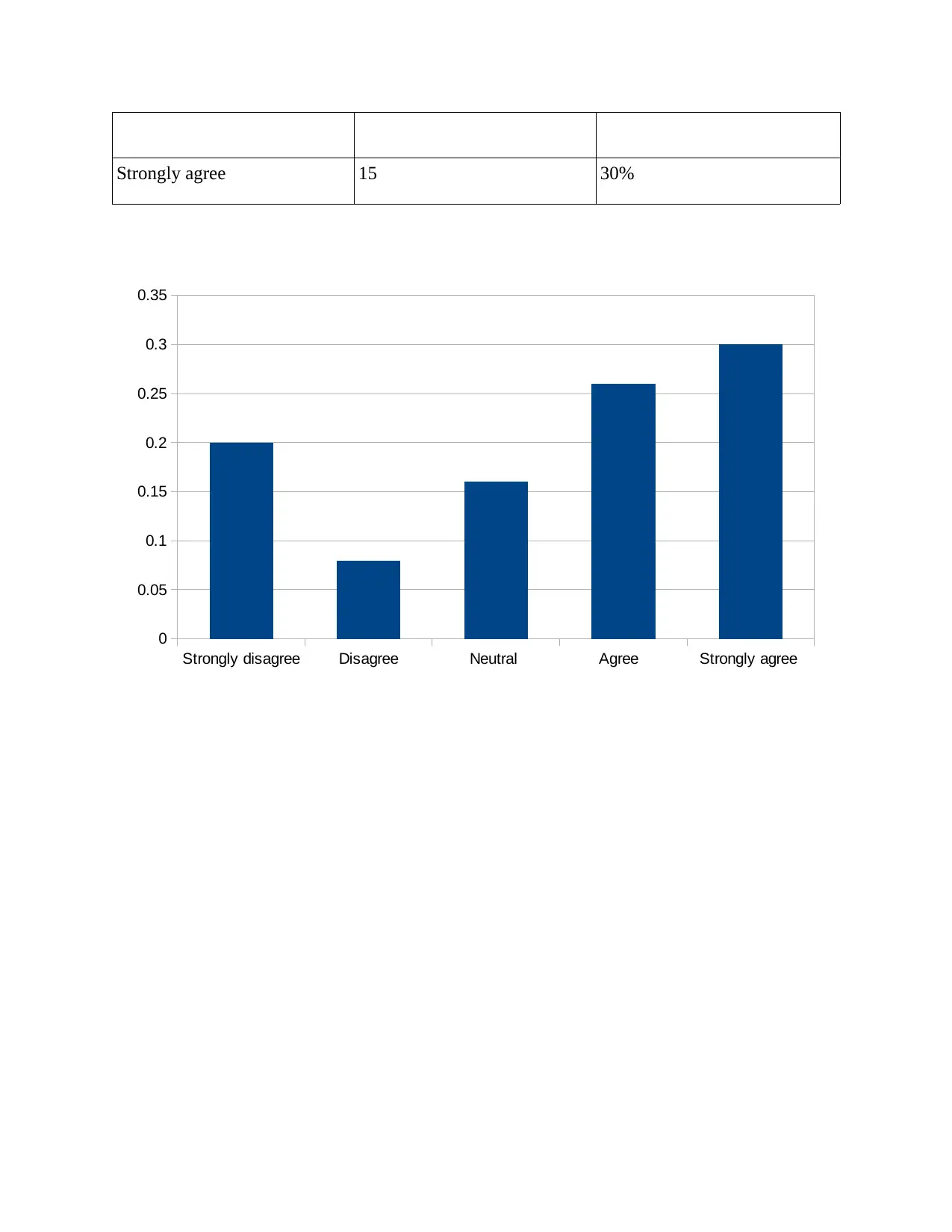
Strongly agree 15 30%
Strongly disagree Disagree Neutral Agree Strongly agree
0
0.05
0.1
0.15
0.2
0.25
0.3
0.35
Strongly disagree Disagree Neutral Agree Strongly agree
0
0.05
0.1
0.15
0.2
0.25
0.3
0.35
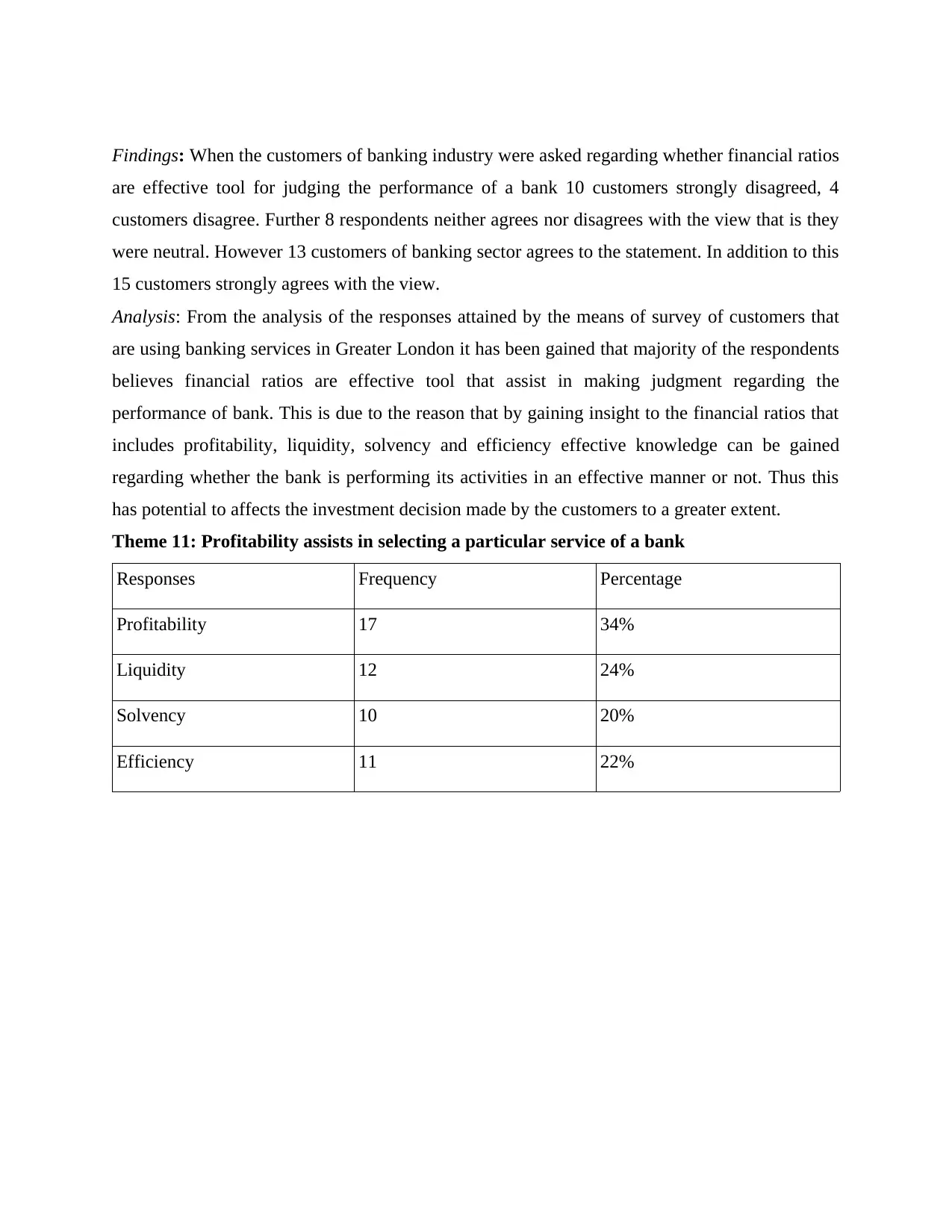
Findings: When the customers of banking industry were asked regarding whether financial ratios
are effective tool for judging the performance of a bank 10 customers strongly disagreed, 4
customers disagree. Further 8 respondents neither agrees nor disagrees with the view that is they
were neutral. However 13 customers of banking sector agrees to the statement. In addition to this
15 customers strongly agrees with the view.
Analysis: From the analysis of the responses attained by the means of survey of customers that
are using banking services in Greater London it has been gained that majority of the respondents
believes financial ratios are effective tool that assist in making judgment regarding the
performance of bank. This is due to the reason that by gaining insight to the financial ratios that
includes profitability, liquidity, solvency and efficiency effective knowledge can be gained
regarding whether the bank is performing its activities in an effective manner or not. Thus this
has potential to affects the investment decision made by the customers to a greater extent.
Theme 11: Profitability assists in selecting a particular service of a bank
Responses Frequency Percentage
Profitability 17 34%
Liquidity 12 24%
Solvency 10 20%
Efficiency 11 22%
are effective tool for judging the performance of a bank 10 customers strongly disagreed, 4
customers disagree. Further 8 respondents neither agrees nor disagrees with the view that is they
were neutral. However 13 customers of banking sector agrees to the statement. In addition to this
15 customers strongly agrees with the view.
Analysis: From the analysis of the responses attained by the means of survey of customers that
are using banking services in Greater London it has been gained that majority of the respondents
believes financial ratios are effective tool that assist in making judgment regarding the
performance of bank. This is due to the reason that by gaining insight to the financial ratios that
includes profitability, liquidity, solvency and efficiency effective knowledge can be gained
regarding whether the bank is performing its activities in an effective manner or not. Thus this
has potential to affects the investment decision made by the customers to a greater extent.
Theme 11: Profitability assists in selecting a particular service of a bank
Responses Frequency Percentage
Profitability 17 34%
Liquidity 12 24%
Solvency 10 20%
Efficiency 11 22%
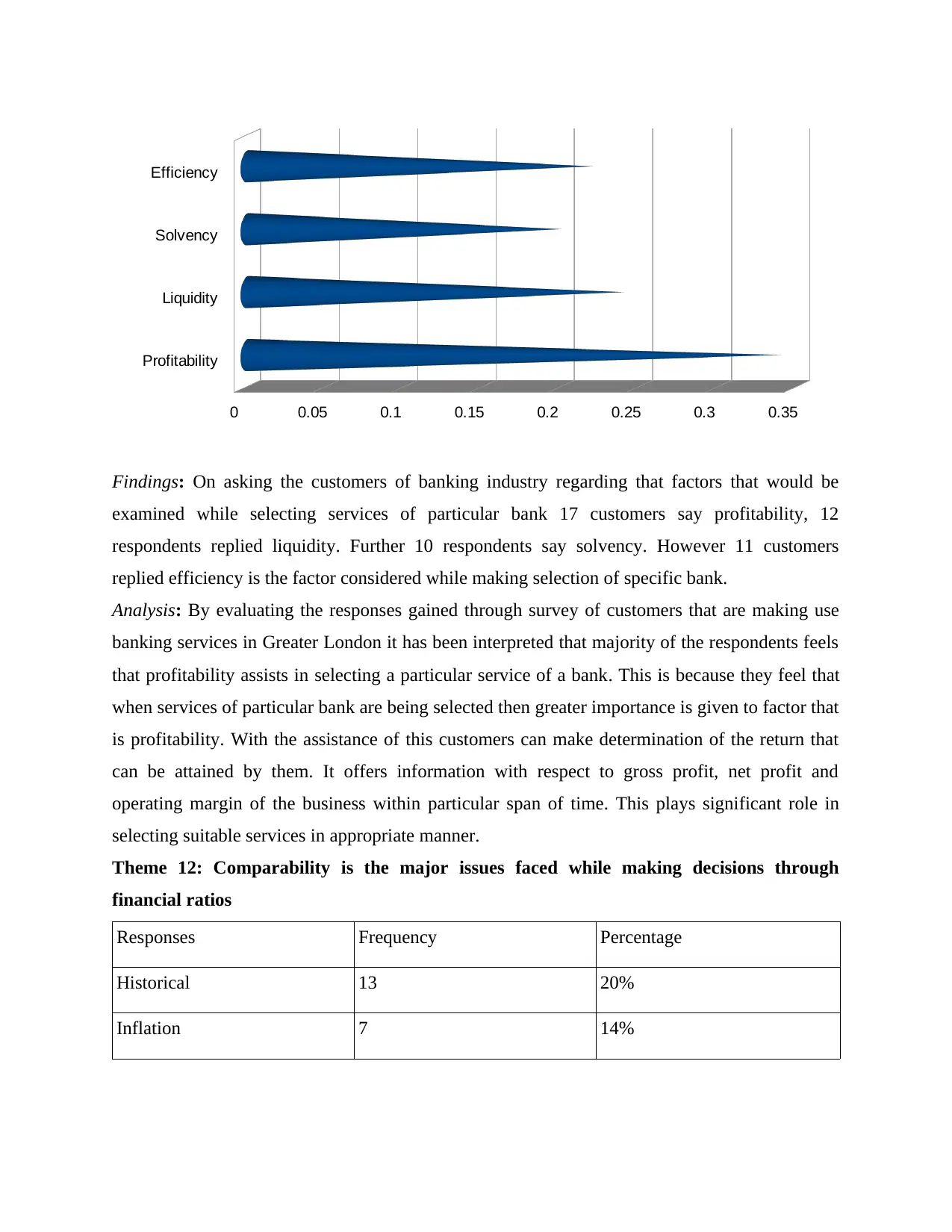
Findings: On asking the customers of banking industry regarding that factors that would be
examined while selecting services of particular bank 17 customers say profitability, 12
respondents replied liquidity. Further 10 respondents say solvency. However 11 customers
replied efficiency is the factor considered while making selection of specific bank.
Analysis: By evaluating the responses gained through survey of customers that are making use
banking services in Greater London it has been interpreted that majority of the respondents feels
that profitability assists in selecting a particular service of a bank. This is because they feel that
when services of particular bank are being selected then greater importance is given to factor that
is profitability. With the assistance of this customers can make determination of the return that
can be attained by them. It offers information with respect to gross profit, net profit and
operating margin of the business within particular span of time. This plays significant role in
selecting suitable services in appropriate manner.
Theme 12: Comparability is the major issues faced while making decisions through
financial ratios
Responses Frequency Percentage
Historical 13 20%
Inflation 7 14%
Profitability
Liquidity
Solvency
Efficiency
0 0.05 0.1 0.15 0.2 0.25 0.3 0.35
examined while selecting services of particular bank 17 customers say profitability, 12
respondents replied liquidity. Further 10 respondents say solvency. However 11 customers
replied efficiency is the factor considered while making selection of specific bank.
Analysis: By evaluating the responses gained through survey of customers that are making use
banking services in Greater London it has been interpreted that majority of the respondents feels
that profitability assists in selecting a particular service of a bank. This is because they feel that
when services of particular bank are being selected then greater importance is given to factor that
is profitability. With the assistance of this customers can make determination of the return that
can be attained by them. It offers information with respect to gross profit, net profit and
operating margin of the business within particular span of time. This plays significant role in
selecting suitable services in appropriate manner.
Theme 12: Comparability is the major issues faced while making decisions through
financial ratios
Responses Frequency Percentage
Historical 13 20%
Inflation 7 14%
Profitability
Liquidity
Solvency
Efficiency
0 0.05 0.1 0.15 0.2 0.25 0.3 0.35
Secure Best Marks with AI Grader
Need help grading? Try our AI Grader for instant feedback on your assignments.
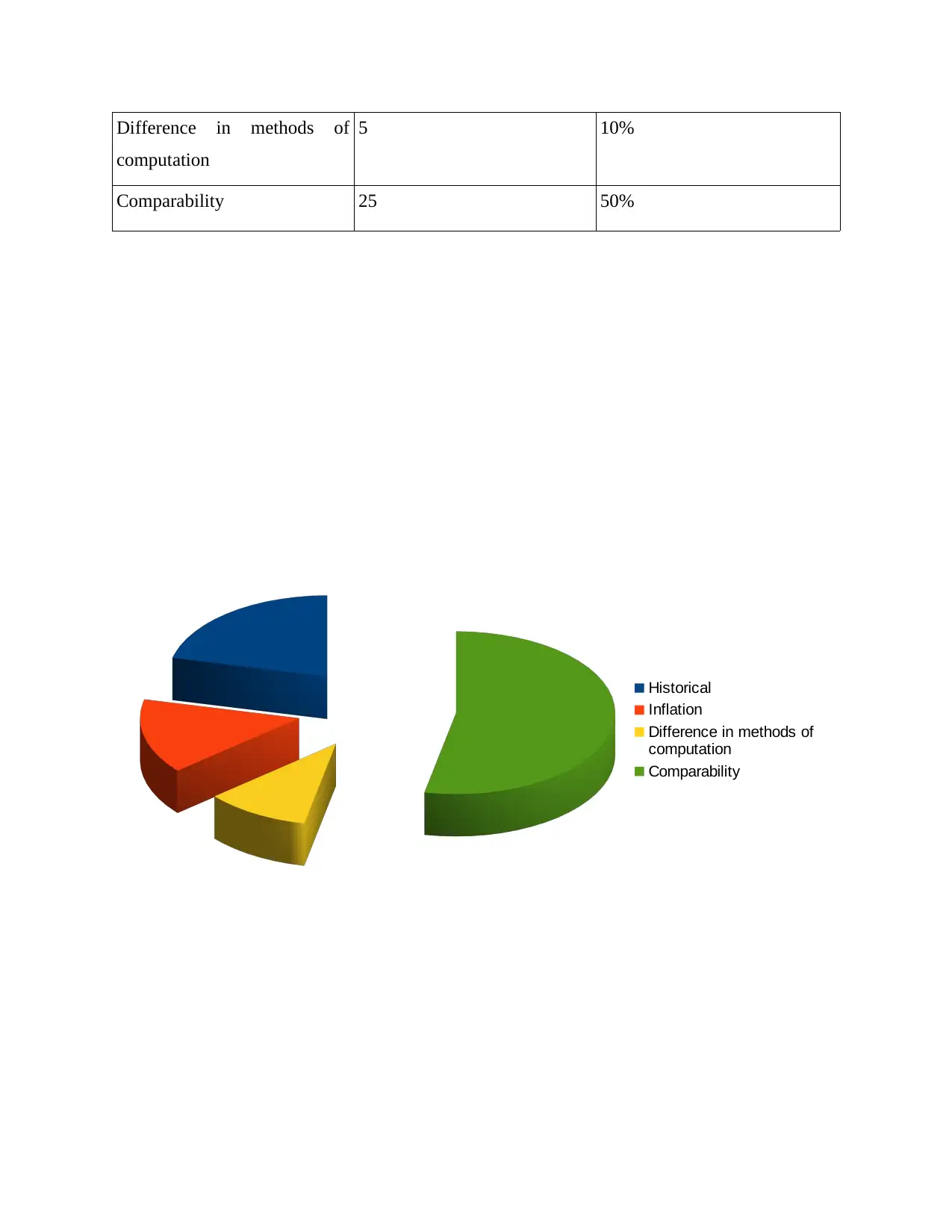
Difference in methods of
computation
5 10%
Comparability 25 50%
Historical
Inflation
Difference in methods of
computation
Comparability
computation
5 10%
Comparability 25 50%
Historical
Inflation
Difference in methods of
computation
Comparability
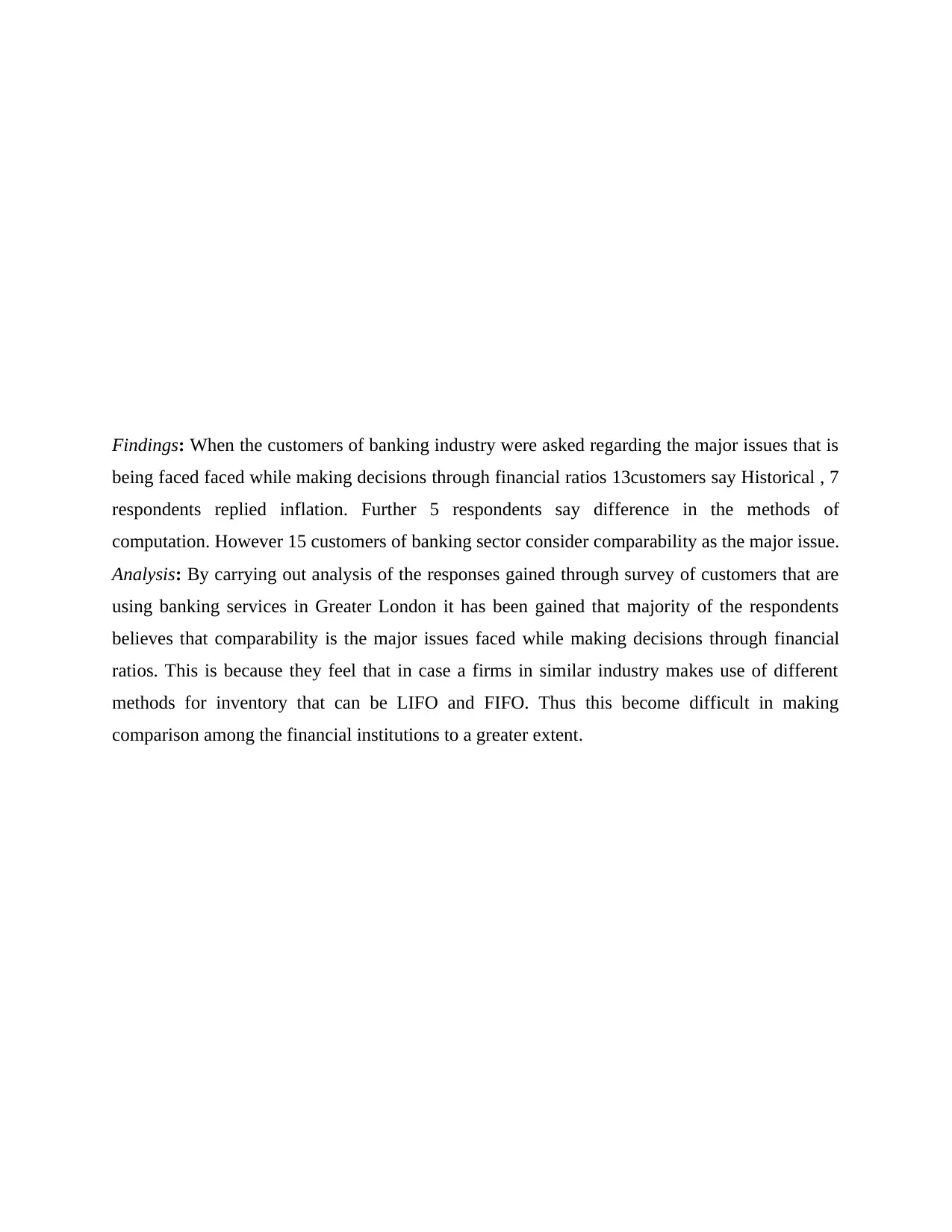
Findings: When the customers of banking industry were asked regarding the major issues that is
being faced faced while making decisions through financial ratios 13customers say Historical , 7
respondents replied inflation. Further 5 respondents say difference in the methods of
computation. However 15 customers of banking sector consider comparability as the major issue.
Analysis: By carrying out analysis of the responses gained through survey of customers that are
using banking services in Greater London it has been gained that majority of the respondents
believes that comparability is the major issues faced while making decisions through financial
ratios. This is because they feel that in case a firms in similar industry makes use of different
methods for inventory that can be LIFO and FIFO. Thus this become difficult in making
comparison among the financial institutions to a greater extent.
being faced faced while making decisions through financial ratios 13customers say Historical , 7
respondents replied inflation. Further 5 respondents say difference in the methods of
computation. However 15 customers of banking sector consider comparability as the major issue.
Analysis: By carrying out analysis of the responses gained through survey of customers that are
using banking services in Greater London it has been gained that majority of the respondents
believes that comparability is the major issues faced while making decisions through financial
ratios. This is because they feel that in case a firms in similar industry makes use of different
methods for inventory that can be LIFO and FIFO. Thus this become difficult in making
comparison among the financial institutions to a greater extent.
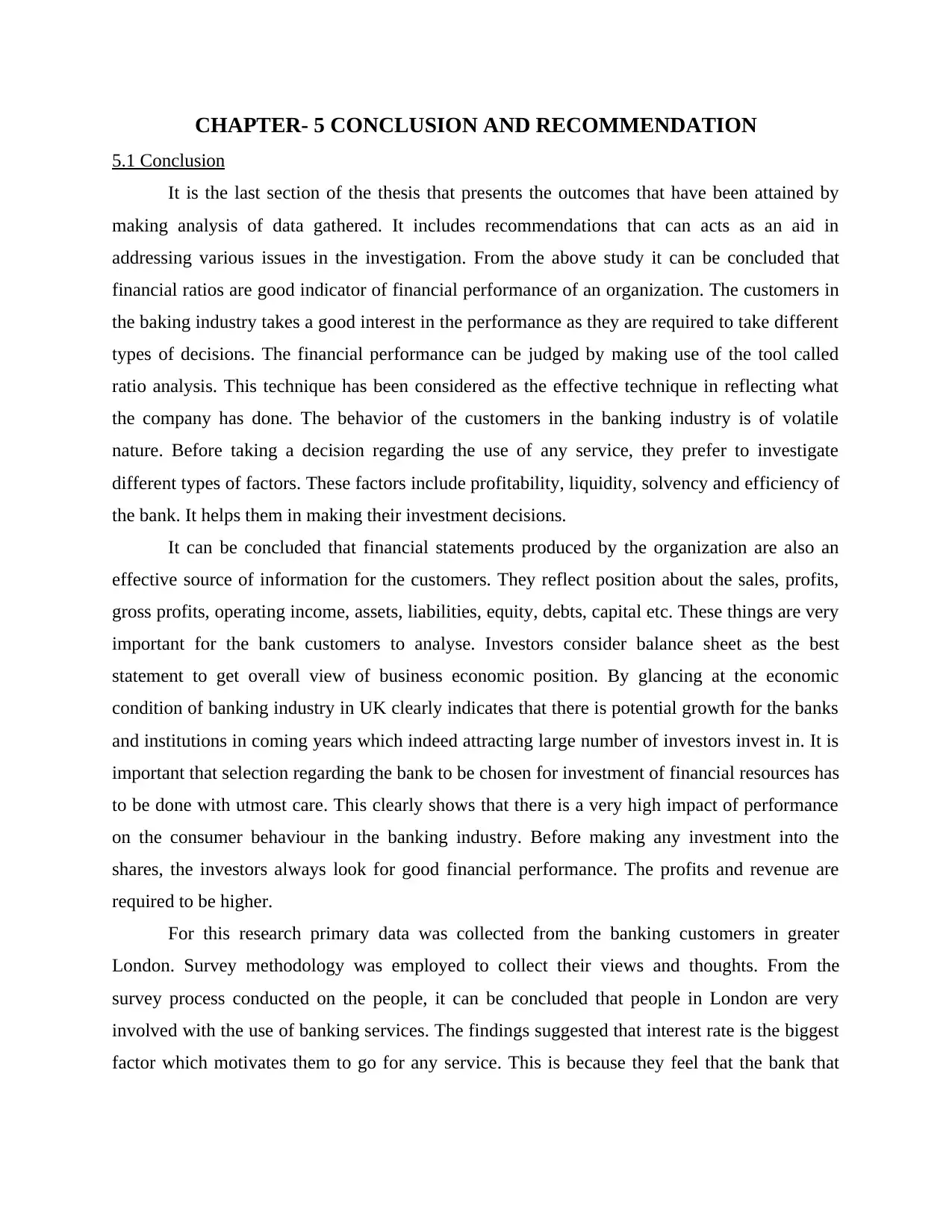
CHAPTER- 5 CONCLUSION AND RECOMMENDATION
5.1 Conclusion
It is the last section of the thesis that presents the outcomes that have been attained by
making analysis of data gathered. It includes recommendations that can acts as an aid in
addressing various issues in the investigation. From the above study it can be concluded that
financial ratios are good indicator of financial performance of an organization. The customers in
the baking industry takes a good interest in the performance as they are required to take different
types of decisions. The financial performance can be judged by making use of the tool called
ratio analysis. This technique has been considered as the effective technique in reflecting what
the company has done. The behavior of the customers in the banking industry is of volatile
nature. Before taking a decision regarding the use of any service, they prefer to investigate
different types of factors. These factors include profitability, liquidity, solvency and efficiency of
the bank. It helps them in making their investment decisions.
It can be concluded that financial statements produced by the organization are also an
effective source of information for the customers. They reflect position about the sales, profits,
gross profits, operating income, assets, liabilities, equity, debts, capital etc. These things are very
important for the bank customers to analyse. Investors consider balance sheet as the best
statement to get overall view of business economic position. By glancing at the economic
condition of banking industry in UK clearly indicates that there is potential growth for the banks
and institutions in coming years which indeed attracting large number of investors invest in. It is
important that selection regarding the bank to be chosen for investment of financial resources has
to be done with utmost care. This clearly shows that there is a very high impact of performance
on the consumer behaviour in the banking industry. Before making any investment into the
shares, the investors always look for good financial performance. The profits and revenue are
required to be higher.
For this research primary data was collected from the banking customers in greater
London. Survey methodology was employed to collect their views and thoughts. From the
survey process conducted on the people, it can be concluded that people in London are very
involved with the use of banking services. The findings suggested that interest rate is the biggest
factor which motivates them to go for any service. This is because they feel that the bank that
5.1 Conclusion
It is the last section of the thesis that presents the outcomes that have been attained by
making analysis of data gathered. It includes recommendations that can acts as an aid in
addressing various issues in the investigation. From the above study it can be concluded that
financial ratios are good indicator of financial performance of an organization. The customers in
the baking industry takes a good interest in the performance as they are required to take different
types of decisions. The financial performance can be judged by making use of the tool called
ratio analysis. This technique has been considered as the effective technique in reflecting what
the company has done. The behavior of the customers in the banking industry is of volatile
nature. Before taking a decision regarding the use of any service, they prefer to investigate
different types of factors. These factors include profitability, liquidity, solvency and efficiency of
the bank. It helps them in making their investment decisions.
It can be concluded that financial statements produced by the organization are also an
effective source of information for the customers. They reflect position about the sales, profits,
gross profits, operating income, assets, liabilities, equity, debts, capital etc. These things are very
important for the bank customers to analyse. Investors consider balance sheet as the best
statement to get overall view of business economic position. By glancing at the economic
condition of banking industry in UK clearly indicates that there is potential growth for the banks
and institutions in coming years which indeed attracting large number of investors invest in. It is
important that selection regarding the bank to be chosen for investment of financial resources has
to be done with utmost care. This clearly shows that there is a very high impact of performance
on the consumer behaviour in the banking industry. Before making any investment into the
shares, the investors always look for good financial performance. The profits and revenue are
required to be higher.
For this research primary data was collected from the banking customers in greater
London. Survey methodology was employed to collect their views and thoughts. From the
survey process conducted on the people, it can be concluded that people in London are very
involved with the use of banking services. The findings suggested that interest rate is the biggest
factor which motivates them to go for any service. This is because they feel that the bank that
Paraphrase This Document
Need a fresh take? Get an instant paraphrase of this document with our AI Paraphraser
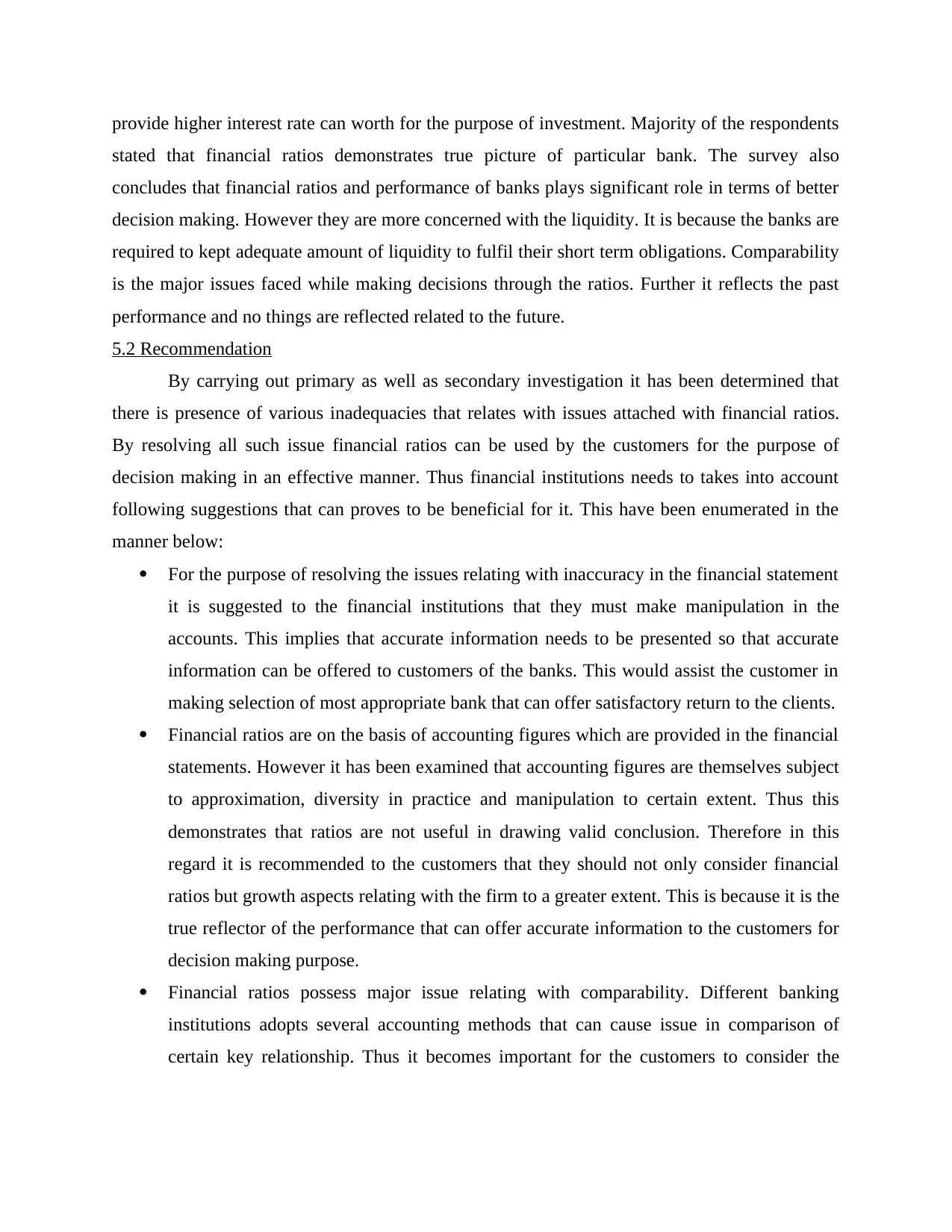
provide higher interest rate can worth for the purpose of investment. Majority of the respondents
stated that financial ratios demonstrates true picture of particular bank. The survey also
concludes that financial ratios and performance of banks plays significant role in terms of better
decision making. However they are more concerned with the liquidity. It is because the banks are
required to kept adequate amount of liquidity to fulfil their short term obligations. Comparability
is the major issues faced while making decisions through the ratios. Further it reflects the past
performance and no things are reflected related to the future.
5.2 Recommendation
By carrying out primary as well as secondary investigation it has been determined that
there is presence of various inadequacies that relates with issues attached with financial ratios.
By resolving all such issue financial ratios can be used by the customers for the purpose of
decision making in an effective manner. Thus financial institutions needs to takes into account
following suggestions that can proves to be beneficial for it. This have been enumerated in the
manner below:
For the purpose of resolving the issues relating with inaccuracy in the financial statement
it is suggested to the financial institutions that they must make manipulation in the
accounts. This implies that accurate information needs to be presented so that accurate
information can be offered to customers of the banks. This would assist the customer in
making selection of most appropriate bank that can offer satisfactory return to the clients.
Financial ratios are on the basis of accounting figures which are provided in the financial
statements. However it has been examined that accounting figures are themselves subject
to approximation, diversity in practice and manipulation to certain extent. Thus this
demonstrates that ratios are not useful in drawing valid conclusion. Therefore in this
regard it is recommended to the customers that they should not only consider financial
ratios but growth aspects relating with the firm to a greater extent. This is because it is the
true reflector of the performance that can offer accurate information to the customers for
decision making purpose.
Financial ratios possess major issue relating with comparability. Different banking
institutions adopts several accounting methods that can cause issue in comparison of
certain key relationship. Thus it becomes important for the customers to consider the
stated that financial ratios demonstrates true picture of particular bank. The survey also
concludes that financial ratios and performance of banks plays significant role in terms of better
decision making. However they are more concerned with the liquidity. It is because the banks are
required to kept adequate amount of liquidity to fulfil their short term obligations. Comparability
is the major issues faced while making decisions through the ratios. Further it reflects the past
performance and no things are reflected related to the future.
5.2 Recommendation
By carrying out primary as well as secondary investigation it has been determined that
there is presence of various inadequacies that relates with issues attached with financial ratios.
By resolving all such issue financial ratios can be used by the customers for the purpose of
decision making in an effective manner. Thus financial institutions needs to takes into account
following suggestions that can proves to be beneficial for it. This have been enumerated in the
manner below:
For the purpose of resolving the issues relating with inaccuracy in the financial statement
it is suggested to the financial institutions that they must make manipulation in the
accounts. This implies that accurate information needs to be presented so that accurate
information can be offered to customers of the banks. This would assist the customer in
making selection of most appropriate bank that can offer satisfactory return to the clients.
Financial ratios are on the basis of accounting figures which are provided in the financial
statements. However it has been examined that accounting figures are themselves subject
to approximation, diversity in practice and manipulation to certain extent. Thus this
demonstrates that ratios are not useful in drawing valid conclusion. Therefore in this
regard it is recommended to the customers that they should not only consider financial
ratios but growth aspects relating with the firm to a greater extent. This is because it is the
true reflector of the performance that can offer accurate information to the customers for
decision making purpose.
Financial ratios possess major issue relating with comparability. Different banking
institutions adopts several accounting methods that can cause issue in comparison of
certain key relationship. Thus it becomes important for the customers to consider the
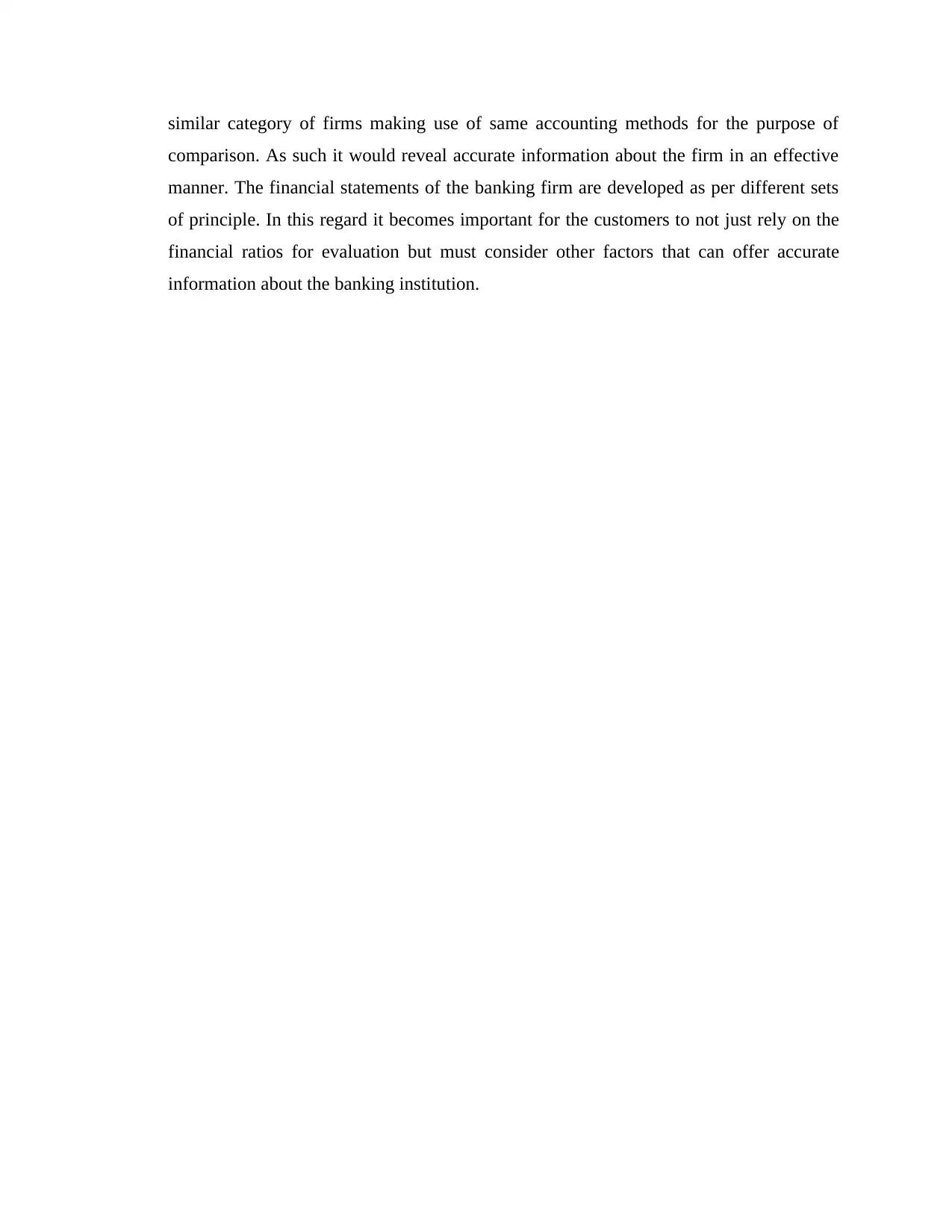
similar category of firms making use of same accounting methods for the purpose of
comparison. As such it would reveal accurate information about the firm in an effective
manner. The financial statements of the banking firm are developed as per different sets
of principle. In this regard it becomes important for the customers to not just rely on the
financial ratios for evaluation but must consider other factors that can offer accurate
information about the banking institution.
comparison. As such it would reveal accurate information about the firm in an effective
manner. The financial statements of the banking firm are developed as per different sets
of principle. In this regard it becomes important for the customers to not just rely on the
financial ratios for evaluation but must consider other factors that can offer accurate
information about the banking institution.
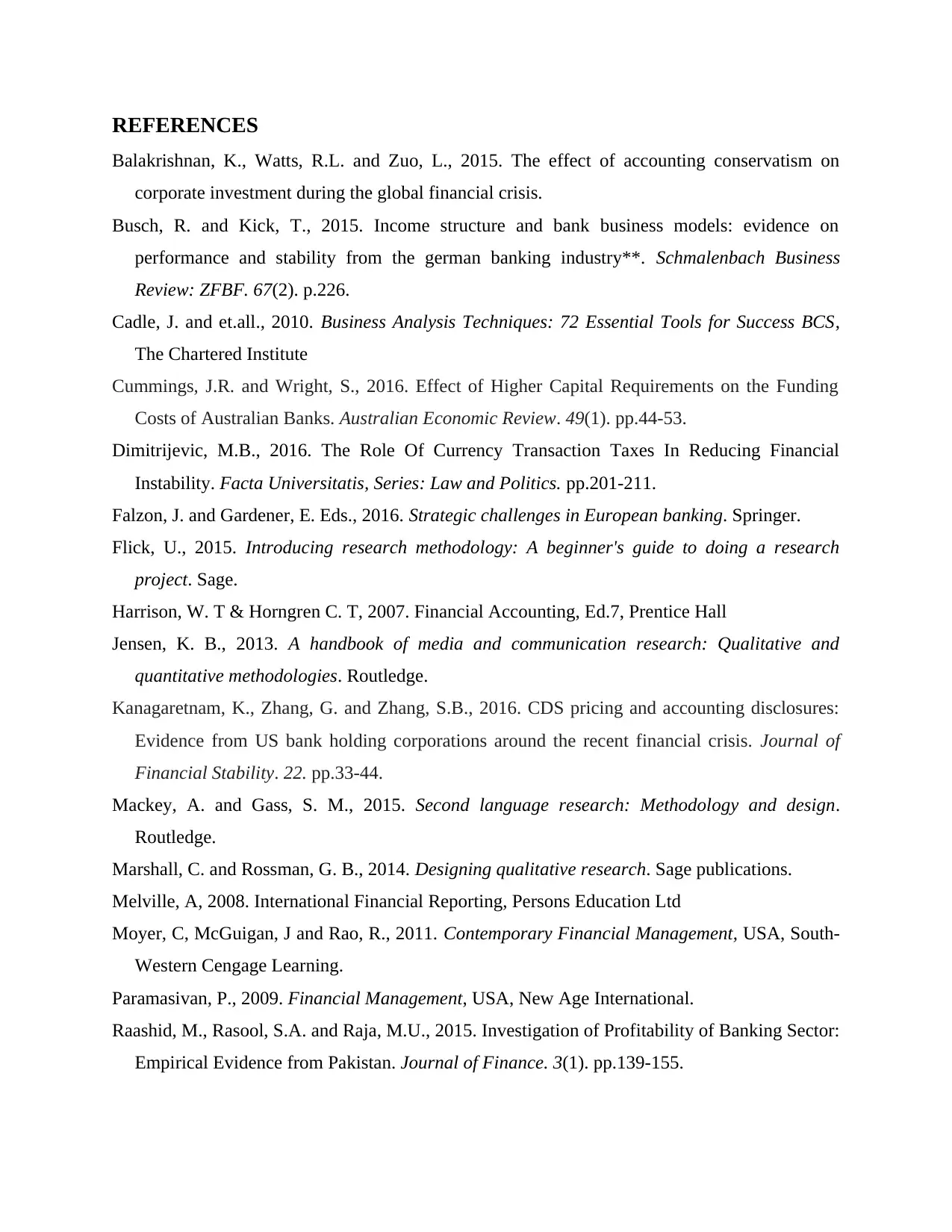
REFERENCES
Balakrishnan, K., Watts, R.L. and Zuo, L., 2015. The effect of accounting conservatism on
corporate investment during the global financial crisis.
Busch, R. and Kick, T., 2015. Income structure and bank business models: evidence on
performance and stability from the german banking industry**. Schmalenbach Business
Review: ZFBF. 67(2). p.226.
Cadle, J. and et.all., 2010. Business Analysis Techniques: 72 Essential Tools for Success BCS,
The Chartered Institute
Cummings, J.R. and Wright, S., 2016. Effect of Higher Capital Requirements on the Funding
Costs of Australian Banks. Australian Economic Review. 49(1). pp.44-53.
Dimitrijevic, M.B., 2016. The Role Of Currency Transaction Taxes In Reducing Financial
Instability. Facta Universitatis, Series: Law and Politics. pp.201-211.
Falzon, J. and Gardener, E. Eds., 2016. Strategic challenges in European banking. Springer.
Flick, U., 2015. Introducing research methodology: A beginner's guide to doing a research
project. Sage.
Harrison, W. T & Horngren C. T, 2007. Financial Accounting, Ed.7, Prentice Hall
Jensen, K. B., 2013. A handbook of media and communication research: Qualitative and
quantitative methodologies. Routledge.
Kanagaretnam, K., Zhang, G. and Zhang, S.B., 2016. CDS pricing and accounting disclosures:
Evidence from US bank holding corporations around the recent financial crisis. Journal of
Financial Stability. 22. pp.33-44.
Mackey, A. and Gass, S. M., 2015. Second language research: Methodology and design.
Routledge.
Marshall, C. and Rossman, G. B., 2014. Designing qualitative research. Sage publications.
Melville, A, 2008. International Financial Reporting, Persons Education Ltd
Moyer, C, McGuigan, J and Rao, R., 2011. Contemporary Financial Management, USA, South-
Western Cengage Learning.
Paramasivan, P., 2009. Financial Management, USA, New Age International.
Raashid, M., Rasool, S.A. and Raja, M.U., 2015. Investigation of Profitability of Banking Sector:
Empirical Evidence from Pakistan. Journal of Finance. 3(1). pp.139-155.
Balakrishnan, K., Watts, R.L. and Zuo, L., 2015. The effect of accounting conservatism on
corporate investment during the global financial crisis.
Busch, R. and Kick, T., 2015. Income structure and bank business models: evidence on
performance and stability from the german banking industry**. Schmalenbach Business
Review: ZFBF. 67(2). p.226.
Cadle, J. and et.all., 2010. Business Analysis Techniques: 72 Essential Tools for Success BCS,
The Chartered Institute
Cummings, J.R. and Wright, S., 2016. Effect of Higher Capital Requirements on the Funding
Costs of Australian Banks. Australian Economic Review. 49(1). pp.44-53.
Dimitrijevic, M.B., 2016. The Role Of Currency Transaction Taxes In Reducing Financial
Instability. Facta Universitatis, Series: Law and Politics. pp.201-211.
Falzon, J. and Gardener, E. Eds., 2016. Strategic challenges in European banking. Springer.
Flick, U., 2015. Introducing research methodology: A beginner's guide to doing a research
project. Sage.
Harrison, W. T & Horngren C. T, 2007. Financial Accounting, Ed.7, Prentice Hall
Jensen, K. B., 2013. A handbook of media and communication research: Qualitative and
quantitative methodologies. Routledge.
Kanagaretnam, K., Zhang, G. and Zhang, S.B., 2016. CDS pricing and accounting disclosures:
Evidence from US bank holding corporations around the recent financial crisis. Journal of
Financial Stability. 22. pp.33-44.
Mackey, A. and Gass, S. M., 2015. Second language research: Methodology and design.
Routledge.
Marshall, C. and Rossman, G. B., 2014. Designing qualitative research. Sage publications.
Melville, A, 2008. International Financial Reporting, Persons Education Ltd
Moyer, C, McGuigan, J and Rao, R., 2011. Contemporary Financial Management, USA, South-
Western Cengage Learning.
Paramasivan, P., 2009. Financial Management, USA, New Age International.
Raashid, M., Rasool, S.A. and Raja, M.U., 2015. Investigation of Profitability of Banking Sector:
Empirical Evidence from Pakistan. Journal of Finance. 3(1). pp.139-155.
Secure Best Marks with AI Grader
Need help grading? Try our AI Grader for instant feedback on your assignments.
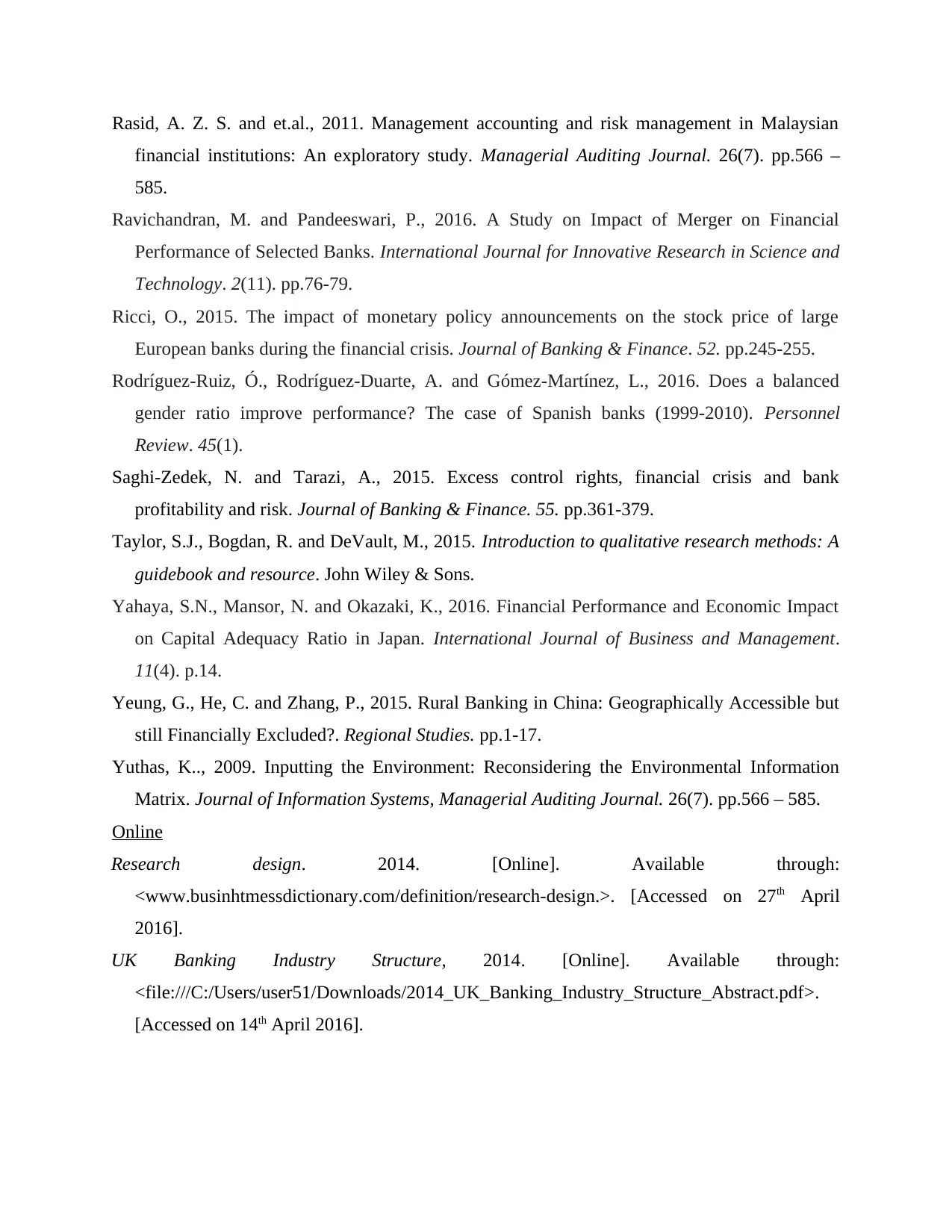
Rasid, A. Z. S. and et.al., 2011. Management accounting and risk management in Malaysian
financial institutions: An exploratory study. Managerial Auditing Journal. 26(7). pp.566 –
585.
Ravichandran, M. and Pandeeswari, P., 2016. A Study on Impact of Merger on Financial
Performance of Selected Banks. International Journal for Innovative Research in Science and
Technology. 2(11). pp.76-79.
Ricci, O., 2015. The impact of monetary policy announcements on the stock price of large
European banks during the financial crisis. Journal of Banking & Finance. 52. pp.245-255.
Rodríguez-Ruiz, Ó., Rodríguez-Duarte, A. and Gómez-Martínez, L., 2016. Does a balanced
gender ratio improve performance? The case of Spanish banks (1999-2010). Personnel
Review. 45(1).
Saghi-Zedek, N. and Tarazi, A., 2015. Excess control rights, financial crisis and bank
profitability and risk. Journal of Banking & Finance. 55. pp.361-379.
Taylor, S.J., Bogdan, R. and DeVault, M., 2015. Introduction to qualitative research methods: A
guidebook and resource. John Wiley & Sons.
Yahaya, S.N., Mansor, N. and Okazaki, K., 2016. Financial Performance and Economic Impact
on Capital Adequacy Ratio in Japan. International Journal of Business and Management.
11(4). p.14.
Yeung, G., He, C. and Zhang, P., 2015. Rural Banking in China: Geographically Accessible but
still Financially Excluded?. Regional Studies. pp.1-17.
Yuthas, K.., 2009. Inputting the Environment: Reconsidering the Environmental Information
Matrix. Journal of Information Systems, Managerial Auditing Journal. 26(7). pp.566 – 585.
Online
Research design. 2014. [Online]. Available through:
<www.businhtmessdictionary.com/definition/research-design.>. [Accessed on 27th April
2016].
UK Banking Industry Structure, 2014. [Online]. Available through:
<file:///C:/Users/user51/Downloads/2014_UK_Banking_Industry_Structure_Abstract.pdf>.
[Accessed on 14th April 2016].
financial institutions: An exploratory study. Managerial Auditing Journal. 26(7). pp.566 –
585.
Ravichandran, M. and Pandeeswari, P., 2016. A Study on Impact of Merger on Financial
Performance of Selected Banks. International Journal for Innovative Research in Science and
Technology. 2(11). pp.76-79.
Ricci, O., 2015. The impact of monetary policy announcements on the stock price of large
European banks during the financial crisis. Journal of Banking & Finance. 52. pp.245-255.
Rodríguez-Ruiz, Ó., Rodríguez-Duarte, A. and Gómez-Martínez, L., 2016. Does a balanced
gender ratio improve performance? The case of Spanish banks (1999-2010). Personnel
Review. 45(1).
Saghi-Zedek, N. and Tarazi, A., 2015. Excess control rights, financial crisis and bank
profitability and risk. Journal of Banking & Finance. 55. pp.361-379.
Taylor, S.J., Bogdan, R. and DeVault, M., 2015. Introduction to qualitative research methods: A
guidebook and resource. John Wiley & Sons.
Yahaya, S.N., Mansor, N. and Okazaki, K., 2016. Financial Performance and Economic Impact
on Capital Adequacy Ratio in Japan. International Journal of Business and Management.
11(4). p.14.
Yeung, G., He, C. and Zhang, P., 2015. Rural Banking in China: Geographically Accessible but
still Financially Excluded?. Regional Studies. pp.1-17.
Yuthas, K.., 2009. Inputting the Environment: Reconsidering the Environmental Information
Matrix. Journal of Information Systems, Managerial Auditing Journal. 26(7). pp.566 – 585.
Online
Research design. 2014. [Online]. Available through:
<www.businhtmessdictionary.com/definition/research-design.>. [Accessed on 27th April
2016].
UK Banking Industry Structure, 2014. [Online]. Available through:
<file:///C:/Users/user51/Downloads/2014_UK_Banking_Industry_Structure_Abstract.pdf>.
[Accessed on 14th April 2016].

APPENDIX
QUESTIONNAIRE
For customers of Greater London
(Kindly take few minutes to provide your responses. Your feedback is appreciated.)
Demographic information
Name:
Age:
Gender:
Male □
Female □
1. From how long you have been using banking facilities?
Less than 10 year □
10-15 years □
Above 15 years □
2. What are the factors that persuades you towards the selection of particular bank?
Convenience and excellence □
Interest rate □
Workforce within bank □
Physical environment of bank □
3. From among the following which financial institution is being preferred by you?
HSBC □
Lloyds banking group □
Barclays □
Standard chartered □
Specify, if other _________
4. What is your level of agreement with the view that financial ratios demonstrates true picture of
particular bank?
Strongly disagree □
Disagree □
Neutral □
QUESTIONNAIRE
For customers of Greater London
(Kindly take few minutes to provide your responses. Your feedback is appreciated.)
Demographic information
Name:
Age:
Gender:
Male □
Female □
1. From how long you have been using banking facilities?
Less than 10 year □
10-15 years □
Above 15 years □
2. What are the factors that persuades you towards the selection of particular bank?
Convenience and excellence □
Interest rate □
Workforce within bank □
Physical environment of bank □
3. From among the following which financial institution is being preferred by you?
HSBC □
Lloyds banking group □
Barclays □
Standard chartered □
Specify, if other _________
4. What is your level of agreement with the view that financial ratios demonstrates true picture of
particular bank?
Strongly disagree □
Disagree □
Neutral □

Agree □
Strongly agree □
5. Which amongst the following ratio according to you is effective in providing accurate
information?
Profitability □
Liquidity □
Solvency □
Efficiency □
6. Do you think financial indicators are suitable means for decision making purpose?
Yes □
No □
7. Do you think financial ratios are effective in influencing your decision towards investment?
Strongly disagree □
Disagree □
Neutral □
Agree □
Strongly agree □
8. What is your level of agreement with the view that financial ratios and performance of banks
plays significant role in terms of better decision making for you?
Strongly disagree □
Disagree □
Neutral □
Agree □
Strongly agree □
9. Which types of financial data is gathered by you through financial ratios?
Financial conditions □
Operating results □
Cash flows □
Shareholders equity □
10. Do you think manipulation in accounts of particular bank affects your decision making?
Strongly agree □
5. Which amongst the following ratio according to you is effective in providing accurate
information?
Profitability □
Liquidity □
Solvency □
Efficiency □
6. Do you think financial indicators are suitable means for decision making purpose?
Yes □
No □
7. Do you think financial ratios are effective in influencing your decision towards investment?
Strongly disagree □
Disagree □
Neutral □
Agree □
Strongly agree □
8. What is your level of agreement with the view that financial ratios and performance of banks
plays significant role in terms of better decision making for you?
Strongly disagree □
Disagree □
Neutral □
Agree □
Strongly agree □
9. Which types of financial data is gathered by you through financial ratios?
Financial conditions □
Operating results □
Cash flows □
Shareholders equity □
10. Do you think manipulation in accounts of particular bank affects your decision making?
Paraphrase This Document
Need a fresh take? Get an instant paraphrase of this document with our AI Paraphraser

Yes □
No □
11. Do you agree that financial ratios are effective tool for judging the performance of a bank?
Strongly disagree □
Disagree □
Neutral □
Agree □
Strongly agree □
12. Which factor would you like to examine while selecting a particular service of a bank?
Profitability □
Liquidity □
Solvency □
Efficiency □
13. What are the major issues faced by you while making decisions through financial ratios?
Historical □
Inflation □
Difference in methods of computation □
Comparability □
14. Recommend the ways in which presentation of financial information can be improved by
banking firms?
______________________________________________________________________________
____________________________________________________________________________
15. Suggest the additional information required by you that can support decision making done by
you?
______________________________________________________________________________
____________________________________________________________________________
No □
11. Do you agree that financial ratios are effective tool for judging the performance of a bank?
Strongly disagree □
Disagree □
Neutral □
Agree □
Strongly agree □
12. Which factor would you like to examine while selecting a particular service of a bank?
Profitability □
Liquidity □
Solvency □
Efficiency □
13. What are the major issues faced by you while making decisions through financial ratios?
Historical □
Inflation □
Difference in methods of computation □
Comparability □
14. Recommend the ways in which presentation of financial information can be improved by
banking firms?
______________________________________________________________________________
____________________________________________________________________________
15. Suggest the additional information required by you that can support decision making done by
you?
______________________________________________________________________________
____________________________________________________________________________

1 out of 45
Related Documents
Your All-in-One AI-Powered Toolkit for Academic Success.
+13062052269
info@desklib.com
Available 24*7 on WhatsApp / Email
![[object Object]](/_next/static/media/star-bottom.7253800d.svg)
Unlock your academic potential
© 2024 | Zucol Services PVT LTD | All rights reserved.





